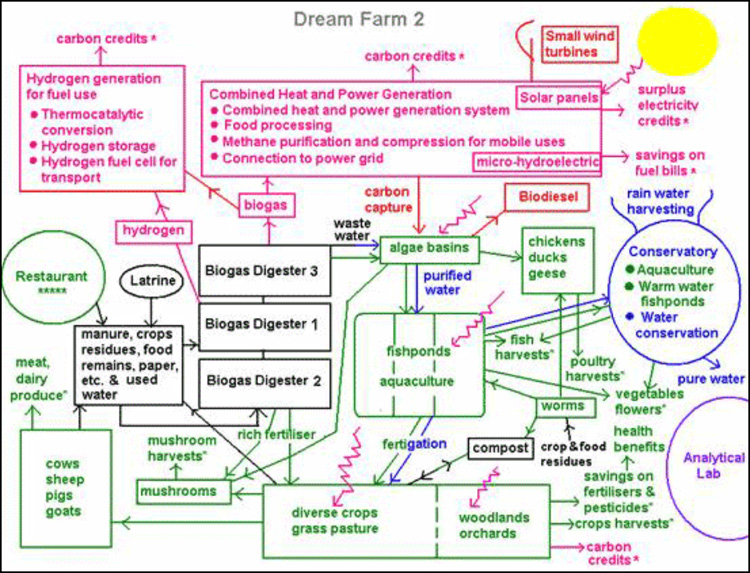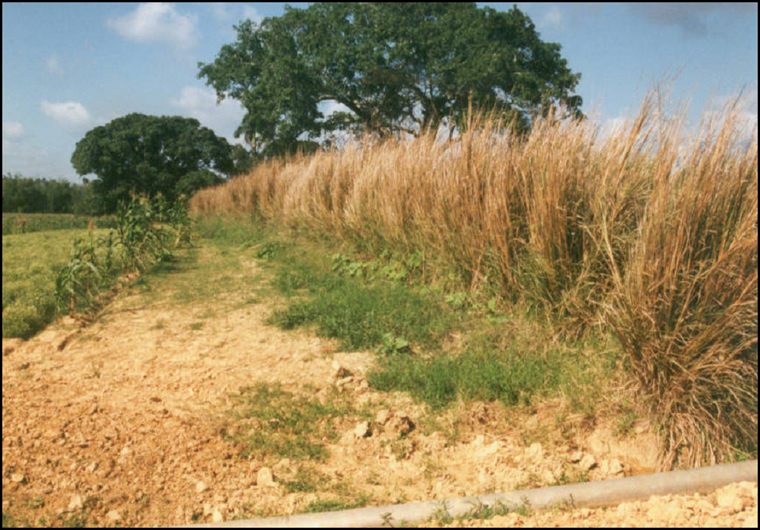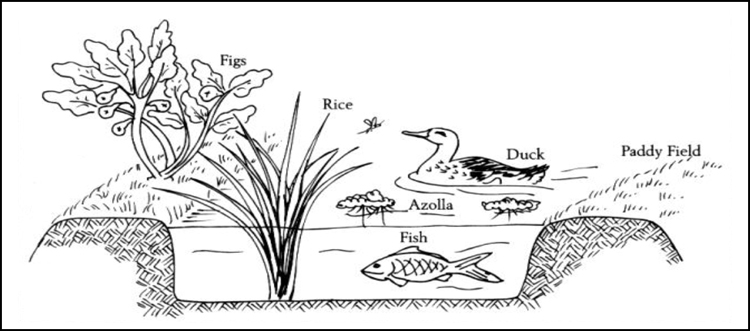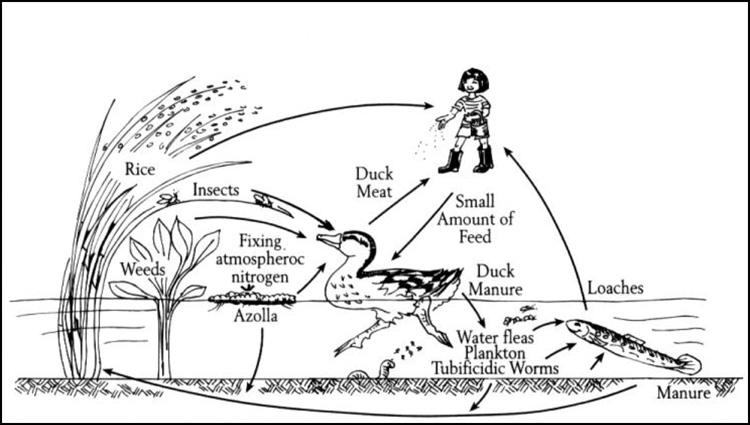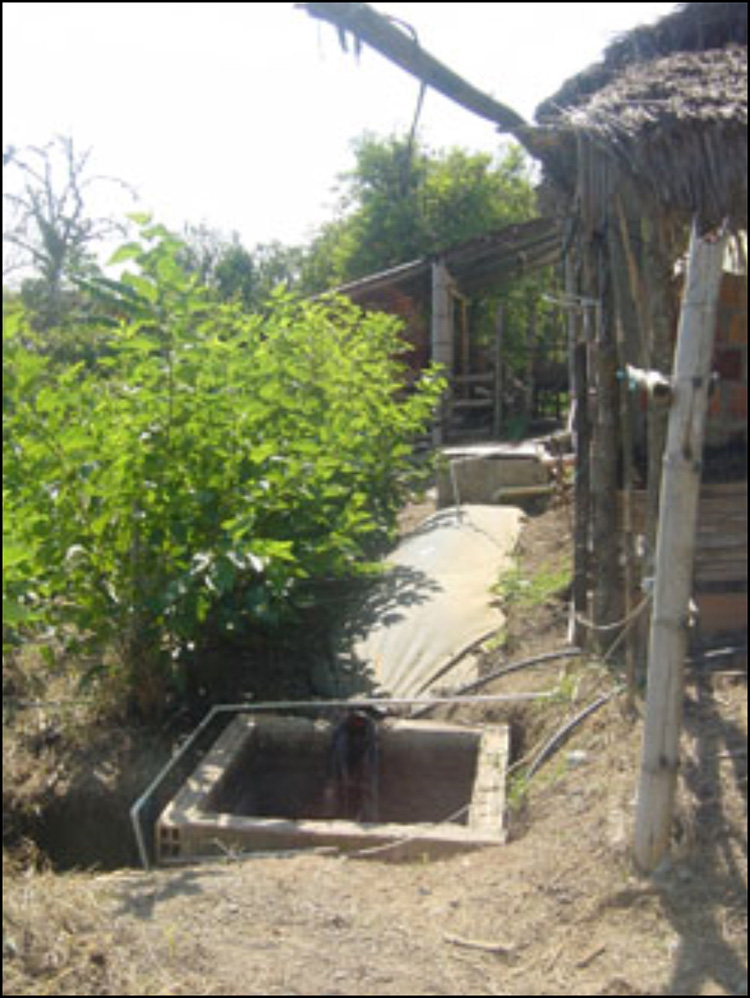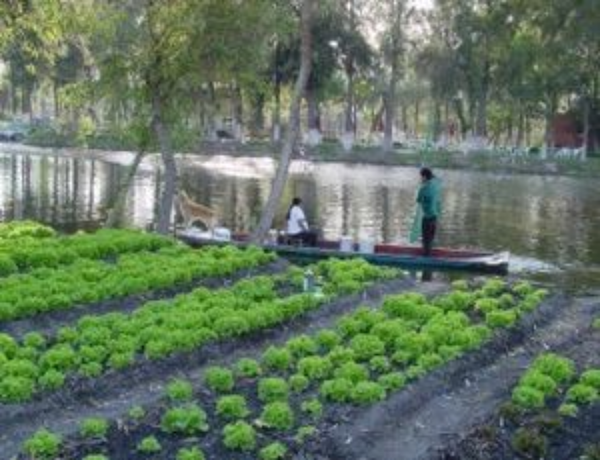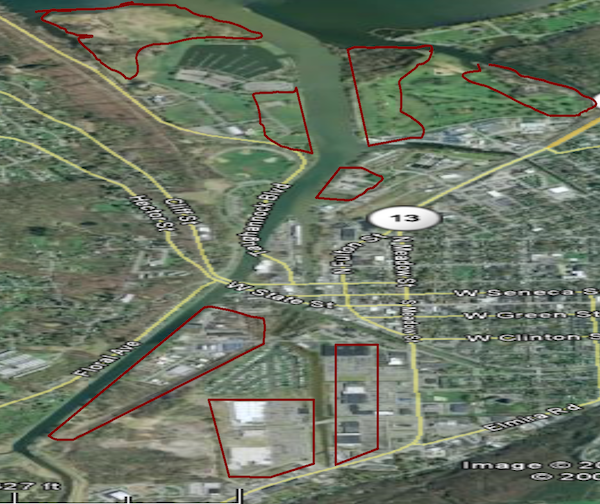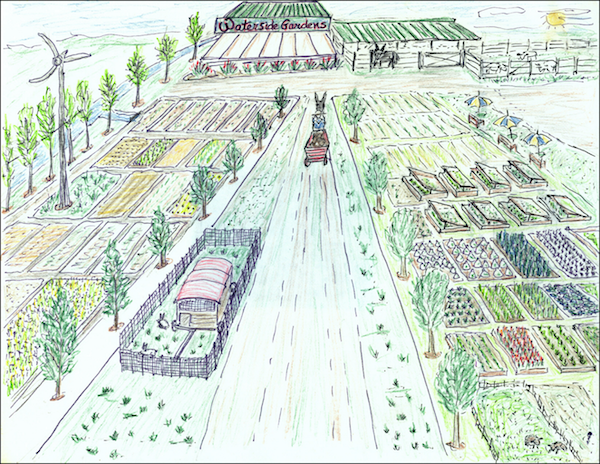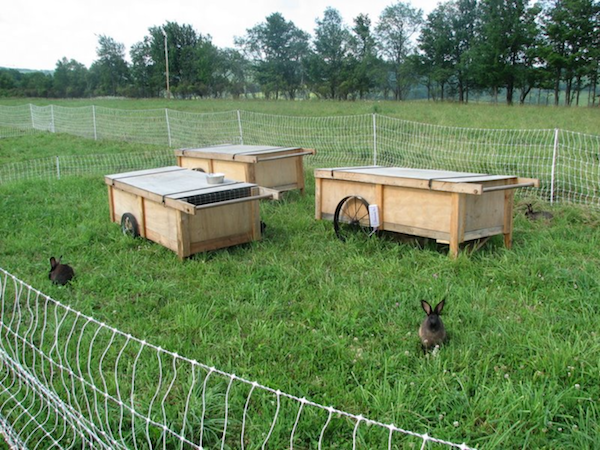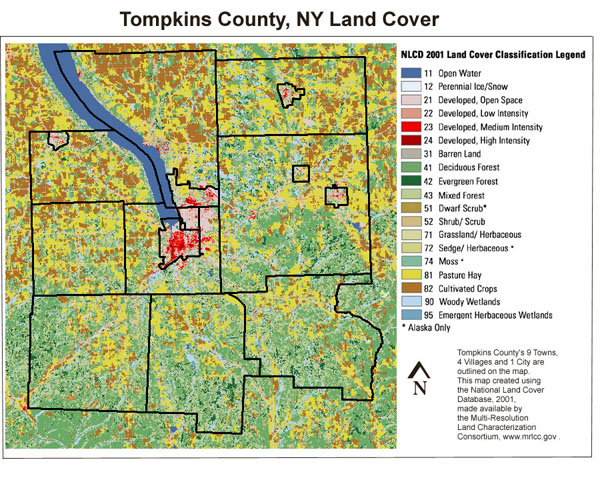Recently in agriculture Category
By Karl North
The vulnerability of cities and suburbs in the post-petroleum era has been the object of much debate because their present organization makes their operation so energy-intensive. The debate heretofore has tended to swing between two extremes. One claims that these forms of social organization on the land are so unsustainable that their populations will be forced to abandon them gradually as the energy descent progresses.[1]
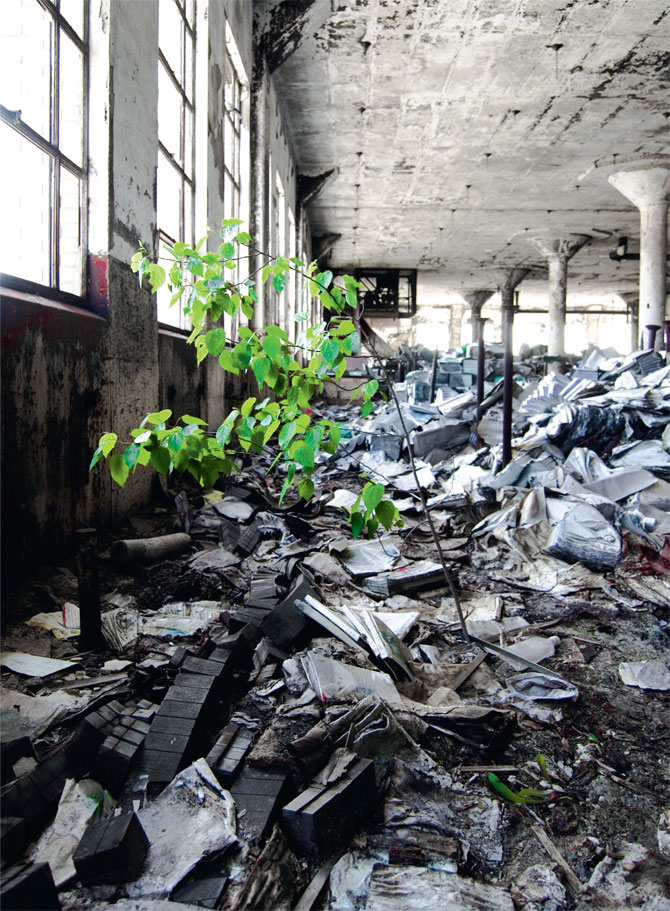
Figure 1. A tree grows in Detroit
(photo by James Griffioen, vice.com)
James Kunstler, a well-known critic of the kind of cities and suburbs that have emerged in recent decades, puts it bluntly:
The whole suburban project I think can be summarized pretty succinctly as the greatest misallocation of resources in the history of the world. America took all of its post-war wealth and invested it in a living arrangement that has no future.[2]
The other extreme entertains dreams of massive programs of public transportation to save suburbia. It also relies heavily on technologies like high-rise agriculture and on the efficiencies of population density to save cities. This is the vision of the eco-cities movement.
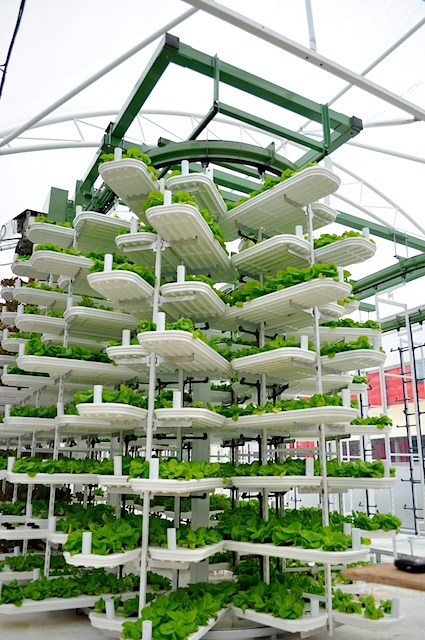
Figure 2. Techno-fantasy unchained
(Time magazine via City Farmer News)
Neither of these scenarios makes much sense. The abandonment thesis ignores the immense accumulated wealth of the built environment in metropolitan areas, which is not likely to be left to fall apart, but will more likely support a certain level of human population if salvaged for other uses than it was originally designed for.[3] It is conceivable that modern society will be reduced to energy inputs available in 1800, before much use of fossil fuels. But that would not mean a simple return to what life was like in those times, due in part to the bonanza of accessible raw materials that the present built environment represents (a good thing), and in part to two hundred years of accumulated damage to the planetary resource base (not so good) that was unimaginable in 1800.
On the other hand, the claim that technological improvement can keep cities and suburbs functioning in the current ways at current population levels fails for many reasons. First, it perpetuates the above-mentioned accumulation of damage to necessary ecosystemic functions, damage that is intrinsic to “technological improvements,” damage that is already causing exponential growth in the operating costs of metropoles. Then there are the two reasons that the technological savior argument always has failed: there is a limit to the efficiencies that can be delivered by technology, and every technological advance requires an increase in complexity in the socio-economic system, with a resulting increase in consumption of energy and other raw materials in an era of increasing resource scarcity.[4]
Moreover, as genres of social organization and human landscapes, modern cities and suburbs are among the most energy consumptive imaginable because their continued existence relies on a broader agro-industrial base. Most calculations of the energy budgets of metropolitan areas far underestimate because they fail to account for the energy embodied in their construction and maintenance, which includes the vast and often distant agricultural and industrial plant, transport, and communication systems necessary to keep them running. This diagram suggests the scope of the support system required just to keep a metropolitan population in food.
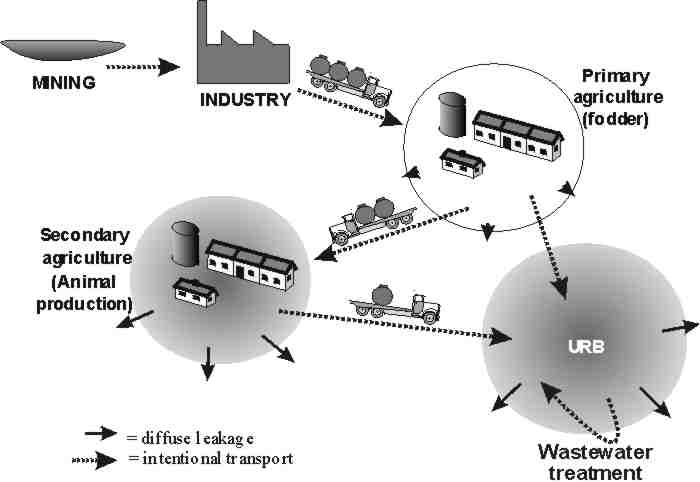
Figure 3. “The linear flow of minerals from mines to farms and then dense human settlements leads to depletion at one end and the concentration of wastes or dispersion into water at the other.” — Jason Bradford (http://www.theoildrum.com/node/5773), graphic by Folke Günther
Of course, cities have existed ever since the advent of agricultural systems capable of providing the surplus necessary for their growth. But after a period of expansion, often spanning centuries, they have usually destroyed enough of their resource base to cause them to decline. In the last two centuries, cities have grown markedly in size and consumption of resources. But this unprecedented level of urban expansion is entirely reliant on access to fossil energy and other nonrenewable resources that are now becoming permanently more scarce.
The main weakness of the eco-cities movement is its failure to squarely face the increasing scarcity in energy and other resources and seriously consider its implications in the energy descent. Green or new urbanists claim that cities like New York are sustainable because their population density allows a smaller per capita ecological footprint than suburbs.[5] The clustering of populations that the ecocities movement advocates does conserve energy in key areas like building heating and human transport. This clustering will be essential in the energy descent at every scale of human community if we hope to avoid not only the energy costs of most present building configurations and their reliance on a distance economy, but also their misuse of agriculturally valuable land.
But heating and human transport are only one part of the energy cost of operating cities. The green urbanist scenario that compares present cities favorably to present suburbs fails to consider the more comprehensive assessment of many energy descent analysts that no dominant configuration of land use and built environment in the US today, urban, suburban, or rural, is sustainable without fossil fuels. The embodied energy in cities in particular involves upstream energy and material flows along many long production chains, and it requires constant renewal due to entropy (depreciation). Hence embodied energy in cities is commonly three times as high as operational energies like heating and daily human transport.[6]
As a result, the eco-cities movement’s current urban redesigns are characteristically overly complex and overly expensive, and are therefore aimed, like much organically grown food and most present ecovillages, at a gentrified market that will not survive the energy descent. This is not meant to criticize these efforts, but simply to point out that they reflect the economic and cultural choices of a society that has enjoyed cheap energy.
In addition to narrow thinking about the massive inflows of energy and other natural resources that today sustain metropolitan areas, the ecocities movement rarely considers more fundamental questions about urban populations posed by energy descent. In a world where the energy from oil has permitted a tripling of the population and, in rich countries, an average per capita ecological footprint (a measure of resource consumption) so large that it could support 30 African peasants, what is the true carrying capacity? How is the disparity in footprint justified when it reduces the supportable global population? And what is the largest sustainable city when urban population densities are on the order of 67,000 people per square mile[7], and the transportation cost of provisioning such densities from ever-more-distant locations increases with city size beyond the declining energy capacity of the planet?
A More Likely Scenario
A third scenario that I will explore here as more likely than the two considered above envisions a major transformation of both urban and suburban land and resource use to make cities and suburbs habitable in the coming low energy era, although necessarily supporting a much lower population level than they do today. As in all ecosystems, the carrying capacity of these areas will contract to fit the available energy, which sooner or later will be mostly solar.
Carrying capacity (CC) is an essential concept for thinking in scenarios about a future in which access to key resources is declining. Carrying capacity is not just a population level. It is first the level of sustainable resource consumption (SRC) that a particular landscape or resource base can support, which in turn determines the mix of population level and per capita resource consumption or material standard of living. Thus the equation for sustainable resource consumption is
SRC = population × resource consumption per capitawhich makes clear that sustainable carrying capacity in terms of the actual number of people it will support depends on the level of individual consumption:
CC (sustainable population) = SRC ÷ resource consumption per capita
This understanding of carrying capacity raises a concern about present resource consumption. The modern industrial society that urban areas epitomize now relies 80-90% on nonrenewable resources. A society that must return to a resource use rate that rarely uses nonrenewables except as recycled salvage will need to rely mainly on low-input agriculture, aquaculture, and forestry for food and fiber, and similar low-input technologies using renewable and salvageable materials in other areas of production. Hence the inevitability of a return to a relatively low-technology solar energy economy is likely to reduce populations in large metropolitan areas to 10-20% of their current levels.[8] Dispersal from city centers to hinterlands will account for much of the decline. In the end this will be a salutary outcome because it will contribute manpower to the increasingly labor-intensive farming systems that will replace industrial agriculture.
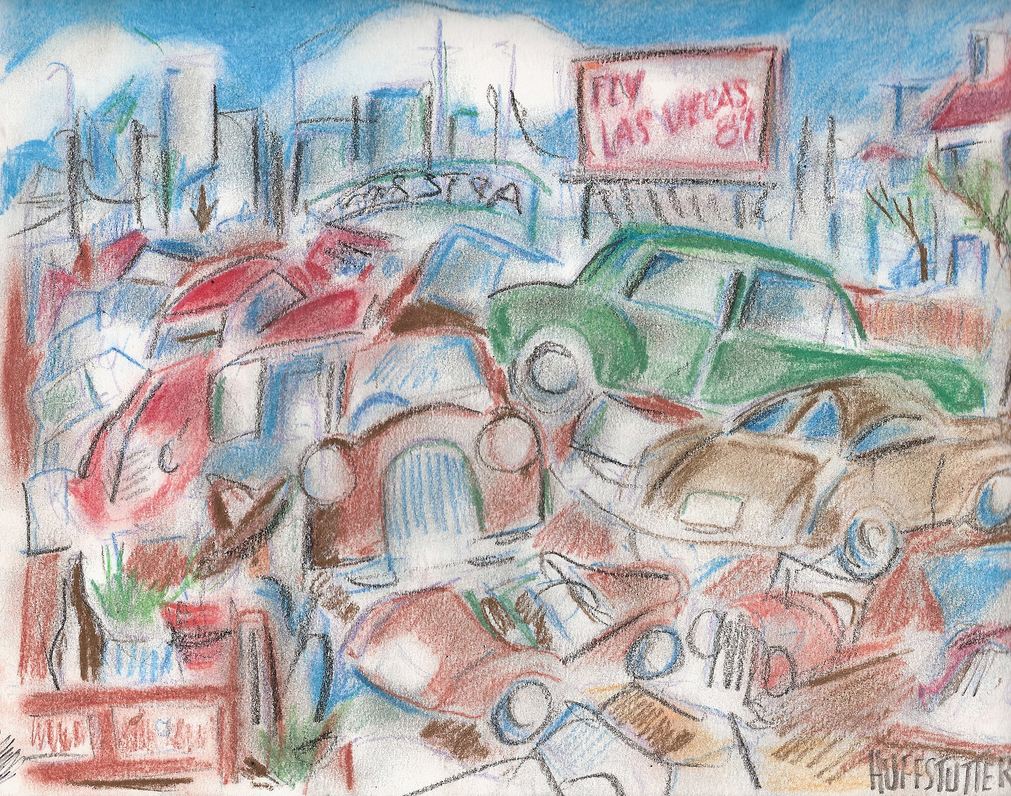
Figure 4. (Pastel by Robert Huffstutter)
How will employment and therefore population shrink in metropolitan areas? The relative concentration of wealth in metropolitan areas has spawned an urban economy that depends heavily on discretionary spending beyond essentials. This part of the economy will tend to shrink first as the energy to support the modern economy becomes scarce.
Also, many people who live in cities and their suburban bedroom communities work in an economy that is parasitic: instead of creating value it simply transfers wealth from one group to another. Much employment in the so-called FIRE sector (finance, insurance, real estate) falls into this category, which also includes much government, advertising, litigation, and lobbying activity — economic sectors that have arisen to exploit our society’s failure to find better ways to perform essential functions. Jobs in this parasitic economy can be expected to disappear early in the energy descent. Many urban clerks in cubicles, data gathering to feed the wealth transfer game, will need to convert to skills that provide life’s basic necessities — food, shelter, basic tools, and services — and for many that will mean leaving the city for farms.
In reality, much of the present urban population will be needed on farms. According to energy descent scientist Richard Heinberg, the de-industrialized agriculture that replaces the current energy-intensive form of food production in the US will require fifty million farmers instead of the present two million.[9] Indeed, there is a growing new farmer movement across the US, served by organizations like Groundswell here in Tompkins County.
The challenge of envisioning a plausible conversion of metropolitan corridors like Bos-Wash to landscapes that are livable sans fossil fuel is to think beyond current models of development or even redevelopment schemes requiring levels of capital investment that a post-petroleum economy cannot afford. The expensive visions of both the green urbanist movement and the nodal cluster suburbanists run aground on this obstacle. Awareness comes slowly because thinking about the upkeep of these structures in the energy descent is often counterintuitive:
Cities overburdened with skyscrapers will soon discover that these structures are liabilities, not assets. The skyscrapers deemed most “innovative” by today’s standards — the ones most dependent on high-tech materials and complex internal systems — will be the greatest failures. This includes many of the new “green buildings.”[10]
An additional hurdle is the current resistance of the denizens of these landscapes to using them differently, but eventually that resistance will melt away as necessity becomes the mother of adaptation.
Throughout their history, metropolitan areas have been centers that have concentrated wealth and power drawn from exploited peripheries. Early in the energy descent they can be expected to use this accumulated advantage to allocate resources disproportionately to themselves and thereby prolong consumption levels and material living standards even as they decline in society as a whole. The maintenance of centralized control that this requires may hinge on something as simple as the ability of security forces, police and military, to fuel their operations on renewables like biodiesel.
Later in the energy descent, however, much of the fuel-intensive economic activity and centralized, hierarchical organization that is the raison d’être of cities and their umbilically connected suburbs will become unaffordable, and the related employment and population will evaporate. The long term budgetary agony of central governing administrations, now well under way, is an early indicator of economic contraction to come. Then human activity will return to a focus on the basic necessities of food and shelter, and economies in these places as elsewhere will self-reorganize around the provision of farming, food systems, and housing that work with minimal fossil fuel. My aim here is to summarize how I think this is likely to happen. The key element in my scenario is the liberation of the built environment and its rearrangement for other uses, a change made possible by the contracting economy and population of metropolitan areas that I have described as inevitable over time in the energy descent. Finally, I will suggest how this scenario might play out in Ithaca, New York and its hinterland, and by extension, in other small cities and towns.
The Post-Petroleum Metropole
Cities located on waterways will remain centers of some distant trade as they have for centuries. On the downside, rising water levels could eventually reduce habitable areas in seaport cities. But for a while as cities and suburbs shrink and depopulate, urban activity will center on salvage of the built environment. As many parts of the built environment are abandoned, we can expect their materials and land to be reclaimed for structures and spaces for growing food and for makeovers of housing and other structures to the level of energy efficiency required by the new economy. Because the return to a solar energy economy will support only a limited population, most land and buildings will stand empty and provide a broad inventory of materials or, once cleared, space for gardens. It is hard to imagine conversion of places like the canyons of south Manhattan to either appropriate housing or food production, so some city zones may remain abandoned except for salvage activities. At the end of Apartheid in South Africa, for example, white businesses left the high-rise section of Johannesburg. The squatters who replaced them could not afford the energy needed to maintain the buildings, and they gradually fell apart.[11] As urban areas everywhere experience a similar drop in energy use, urbanites will abandon energy-intensive structures. Hence a degree of decentralization will occur as urban areas devolve into compact, semi-self-sufficient neighborhood communities separated by empty salvage-yard commons.
The same process will occur in the suburbs, where abandoned residential and commercial structures will serve as stores of materials for low-cost conversion of residential housing for the remaining population. Land to farm will be plentiful, but a main problem will be to end the inefficiencies of suburban sprawl and reconfigure this landscape into the kind of demographically dense agrarian villages that have proved sustainable for centuries. The affordable solution will be to move salvaged building materials or whole abandoned structures into clusters at these central locations. This will recreate at low energy cost the nodal demographic topography that historically has been chosen as the most efficient mode of spatial organization of rural communities the world over.[12] Thus in the long reach of history the extravagance we call suburbia will prove to be a temporary phenomenon.
Once the suburban topography is reformed into economically efficient agrarian communities, some of these villages have the potential to create a thriving trade in surplus food production with the nearest city nodes, which in turn have a surplus of salvage inventory for which they can exchange materials, and products handcrafted from them, and exchange seasonal labor as well. In other words, city and suburb will convert to symbiotic economies that bear some similarity to what they were before the oil age. In the New York metropolitan area, for example, New Jersey (the Garden State!), Long Island, coastal Connecticut, and the Hudson Valley — the city’s former breadbaskets — will regain that function. As the distance economy that cities once depended on becomes too costly, the ability of the near suburbs to convert from bedroom communities to beehives of food production may well determine the size of the population that can remain in the city.
Solarized Housing
In cool climates like the Northeast US, people will be forced to rebuild housing to maximize solar heat and minimize biomass burning, as biomass will regain its traditional role as the key strategic resource and will experience renewed demand for many uses. Here again the expensive models of residential energy efficiency popular today in the green building movement are impediments to visioning. For most of the population the only conversion option will be to use scavenged materials and hand labor, both of which will be plentiful, and in fact all that is necessary to build highly effective passive solar systems for heating both living spaces and water.
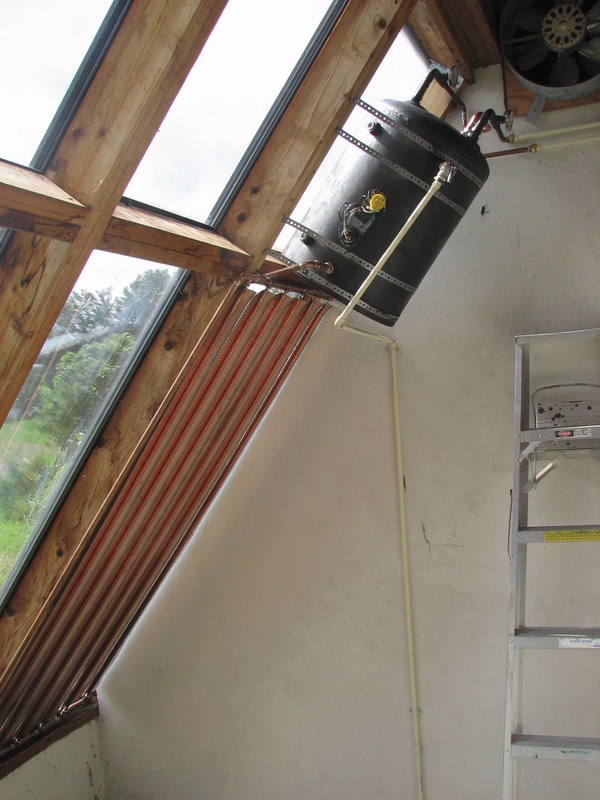
Figure 5. Solar hot water in attached solar greenhouse
To solarize a residence or other building that needs to be heated for all-season use, urbanites will raze city structures that block it from full southern exposure and will use their insulation, glass, masonry, and plumbing hardware to convert it to reliance mostly on the sun for heat and hot water. Widespread conversion will occur when the massive city and suburban built environment inventory becomes available for salvage, because this type of solarization requires no expensive technology or skills beyond elementary carpentry and plumbing. Enough business buildings to support the shrunken economy will be converted in the same way. Gradually buildings made of wood, with their short turnover time of a few decades, will give way to more durable masonry salvaged from unusable structures. The masonry will perform the added function of furnishing the thermal mass to store solar energy required by passive solar heating systems.
Food Production Systems
Like most current alternative architectural models, most organic agriculture grew in the age of cheap oil and takes for granted many of its luxuries. Food production everywhere will eventually adapt much more closely to farming in nature’s image. Like natural ecosystems, farms will have to be largely self-sufficient in inputs, including a lot of human and animal labor and relatively simple machines and tools.
City food production will reach limits, making city populations dependent on the development of farming in the hinterlands that had been suburbs. Once most empty urban spaces are used for farming, space will be a limiting factor on urban growing because demolition and removal of buildings in the energy descent will be very labor intensive. Another limiting factor will be lack of space to “grow” fertility either as green manure or manure from pastured livestock. This need for fertilizer could motivate a return to transport within the metropole using animals fed from fields outside cities, animals like those whose manure supported urban food production until well into the industrial era. In many metropolitan locations, efficient steel-on-steel rail transportation systems work as well with animal power as with energy derived from fossil fuels, just as they did for decades before and after the turn of the twentieth century. An effective policy would prioritize remaining fossil energy for the reconstruction of the rails and the rolling stock and run the latter on animal power.
A distinct advantage of farming in cities and suburbs will be the many existing structures that can be converted to solar greenhouses to furnish the heat to perform and enhance essential services in the new food system: intensive all-season growing, vermicomposting, food conservation by solar drying, and even solar cooking. Husbandry of small livestock like poultry and rabbits also will benefit from solar greenhousing. Like the solarized human housing described above, these structures will be low-cost conversions that require little skill beyond an understanding of passive solar concepts.
Implications for Tompkins County
Whatever its previous form of habitation and land use — city, suburb or rural — the most effective form of reorganization of communities everywhere will be small, dense, and mixed-use, to make the most of the traditional advantages of a convergence of many hands with diverse talents in a world made more by hand and constrained mostly to local self-reliance.
However, the size of an urban agglomeration will affect how easily the scenario that I have described will occur. Bamako, in 1962 a city of 100,000 in the heart of West Africa, seemed to manage well on relatively little fossil energy, as most of its population still cast a small carbon footprint. But Havana, with a population ten times that of Bamako, was suffering visibly despite massive compensatory government programs when I observed it during visits in the 1990s, six years into its peak oil experience (Cuba endured an 80% decline in energy and related inputs).
The larger the metropolitan area, the more population shrinkage it is likely to experience, and the greater the tendency for the city proper, like the suburbs, to break up and reorganize into compact, walkable, semi-self-sufficient communities. Cities as small as Ithaca will undergo much of the repurposing of land use and built environment described above, but the changes will be less extreme. Most of the downtown area is already walkable, and a low-input public transportation system is conceivable that would link neighborhood clusters to each other and to a rural periphery that is relatively nearby.
Like many cities on waterways, Ithaca will benefit from a potential lakeside trading area that low-input water transportation offers. The lake provides a link to a large swath of farmland that might support more of the current urban and suburban population in Ithaca than in landlocked cities. Hence waterfronts in the city and county will regain importance as points of departure in a revived system of waterborne commerce. In an era of scarce, depleted resources, this waterfront renaissance will need to occur mostly with salvaged or renewable materials.
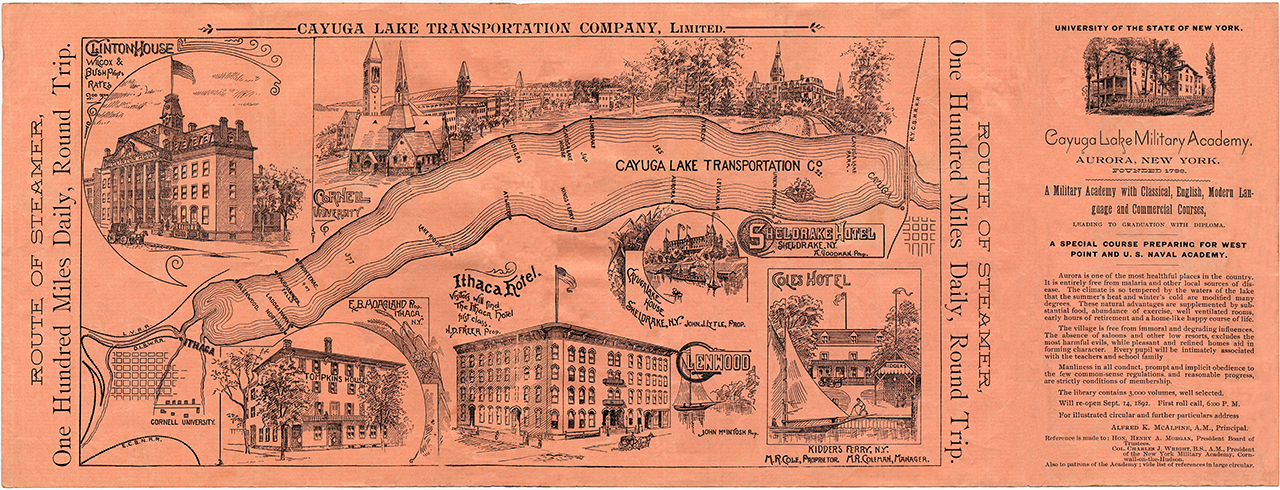
Figure 6. An advertisement for the Cayuga Lake Transportation Company, ca. 1892. The steamer served the same communities around Cayuga Lake that are served by state routes 34, 34B, 90, and 89 today. A high-resolution version of this figure can be downloaded from http://freepages.genealogy.rootsweb.ancestry.com/~springport/pictures75/7548cleaned2sharp.jpg (use “Save link as” to download before attempting to view)
The emergence of dense agrarian feeder hamlets along transportation lines mentioned in my Visioning County Food Production series[13] is more likely to proceed as I have argued here, by salvage of the existing built environment, than by expensive new development as in the present ecovillage model. However, the reorganization of the Tompkins County food production system, food economy, and resultant urban and suburban land use that I explored in that series is more conceivable in its urban and suburban population of 100,000 than in a larger metropolitan area, again for reasons that I have discussed here.
Conclusion
There is a fourth scenario for the nation’s metropoles that temporarily could partially avert the one I have described as most likely. Governments could proclaim a “wartime economy” and create a program of economic policies that redirects remaining fossil fuels and other nonrenewables to uses that adapt urban areas to a low energy future. If governments were to make appropriate major changes in economic priorities, for a while they could maintain urban populations and support levels of urban activity and consumption that are higher than what I have described. Perhaps Departments of Descent would emerge and begin setting economic policy, at least locally.
This would amount to converting the “free-market” economy to a mixed command economy, which while common in many countries, generations here in the US have been taught to regard as evil. However, our sophisticated “public relations” industry has surmounted greater challenges in manipulating the collective consciousness, and may well show itself equal to the task of achieving a flip-flop in public thinking. Whatever the success of a period of legislated economic planning, its main positive function would be to delay the inevitable return to a solar energy economy long enough to help society prepare and adapt.
The present degree of external private control of local economies is backed by government policy at all levels and is a major obstacle to adaptation to the needs of the energy descent. Therefore, an even better scenario that goes beyond emergency economic planning at a national level might be a national program to gradually devolve centralized economic control over the production of necessities to local communities, which would even give them the potential to experience economic democracy if they are so inclined.
But these scenarios might be too much to expect from the vested interests that control much of state and federal policy making. Hence my thinking about scenarios here has taken the route of cautiousness; it assumes that because the notion of public planning of economic resource use in the public interest at any level of government has become alien to US cultural values, it is more likely that cities and suburbs will be left to self-reorganize more or less chaotically into forms that can support some level of human habitation in the energy descent.
Because of all the contingencies to consider, I believe it impossible to estimate with a useful degree of probability the pace at which the scenario that I have described will come to pass. At present, for example, debt at all levels of social organization is being used to put off the inevitable, although it will only make a later transition more difficult. However, the gradual failure of the energy-intensive metropolitan way of life is already making itself felt in declining living standards for the great majority who are caught up in it. Insolvency is increasing in municipalities, forcing them to start filing for bankruptcy. Sooner or later in coming years and decades, most of us will be forced to organize our lives differently. This attempt to picture the consequences of declining energy for urban and suburban areas hopefully will facilitate that transition.
Notes
[1] Kunstler, James Howard. The Geography of Nowhere: The Rise and Decline of America’s Manmade Landscape. Simon & Schuster, 1994.
[2] Kunstler, James Howard in The End of Suburbia, 2004. http://www.youtube.com/watch?v=Q3uvzcY2Xug
[3] Vail, Jeff. “Resilient Suburbia,” 2010. http://www.jeffvail.net/2010/01/resilient-suburbia-toc.html
[4] Tainter, Joseph. The Collapse of Complex Societies. Cambridge University Press, 1988.
[5] Owen, David. Green Metropolis: Why Living Smaller, Living Closer, and Driving Less Are the Keys to Sustainability. Riverhead Books, 2009.
[6] Fridley, David. “Embodied Energy: An Alternative Approach to Understanding Urban Energy Use.” The Oil Drum, August 12, 2010. http://www.theoildrum.com/node/6842
[7] Owen, David. Op. cit.
[8] Odum, Howard T. and Elizabeth C. Odum. A Prosperous Way Down: Principles and Policies (University Press of Colorado, 2001), p. 174. Written by pioneers in the application of systems ecology and energetics to problems of society.
[9] Heinberg, Richard. “Fifty Million Farmers.” Energy Bulletin, November 17, 2006. http://www.energybulletin.net/node/22584
[10] Kunstler, James Howard. “Back to the Future: A roadmap for tomorrow’s cities.” Orion, July/August 2011.
[11] Kunstler, James Howard. Too Much Magic: Wishful Thinking, Technology, and the Fate of the Nation. Atlantic Monthly Press, 2012.
[12] Vail, Jeff. “Envisioning a Hamlet Economy: Topology of Sustainability and Fulfilled Ontogeny,” 2009. http://www.jeffvail.net/2006/04/envisioning-hamlet-economy-topology-of.html
[13] The series was published here in six parts:
http://tclocal.org/2009/07/visioning_county_food_producti.html
http://tclocal.org/2009/09/visioning_county_food_2.html
http://tclocal.org/2010/02/visioning_county_food_prod_3.html
http://tclocal.org/2010/05/visioning_county_food_prod_4.html
http://tclocal.org/2010/06/visioning-county-food-prod-5.html
http://tclocal.org/2010/07/visioning_county_food_prod_6.html
Weather may seem like a local issue we can't control, but reality is more complicated than that. While we don't control the weather itself, we have drastically reduced its impact on us through forecasting and preparation. A Tompkins County resident of the 1800s would marvel at the existence of a plausible five-day forecast, never mind radar images on a cell phone that can help indicate whether a thunderstorm will pelt one valley or the next.
Our weather forecasting infrastructure, however, is expensive and in many cases getting creaky. It depends on technologies, notably aviation, rocketry, and helium balloons, that may face resource limits in the future, as well as a short-term set of challenges created by failed satellite launches and tighter budgets.
Local Weather
Tompkins County weather is rarely dull, with substantial variations in temperature and precipitation from week to week and year to year. While Tompkins County is not regularly blasted by hurricanes or tornadoes, local weather is a complex set of intersections, dominated by continental weather coming from the west that mixes with arctic weather coming from the north and Atlantic weather coming from the south and sometimes east.
Although Ithaca has seen extreme temperatures of 103°F (1936) and -35°F (1934), most of the acute challenges in local weather come from precipitation. Before the completion of the Flood Control Channel in Ithaca, the city faced regular floods, and even today it experiences occasional issues related to ice jams. A 1935 flood caused problems across the county, even in Trumansburg [1], where debris blocked a bridge and created flooding in a place where it seemed impossible. 1972's floods accelerated the demise of local railroad infrastructure, while 1981 devastated the Village of Dryden. 2011 saw damage in Caroline, though Tompkins County dodged many worse issues to the east.
Although Tompkins County isn't in New York State's heaviest snow areas, blizzards have shut down the county every few decades, stranding residents and cutting off power. Ice storms periodically disrupt transportation and electrical distribution, as well as damaging trees and buildings.
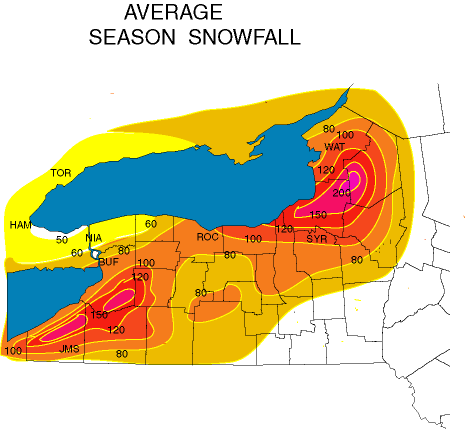
Average annual snowfall in inches, Upstate New York (from NOAA). Tompkins County is in the 60-80 inch band. [2]
Tornadoes and windstorms do happen occasionally, with the Village of Dryden seeing tornadoes downtown in 1983 and 1996, and the Jersey Hill area having one last year. While these have been relatively weak tornadoes, powerful tornadoes do occasionally occur in the northeast [3].
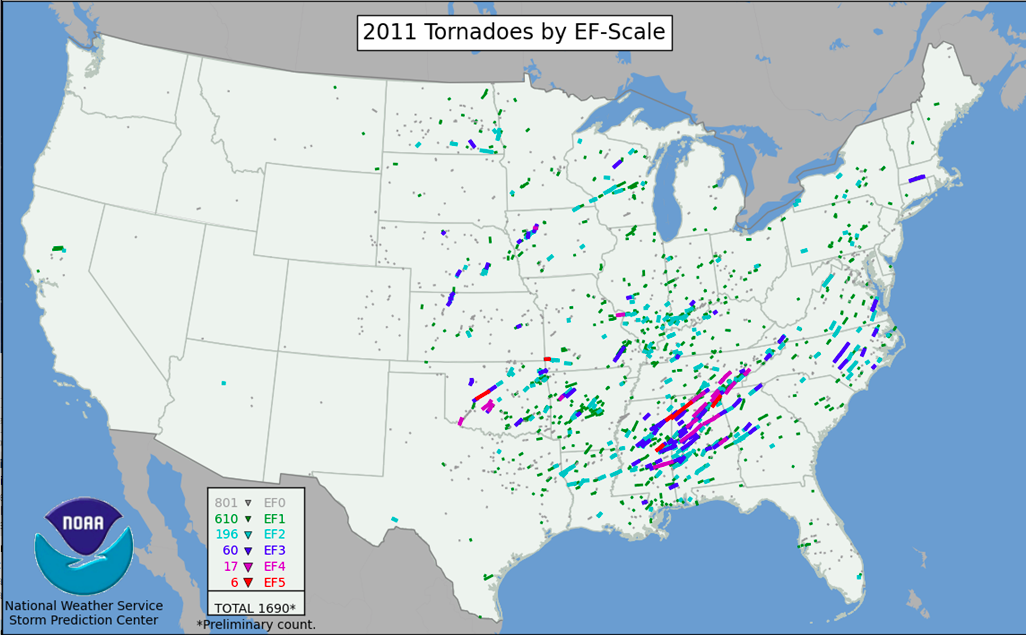
US tornadoes, 2011 (from NOAA) [4]
While the weather of spring 2012 may have seemed strange, odder and more damaging weather has happened in the past. May 23, 1925 saw 94 degrees in Buffalo, followed by ice and snow the next day, and harsh storms rolled across the northeast. Perhaps most troubling, however, was 1816's "Year without a Summer" when the massive volcanic eruption of Indonesia's Mount Tambora shrouded the planet in haze, and frosts were common throughout the summer, devastating crops.
Less dramatic circumstances can still cause problems for farmers, who depend on the weather for their livelihood. Crops need water, but too much water (or water at the wrong time) can create its own problems, both for plants and for the equipment used to manage them. Hailstorms can demolish crops and equipment, while late frosts in spring or early frosts in fall can wreak havoc on harvests.
Even relatively minor-seeming weather - fog, light rain, or a little bit of snow or ice - can have a major impact on travel safety, especially on local hills. Ithaca airport had to divert flights for a few weeks in March and April 2012 because a crystal needed for instrument navigation in cloudy or foggy weather was broken, but even simpler forms of transportation can become more complicated when weather is iffy.
The impact of climate change on day-to-day weather isn't clear yet, but added energy in the atmosphere can do more than warm it. More energy means more power for wind and storms, and it increases the possibility of events like that cold front of 1925. In the long term, diversions or droughts that cause changes in the water volumes of the Great Lakes could also change weather patterns here.
Forecasting: Collection, Communications, and Calculation
While we haven't learned to actually manage the weather, we have spent the last two hundred years taming our temperate climates by getting better at knowing what weather is coming when, preferably far enough in advance to take precautions if necessary. While it remains fairly difficult to precisely forecast how much precipitation will land where, or where in a possible storm tornadoes will form, meteorologists and their powerful tools have delivered better and better results over the last century or so.
Data collection is the first key to forecasting. The earliest "weather maps" were built using old observations, but the spread of reliable instruments and telegraph lines made daily station data collection possible by the time of the Civil War. Weather station reports today range from official Automated Surface Observing System (ASOS) installations, often at airports and National Weather Service (NWS) offices, to home stations that transmit their findings over the Internet.
Monitoring precipitation is important, but monitoring the impact of that precipitation on streams and rivers is also important for predicting flooding. In Tompkins County, the US Geological Survey maintains recording gauges on Six Mile Creek at Brooktondale and Bethel Grove, on Fall Creek in Forest Home, and on Cayuga Inlet at the lake.
Weather balloons add critical upper air observations. They are typically released twice a day from 900 stations around the world. Radiosondes [5] transmit data on pressure, temperature, and humidity for up to a few hours, and the path of the balloon indicates wind speed and direction. The balloons themselves are single use, rising until they pop. While about 20 percent of radiosondes are found and recovered, most disappear after a single use. At $100 for each radiosonde plus approximately $20 for the balloon and perhaps another $20 to fill it, individual balloons may seem relatively cheap, but they become expensive over time. Occasionally, as when Hurricane Irene was coming up the East Coast in 2011, the weather service uses them more than twice a day, but this is rare.
Weather satellites give meteorologists key overhead views of storms and normal weather. Typically satellites collect visual and infrared data, monitoring temperatures and water vapor. Satellites have made it possible to track hurricanes while they are still forming at sea, allowing for adequate warning. They also monitor solar weather, tracking changes in solar radiation and their impacts on earth's electromagnetic fields. For the United States, the key satellites are the geostationary GOES satellites. There are four functioning satellites in orbit at present, including one spare.
Airplanes both need weather information and generate weather information. While pilot reports have been important to forecasting since the early days of aviation, they were sporadic. The Aircraft Communications Addressing and Reporting System (ACARS) and temperature and wind sensosrs on planes send about 35,000 weather report messages per day in the United States, and about 130,000 per day world wide. These observations make a substantial difference in the quality of forecasting:
From September 11 to September 13 [2001], the FAA grounded aircraft across the United States. Without the benefit of the hourly aircraft observations, the 3-hour forecasts produced by NWS models became only as accurate as 12-hour forecasts normally are. [6]
A newer system, TAMDAR, pushes airplane-based automatic reporting systems further, with 425 aircraft providing approximately 5000 daily reports on temperature, pressure, winds, humidity, icing, and turbulence.
Ground-based radar serves a different purpose, tracking local storms in motion and providing detailed information on where they're going and the dangers they may pose. NEXRAD, the currently widespread weather radar, is deployed at National Weather Service sites around the US. In New York State, NEXRAD is deployed at Buffalo, Binghamton, Albany, and Montague. The NWS makes radar data available on the web and directly to private companies, which often assemble it into smooth maps that hide how it is built from multiple radar sources. NEXRAD has been especially critical in the Great Plains for tornado warnings, but it is also useful for monitoring all kinds of thunderstorm, snow, and wind events.
A wide variety of communications networks link these systems, including government networks as well as private and public commercial networks. Raw weather data from the government is freely available on the Internet, as is more-processed commercial data from vendors, often supported by advertising. A dedicated network of weather radio stations run by the National Oceanic and Atmospheric Administration (NOAA) makes reports and warnings available across the country, including in Ithaca, where station WXN59 broadcasts continuously.
Global data is also critical. Most nations share weather data freely, making it possible to build models of global weather that offer much greater long-term accuracy than models with sharp boundaries. While weather doesn't simply cross the Pacific from Siberia or China, weather data from those places can still enhance forecasting for the United States.
Processing this flood of data requires massive computing power, though perhaps compared with climate simulations or nuclear weapons simulations it isn't so massive. The National Weather Service maintains its own central models and distributes them to local offices, which issue their predictions (and warnings) based on the model and their understanding of local conditions. (The Binghamton NWS handles forecasting for Tompkins County.)
Fading Forecasting
The intricate networks of complex tools required for today's level of forecasting accuracy are difficult to maintain. Satellite launches and operations can cost millions of dollars and yet result in failure, and even the smaller components have their own difficulties. Some warnings today may point to further challenges to come in a more resource-constrained world.
Current Challenges
After decades of continuous weather forecasting improvements, American weather forecasting faces some difficult challenges today, even before considering issues of energy descent. These are often phrased competitively - "U.S. numerical weather prediction (NWP), and particularly our global prediction skill, lags between major international centers". [7] To some degree this is a question of priorities. As the article asks:
We spend this much money on a single jet fighter, but we can't invest this amount to greatly improve forecasts and public safety in the U.S.?
Weather forecasting in all of its growing complexity does not, however, seem to be an especially popular investment. Every decade or so reports emerge of resource shortages, cost overruns, and other complications. Weather Forecasting: Cost Growth and Delays in Billion-Dollar Weather Service is a typical example from 1991. Despite its more moderate-sounding title, the current Earth Science and Applications from Space: A Midterm Assessment of NASA's Implementation of the Decadal Survey [8] reports that:
the nation's Earth observing capability from space is beginning to wane as older missions fail and are not replaced with sufficient cadence to prevent an overall net decline. The committee found that the number of NASA and NOAA Earth observing instruments in space is likely to decline to as little as 25 percent of the current number by 2020...
as longrunning missions end and key new missions are delayed, lost, or canceled.
The projected loss of observing capability could have significant adverse consequences for science and society. The loss of observations of key Earth system components and processes will weaken the ability to understand and forecast changes arising from interactions and feedbacks within the Earth system and limit the data and information available to users and decision makers. Consequences are likely to include slowing or even reversal of the steady gains in weather forecast accuracy over many years and degradation of the ability to assess and respond to natural hazards and to measure and understand changes in Earth's climate and life support systems. The decrease in capability by 2020 will also have far-reaching consequences for the vigor and breadth of the nation's space-observing industrial and academic base... (page 2)
The challenges are basic, though the details are complicated:
a budget profile that is not sufficient to execute the decadal survey's recommended program. In addition, some of the survey-recommended missions have proved more challenging than anticipated, and others envisioned synergies that are not readily achieved via the suggested implementation. The ESD budget has been further strained as a result of mandates from Congress (e.g., the addition of the approximately $150 million TIRS [Thermal Infrared Sensor] to the Landsat Data Continuity Mission) and the interjection of administration priorities (e.g., the Climate Continuity missions) without the commensurate required funding. (page 4)
In particular:
Lack of reliable, affordable, and predictable access to space has become a key impediment to implementing NASA's Earth science program. Furthermore, the lack of a medium-class launch vehicle threatens programmatic robustness. (page 5)
Even on the ground, improving weather forecasting is no longer a strictly federal project. In Texas, better weather forecasting comes with a hefty local commitment [9]:
The near-ground radar system, which will supplement the current NEXRAD Doppler radar network, will provide faster scans, higher-resolution images and multiple overlapping views of storm cells, said Bill Bunting, chief meteorologist for the National Weather Service in Fort Worth....
CASA is footing the approximate $4 million cost of the initial eight radar systems.
Local entities are responsible for the first year's operating cost, $500,000; the cost is expected to decline in the second year.
$500,000 is still a small piece of a $40 million system, but localizing the cost of these services seems likely in an era where federal expenses of any kind are increasingly questioned.
Possible Future Challenges
Satellites are risky business under the best of circumstances, but resource constraints can wear on nearly every part of the weather forecasting system. Satellites themselves are an extremely visible component of our weather tracking systems, and their information may also have military value, so it is possible that those could continue while other pieces of the system break down.
Components of the technical network that produces today's weather forecasts face four major challenges:
Physical wear
Physical wear is a serious long-term challenge for weather station components but especially for things like stream gauges. Wear may not show itself as failure, but through diminished accuracy, requiring regular calibration.
Complex maintenance
Radar and communications systems are complex to build, but even when they're operational they need regular upkeep. In the case of satellites, "maintenance" often means "replacement".
Questions of distribution (and cost distribution)
The National Weather Service provides information to the public for free, but also provides data feeds to the many commercial weather providers. It's a complex and ever-changing relationship in which the NWS provides foundation information but "specialized services" are handled by industry. Current expectations of things like free radar maps that have been combined and reprocessed depend on the health of a variety of commercial models.
Changes in aviation
As airlines streamline operations, consolidating flights to reduce the number of empty seats and cutting service to airports that don't meet their profitability expectations, fewer flights will yield less weather data from fewer locations.
It is, of course, possible that Americans will demand better weather information and the federal government will make it a higher priority even if energy costs climb, but it is hard to forecast that. There are scenarios - More satellites! Bigger computers! More ground stations! - in which weather forecasting quality could improve, but given the kinds of constraints TCLocal tries to prepare for, this is unlikely.
Weather forecasts probably won't go away, of course. If parts of the system fade, the quality of the forecasts will decline, especially longer-term forecasts. Rough seasonal forecasts based on ocean currents (El Niño and similar) may continue to be useful, however, so long as the data continues to be collected. Some pieces are more at risk than others - for example, Doppler radar is constantly a matter of life and death on the Great Plains, where tornadoes are common, so it's not hard to imagine a resource-constrained NWS moving key resources where they're most needed. For radar, that isn't here.
Impacts and Alternatives
If weather forecast quality declines, the simplest general approach will be to prepare for more weather danger than may come to pass. Forecasts have in many ways tamed a climate that already can lurch from blazing hot to freezing cold by letting us figure out what's going to happen before it gets here. If that luxury becomes less reliable, residents will have to sacrifice efficient use of time and resources to avoid catastrophes.
Many of the changes suggested here also apply if climate change should produce weather more extreme and changeable than we already have. Weather forecasting is largely a tool we use to moderate the effects of weather, so declining weather forecast quality is in some ways produces impacts equivalent to increasing extremes in actual weather. Great weather forecasting can ease the impact of many aspects of extreme weather, while poor weather forecasting makes it harder to avoid even the impact of our usual weather.
Traveling on the Weather's Schedule
On January 24, 1945, schoolbuses left Dryden Central School early to try to get students home in the face of a blizzard. All but one couldn't get through, however, and 61 students returned to the school for three days. When they finally went home, it was in open horse-drawn sleighs, not the buses or even the plows that couldn't get through the snow.
Today, that experience is hard to imagine. A school superintendent who knew snow was coming but hoped to avoid an extra snow day could easily have changed plans earlier in the day. Although radar isn't great for identifying the rate at which snow falls, it certainly makes clear if a storm is moving more quickly than planned, and provides some extra margin to get students home. We can plan our activities around weather forecasts, and change them in real time based on constantly updating data.
Without that data, however, working or traveling outside is more complicated. Cars and trucks with wheels perform much better on smooth dry asphalt, especially on the hills of Tompkins County. People in charge of wheeled transportation - a highway superintendent trying to keep roads open, a superintendent of schools commanding a fleet of buses, or a trucking company carrying gravel - will have harder times developing plans of action. The odds of a mistake climb dramatically and caution becomes more prudent.
Similarly, people can choose to travel less. That could increase the value of local shops, which could be more convenient than a drive to a bigger, farther location when snow seems possible. Those who have the power to choose transportation network designs - school districts in particular, but also municipalities and some kinds of businesses - might opt for less centralization and shorter trips. By increasing the overall cost of travel, weather uncertainty reduces the advantages of centralization.
Another option, of course, is to choose modes of transport that are less risky. Pedestrians don't always enjoy ice and snow (or even rain), and shouldn't wander the countryside in a blizzard or throw aside their canes to dance on the icy sidewalk, but they have more options. Snowshoes, skis, and traction devices for shoes are all easier to apply and remove than chains on vehicle tires. Sleighs and snowmobiles provide another option, though not necessarily an option that works at large scale.
Concentrating and Protecting Fragility
While large-scale blizzards create problems across large areas, weather forecasting helps minimize the impact of many smaller problems. Hail and frost warnings may only affect a small area or a small set of projects, but defending against either is difficult on a large scale. A hail warning might, for example, tell individuals to park vehicles inside or protect key outdoor objects, while a frost warning might be a sign to protect seedlings or fruits with a cloche or similar wrap. Without those warnings, people will have to guess what might be coming based on a broader picture of the weather.
Instead of cursing warnings that weren't issued, a simpler approach concentrates fragile items and protects them. For vehicles, this is the classic garage or carport. For plants, it could be a greenhouse, but it could also be a much lighter high tunnel that can cover large areas at low cost. On a smaller scale, it could even be a row cover that protects smaller plants with metal frames and translucent covers. None of these are cheap, but all of them bring other advantages.
In some cases, changing the style of agriculture or gardening may also be appropriate. While most crops are grown in open fields to maximum sun exposure, some crops, notably currants and gooseberries, can thrive in light forests. Food forests and silvipasture approaches may be more resilient against unexpected or more severe weather than traditional approaches.
Concentrating tasks that need attention and connecting them to people who can help is another option. Medieval buildings that combined barn, stable and house for shared convenience (and warmth) might seem extreme, but such an arrangement can be practical. A simpler approach is placing housing near buildings, notably barns, that need regular human visitors. In many northern areas the connections between buildings are roofed or even turned into hallways, protected from the risks of wind, rain, and snowdrifts.
Large-scale Protection
Past flooding drove the construction of two major public works meant to reduce the dangers inherent in Tompkins County's system of streams. The Flood Control Channel in Ithaca was built to reduce the impact of regular flooding in downtown Ithaca, and the Crispell Dam on Virgil Creek in southeast Dryden does the same for the Villages of Dryden and Freeville and for Fall Creek generally. Around the county, many stream stabilization projects direct water away from places it would cause trouble.
These massive projects have had substantial effects. The Crispell Dam slowed the rate of flow in Fall Creek at a critical moment in September 2011, and the Flood Control Channel has, with some minor exceptions, kept dry even areas that used to regularly flood. The Flood Control Channel has even made development in formerly wet areas like Southwest Park and the current Ithaca High School seem more plausible.
While these public works can substantially reduce the uncertainty created by declining forecasts or more severe weather, they also cost a lot to build and maintain. The Flood Control Channel in particular just received $13 million for dredging, a project that is already far behind an ideal schedule. The dam and stream projects also require regular maintenance as well, though the work is smaller and less specialized.
Other kinds of public works can also make a substantial difference. The floods in Trumansburg in 1935 and Dryden in 1981 shared a common culprit: bridges that filled with debris. While larger bridges with designs that are harder to plug are more expensive, they may be an ever more necessary part of shared infrastructure. (They also wash out less frequently.)
Applying Microclimates
Because of Tompkins County's varied terrain and water features, weather conditions can vary drastically over the course of a mile or even a few hundred feet. Some of those microclimates have much calmer weather than the rest of the county, but may not be especially useful because they're in the bottoms of mostly shady gorges. Elevation, exposure, and orientation all create different situations that produce significantly different weather.
Closer study of different areas could yield a map of places that are more and less prone to frost damage on cold nights, likely to receive more or less precipitation (and especially runoff), and which get more or less wind. On a broad scale, the 2011 version of the US Department of Agriculture's climate zone map shows areas along the lake and at the lake's elevation as Zone 6a, with a minimum winter temperature of -10°F, while the rest of the county is at Zone 5b, minimum winter temperature of -15°F.
Identifying different microclimates is sometimes possible through simple observation over time. People definitely talk about colder valleys and places where it's harder to grow fruit trees. More detailed mapping, however, might be a good project to start while the full set of weather tools is still available. Once identified, that knowledge would be a good complement to things like the Soil Type Maps when farmers need to decide what kinds of crops to plant where.
Local Data, Local Warnings
Today, weather warnings are issued by regional NWS offices. While those warnings can be extremely useful, they come with natural limits because of the limited information about extremely local conditions. Stream gauges, for example, are largely downstream of places where flooding might occur.
Local watches could become a regular part of government again. During the 1935 flooding, a local watch on the Dryden Lake dam reported concerns about a break. None occurred, and some people were unhappy about the false alarm, but that's information that the weather service can't really provide. Certain key points with aging infrastructure or a dangerous history may be especially worth watching and monitoring.
Recommended Reading
The Ultimate Guide to American Weather, by Jack Williams (2009), for an overview of current forecasting.
Warnings, by Mike Smith (2010) on how warnings and related technology evolved.
Air Apparent, by Mark Monmonier (1999), on how weather forecasting came to be.
Eric Sloane's Weather Almanac (reprint, 2005) for a look back at weather lore by a noted antiquarian who also happened to be a Navy meteorologist.
The 2012 Ithaca Weather Calendar, for local data. The 2013 version will likely include new records.
Basic Spotters' Field Guide, the National Weather Service introductory guide for local weather spotters.
Notes
[1] - "Home Movie of Trumansburg New York Flooding 1935." http://www.youtube.com/watch?v=Dt7mNDxj_5o
[2] - "Average Seasonal Snowfall Over the Eastern Great Lakes Region." http://www.erh.noaa.gov/er/buf/lakeffect/snowseason.html
[3] - "Tornado crosses NYS Thruway." http://www.youtube.com/watch?v=8pWkmTVbqcA
[4] - http://www.spc.noaa.gov/wcm/annualtornadomaps/.
[5] - "NWS Radiosonde Observations - Factsheet."http://www.erh.noaa.gov/gyx/weather_balloons.htm
[6] - Williams, Jack. The Ultimate Guide to America's Weather, 138.
[7] - Mass, Cliff. "Lack of Computer Power Undermines U.S. Numerical Weather Prediction (Revised)." http://cliffmass.blogspot.com/2012/04/us-has-fallen-behind-in-numerical.html
[8] - Earth Science and Applications from Space: A Midterm Assessment of NASA's Implementation of the Decadal Survey. https://download.nap.edu/catalog.php?record_id=13405
[9] - Campbell, Steve. "New weather radar better tracks violent storms." http://www.standard.net/stories/2012/03/19/new-weather-radar-better-tracks-violent-storms
By Simon St.Laurent
One of the most common complaints about the industrial age is its constant and seemingly ever-growing use of sweeteners. Whether it was cheap sugar (and rum) in the early 1800s, saccharin in the early 1900s, or high-fructose corn syrup in the late 20th century, sweeteners have had a bad—but tasty—reputation.
In a local context, however, sweeteners are extremely important. Many of the local fruits that contain Vitamin C, for instance, are difficult eating unless sweetened. Aronia Melanocarpa is called "chokeberry" for a reason. Black currants are difficult eating off the bush. The more familiar perennial rhubarb also becomes far more enjoyable with sweetening. Even in less extreme cases, sweeteners can certainly add enjoyment to foods otherwise too bitter or too bland to be attractive. Sugar is also very important in preserving food, where it creates a hostile environment for bacteria as well as a delicious treat.
Many different sweeteners are available today, though they may become more or less important in localization or energy descent situations. Some require industrial facilities and major energy inputs, and a few are dangerous, but many familiar sweeteners will likely remain available into even an uncertain future.
Sugar and Molasses
Sugar cane, a tropical plant, doesn't grow in Central New York. United States sugar producers are in Louisiana and Florida, though sugar refineries have been prominent features of port cities along the coasts. Modern sugar production relies on energy-intensive industrial processing and distribution. Cane sugar's long history, however, suggests that it and its by-product molasses can still be valuable with reduced processing, as extracting sugar is relatively simple and can be fueled with the cane that created it[1]. Sugar distribution and storage are similarly simple, as it is easily packed for safe storage.
Sugar produced from beets has many of the same issues as cane sugar, but unlike sugar cane, sugar beets can be grown in New York State. However, the quantity of sugar beets currently grown is small enough that the USDA National Agricultural Statistics Service[2] doesn't even offer sugar beets as a query option for New York. Today, sugar beets receive more industrial processing than does sugar cane, despite containing 17% sugar while cane contains 10%. Unlike cane, beets cannot easily be processed using their byproducts for fuel. (The byproducts are typically used as animal feed.) Sugar beets are also typically used as a crop in rotation, so the yield per acre is substantially lower than that of cane.[3] Sugar beets can be processed at home on a small scale by chopping, boiling, and evaporating, however.[4]
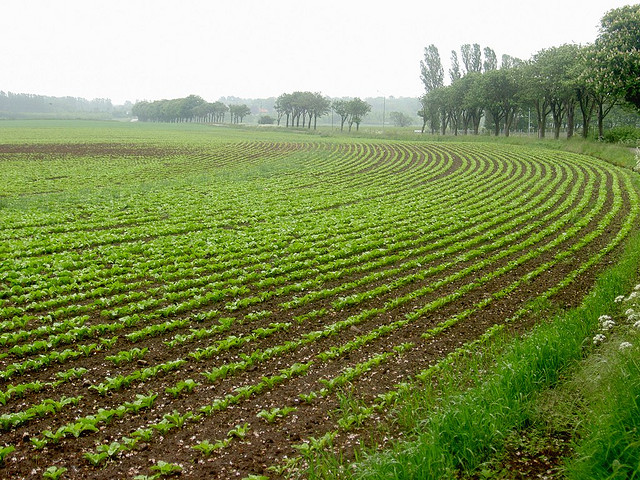
Figure 1. Sugar beet field, Sweden (original source, used under Creative Commons license from Dag Endresen.)
The primary questions about sugar in an energy descent situation revolve around price, distribution, and quality.
Though sugar in the United States is expensive relative to sugar in the rest of the world (roughly double the Canadian price because of American import quotas[5]) it remains a remarkably cheap commodity by historical measures. As the energy costs of sugar refining climb, those prices will likely climb. Diversion of sugarcane to ethanol production may also shrink the available supply of sugar substantially, also increasing the price.
If energy costs climb, the cost of distributing sugar, especially cane sugar coming from a distance, will climb. Sugar works well with slower and less energy-demanding forms of transport, but transitions to new distribution patterns may take time. Disruptions may also be more difficult because of the longer supply chain of cane sugar.
While less-refined sugar has become a high-end product recently, most people still expect their sugar to be a pure white with a relatively neutral taste and predictable cooking behavior. If the extra energy cost of refining to white sugar climbs, more people may need to get used to less-refined sugar.
It may be possible to create a substantial sugar beet industry in New York State—or it may make sense to count on sugar's relatively easy tradability to keep it available.
Corn sweeteners
Corn-based sweeteners thrive today because of a combination of the import quotas noted above and subsidies for corn production. Dent corn is converted into corn starch by a wet millling process and then treated with enzymes to produce corn (glucose) syrup. High-Fructose Corn Syrup (HFCS) is made by an additional enzyme process to convert much of that glucose to fructose.[6] This is a strictly industrial energy intensive process:
Corn wet milling is the most energy intensive industry within the food and kindred products group, using 15% of the energy in the entire food industry. After corn, energy is the second largest operating cost for corn wet millers in the United States. A typical corn wet milling plant in the United States spends approximately $20 to $30 million per year on energy.[7, page 3]
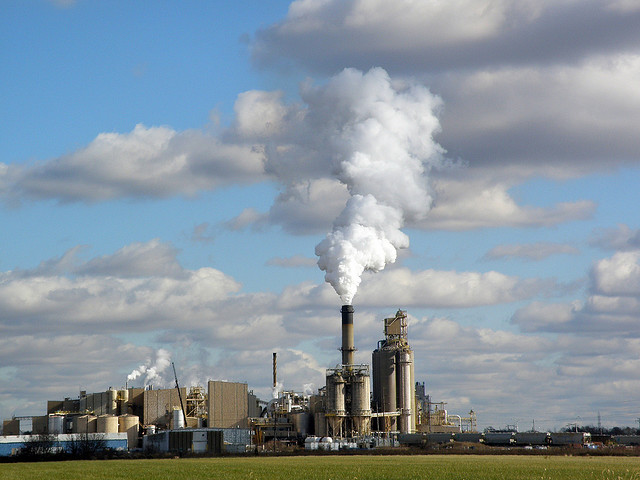
Figure 2. Wet corn mill (original source, used under Creative Commons license from Jim Hammer.)
While dent corn can be grown locally, the industrial scale and energy requirements of wet corn milling seem to put local corn syrup out of reach. There was a corn wet mill in Montezuma, New York, just up Cayuga Lake, but it closed in 1986.[7, page 73] Like sugar, corn syrup can be easily transported and stored.
Artificial sweeteners
If you count the extremely toxic "Sugar of Lead" (lead acetate), artificial sweeteners have been around for thousands of years, though the modern history usually begins with saccharin in 1879. While it is likely possible to create most of these sweeteners in the laboratory facilities available at Cornell, most of them are produced today in large volume at chemical plants.
As many artificial sweeteners (notably neotame, aspartame, saccharin, and sucralose) are sweeter by volume than sugar, and store reasonably well, they may be easier trade goods than sugar itself. Xylitol, mannitol, and sorbitol, the sweet alcohols, are roughly as sweet as sugar and are useful both to sweeten food for diabetics and potentially as a tooth decay preventative.
Lead acetate deserves special attention as a danger, as it is not difficult to synthesize from lead and has commonly been used as an adulterant in foods and drinks.
Honey
Honey is a commonly available sweetener that can be produced in large quantities in the Finger Lakes region. Beekeepers encourage hives to produce more honey than they need to survive the winter, then take the extra honey for human consumption.
Beekeeping is a complex art, though it scales down to the household level more easily than the production of many other sweeteners. Keeping hives alive has become more difficult in recent years with the spread of pests, notably varroa mites, but the infrastructure and learning investments required to become a successful beekeeper are still fairly small.
Until the mid-19th century, beekeepers used hollow logs or straw houses, called skeps, for their bees. While these worked, they didn't allow beekeepers to inspect the hive for disease, and the hive usually had to be destroyed to retrieve the honey. Because of disease issues, skeps are illegal in the US.
Most beekeepers use Langstroth hives, rectangular boxes filled with frames in which the bees make their home. So long as beekeepers maintain precise distances between equipment inside of the hive, the bees will avoid gluing everything together. This flexibility makes it simpler for beekeepers to inspect the hive, as well as to add and remove equipment to gather honey. Langstroth equipment does require a fairly substantial investment, and most beekeepers buy sturdy frames filled with wax or plastic foundation printed in a hex pattern. This gives bees a bit of a head start, and reinforcements in that foundation make it much easier to extract honey by spinning the frames mechanically.
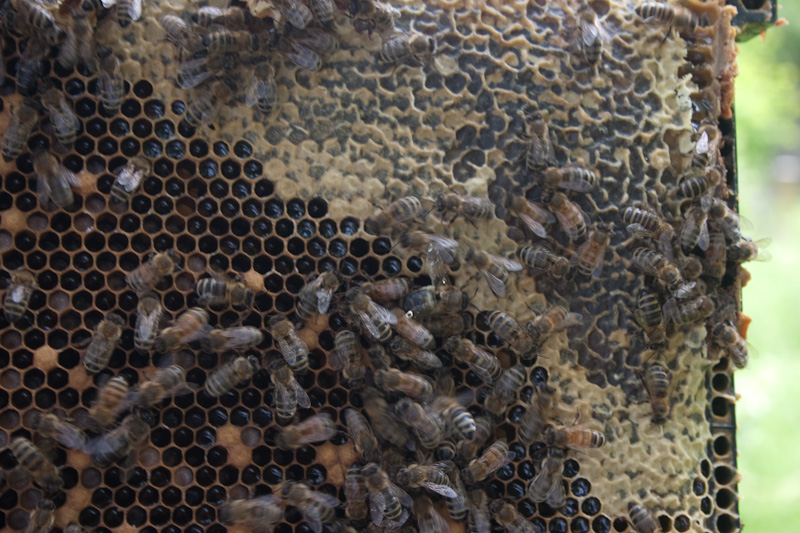
Figure 3. Bees on framed comb, honey top right, brood lower left. (Photo Simon St.Laurent.)
It is possible, though slow, to replace frames with bars with a simpler strip of wax on the bottom and have the bees build their comb on that, but the frames will be less regular and more difficult to use with an extractor. Taking that idea further, some beekeepers are using top bar hives. These hives fit into a single box organized horizontally rather than stacked vertically. The bees build their own comb, and beekeepers who want to collect the honey press or cut the comb instead of spinning it. This destroys the comb, requiring the bees to work harder to make new honey, but requires less dedicated equipment.
While much beekeeping equipment can be built from readily available wood and metal, two pieces of the beekeeping system are more difficult. The foundation is generally manufactured, though it can be created on a smaller scale using old equipment like some of that on display in the Dyce Lab at Cornell. The harder challenge is the supply of bees and queens. New bees and queens can be raised in the north, but at present most nurseries for bees are considerably farther south and rely on express delivery services. Local breeding has become more popular as a way to improve bees, so this may not remain an issue for very long.
Beekeepers are facing an ever-wider variety of diseases and parasites. While Colony Collapse Disorder (CCD) made headlines, most beekeepers are battling a variety of problems, most notably varroa mites. Chemical solutions can keep mites at bay, but mites seem likely to be a permanent feature of beekeeping at this point. Integrated Pest Management (IPM) mixes chemical and other approaches, focusing on keeping hives going. Inspection, now an optional event in New York State, may become especially important again if beekeepers have to rely on their own production of bees rather than importing new ones from the south.
While some beekeepers might find warmer weather convenient, changing weather patterns, especially if extreme weather becomes more common, could create difficulties. Rain and snow can keep bees in their hives and prevent their collecting food, while drought can delay or hinder plants from flowering. Bees also fly much less when temperatures are 90° F or higher, staying home to cool the hive. Bears moving north present another challenge.
Maple Syrup and Maple Sugar
Upstate New York has been producing maple syrup and maple sugar for centuries. Native Americans taught European settlers about collecting and concentrating sap, and Europeans gradually technologized and standardized the process. It was a key part of the development plan for early Cooperstown, though visions of maple fortunes faded quickly[8], and the energy and infrastructure challenges of making maple syrup have kept it from competing with cane or beet sugar. (Beet syrup starts at a concentration of 6 parts water to 1 part sugar, cane syrup starts at 10:1, and maple sap is at 40:1.)
While many modern maple syrup producers use plastic tubing to collect the sap, simple metal taps and buckets can provide a sustainable (if labor-intensive) collection system. Even a simple pot can work for boiling down sap, though large flat pans and especially more complex flue pans make it much easier to evaporate sap down to syrup. An indoor wood stove already used for heat can boil syrup at the household level, while a sugarhouse with vents is likely a better idea for a larger pan. A sugarhouse will need a dedicated supply of wood (or other fuel), but that is frequently available in the same areas as maple stands.[9]
While sugar maples (Acer saccharum) are the traditional tree for maple syrup production, red, black, and some silver maples can also be tapped, as can box elders and birches.
At any scale, however, maple faces some challenges. The flow of sap depends on the weather, particularly on the contrast between daytime and night time temperatures. Sap flows during the day, carrying sugar from the roots. A winter that turns too suddenly into spring can disrupt maple production, as can seasonal storms that make it difficult to collect and evaporate syrup. The short season and its unreliability make maple syrup a risky product. While it is not difficult to preserve maple syrup, its greater water content makes it more likely to spoil than honey or sugar. (Maple syrup can be made into maple sugar, at a large energy cost in additional refining.)
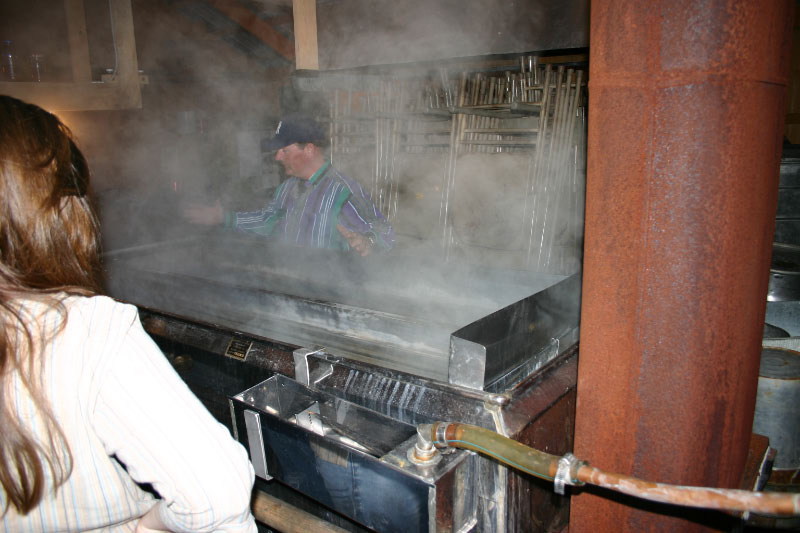
Figure 4. Evaporating syrup in Marathon, NY (photo Simon St.Laurent)
Maples also face environmental challenges. Climate change may shift the range northward, giving hickories and oaks an advantage while limiting maples. Long-term changes in spring weather patterns could also complicate or reduce the maple season further. The Asian Long-Horned Beetle, already present in New York City, attacks and weakens maple trees and a variety of other species. Larvae tunnel through the wood, weakening the tree.[10] These beetles may reduce the number of healthy maples and make it more difficult for new maples to survive.
Sorghum
Sweet sorghum, though traditionally grown further south, can produce a syrup similar to molasses, as well as silage or forage for animals. Some farmers are experimenting with it in Tompkins County as a cover crop and animal feed today, and it may be an appealing option if climate change extends the growing season.
Processing sorghum for syrup requires stripping the leaves and seed head off the cane, then squeezing the juice out of it and evaporating and skimming that juice. Crushing the cane is generally done with a simple mill, and the resulting juice yields about a gallon of syrup from ten gallons of juice.[11]

Figure 5. Sorghum mill (original source, used under Creative Commons license from g-s-h.)
Fruit Juices
Fruit juices and concentrates, and even applesauce, are classic sweeteners. While whole fruits are, of course, a delicious way to enjoy fruits, juicing and similar processes make it much easier for people to consume fruits that are bruised, damaged, or simply useful as a background sweetener rather than as the primary flavor. Commonly available apple and grape juices, both products of Upstate New York, are regularly used to provide bulk and sweetness to more expensive juices like cranberries, blackberries, blueberries, or (more recently) pomegranate.
Like fruits, fruit juices can be canned or frozen. They require more energy input to preserve than do sugar or honey, but are easier to create with ordinary pots or pans or with simple tools like steam juicers. They scale up to greater volumes easily as well.
Malt
Grains are another common source of sweetness. Malting grain is a fairly complex process involving drying, storing, adding water, partially germinating, and then processing and often mashing. Today most malting relies on industrial equipment and purpose-built malting floors, but the basic steps can be done with simple equipment on a wide variety of scales.
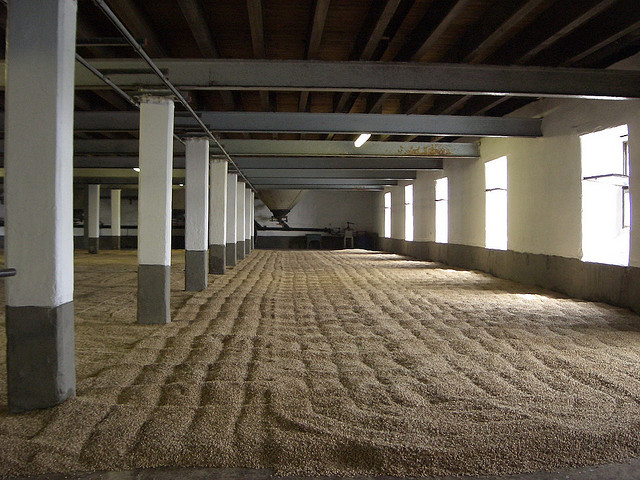
Figure 6. Malting floor (original source, used under Creative Commons license from Chris Sharp)
Malt is most commonly used as a fermentation base for beer and whiskey, but it is also a key component in malted milks, malt vinegar, and malt candies. Barley is the most common grain used for malting. Many grains are bred specifically to provide the enzymes needed for the malting process.
Stevia
Stevia is a relative newcomer, at least in the United States. The plant Stevia rebaudiana, originally from South America, has leaves that are approximately 30 times sweeter than sugar, and its core sweetening compounds are approximately 250 times sweeter. The Food and Drug Adminstration has allowed the sale of stevia as a food supplement but not as an ingredient, though stevia-derived sweeteners are now legal for use.
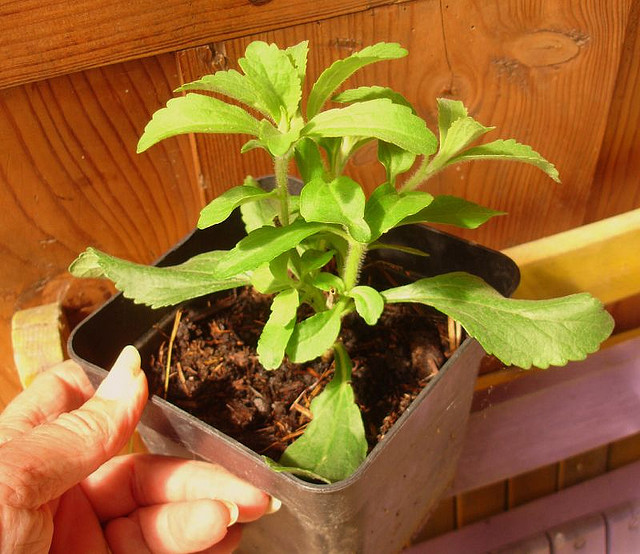
Figure 7. Stevia plant. (original source, used under Creative Commons license from Irene Kightley)
Stevia's climate expectations limit its use for large-scale plantings in Tompkins County. However, it may prove useful as a household-scale sweetener, especially for people who have difficulties with other sweeteners. It can grow as a window plant, getting the sun that it needs while avoiding the cold. Stevia leaves can be used directly as a sweetener without further processing.
Alcohol
All of the natural sweeteners except stevia can be converted into alcohol through fermentation, possibly followed by more energy-intensive distillation. Malt is traditionally used for beer; fruit juices for wine; hard cider, and brandies, honey for mead; and sugar and molasses for rum. In addition to its intoxicating qualities, alcohol can be used as a preservative and to sterilize medical equipment and wounds.
In an energy descent situation, however, sugars are perhaps dangerously attractive as an easy source of alcohol for fuel. Competition between food and energy uses of sugar will likely increase demand (and prices) for sweeteners.
Policy Suggestions
Some projects supporting local sweetener production already exist. Cornell's Master Beekeeper program and its work with maple products in the Arnot Teaching and Research Forest focus on honey and maple syrup. Cornell Cooperative Education offers sessions on fruit juices and preserving.
Some sweeteners, notably cane sugar and corn syrup, are unlikely ever to become local products, and most of the artificial sweeteners are unlikely to become economical local products.
Sorghum and stevia originated in far warmer climates than Tompkins County has to offer, but both are worth exploring in different contexts. For now, sorghum seems useful primarily as a cover crop, with some potential for use as a sweetener. Stevia is more promising because of its ability to grow as a houseplant, and could be an excellent target for Cooperative Extension projects and local nursery development.
There is one great danger here, something that local public health officials should watch for: the possible return of lead acetate. At present, this threat is discussed mostly in the context of imported food, but it could just as easily surface in local food. Watching for symptoms and developing testing protocols could become much more important if the price of sweeteners climbs.
[1] http://www.sucrose.com/lcane.html
[2] http://www.nass.usda.gov/QuickStats/Create_Federal_All.jsp
[3] http://www.sucrose.com/lbeet.html
[4] http://www.grandpappy.info/rsugar.htm and http://www.ehow.com/how_2177131_sugar-beets.html
[5] http://edis.ifas.ufl.edu/sc032
[6] http://www.madehow.com/Volume-4/Corn-Syrup.html
[7] http://www.energystar.gov/ia/business/industry/LBNL-52307.pdf , page 3 and 73
[8] Taylor, Alan. William Cooper's Town: Power and Persuasion on the Frontier of the Early American Republic (Vintage, 1996), 130-4
[9] Perrin, Noel. Making Maple Syrup (Storey, 1983)
[10] http://www.dec.ny.gov/docs/lands_forests_pdf/alb.pdf
[11] http://www.herculesengines.com/sorghum/default.html and http://www.motherearthnews.com/relish/making-sorghum-zb0z11zalt.aspx
By Krys Cail
Over the past decade or so, social trends have emerged that promote local economic exchange around a regional or local food system. The rise in popularity of farmers’ markets is shown by the 16 percent increase in number of markets between 2009 and 2010.[1] Grocery stores, college cafeterias, and now even Walmart stores are trying to source more fruits and vegetables from local growers.
Slow Food is an international NGO that began in Italy but is now world-wide in scope. It celebrates the local and regional culture of the table while encouraging taking the time to enjoy basic social activities, like sharing food. Indirectly, the Slow Food movement also encourages local culinary, agricultural, and wine tourism industries. In the Tompkins County area, we have made significant progress in the development of local and regional food systems, often in collaboration with the region’s grape growers and wine makers. Local food is a current focus of local interest that we would be well served to further develop in view of energy decline and the need to shorten food supply chains.
The Slow Food Movement was among the inspirations for the work of Woody Tasch, a socially responsible investing leader and author. He coined the term “Slow Money” to describe investing in the local foodshed with a portion of one’s portfolio—with an understanding that this investment might pay off better in social and environmental benefits while generating a somewhat lower financial return. His book, Inquiries into Slow Money: Investing As If Food, Farms and Fertility Mattered[2], inspired others, and a number of like-minded individuals launched an effort aimed at starting a Slow Money Movement[3]. They adopted a goal—one million people investing one percent of their assets in local food systems within ten years. They also adopted principles[4] and began working with local and regional Slow Money organizations to establish investment programs. Slow Money has gained some national recognition over the past couple of years, with articles appearing in Business Week[5] (one of their “big ideas for 2010”), Entrepreneur.com [6] (one of “five financing trends for 2011”), Utne Reader[7], Time[8], The Wall St. Journal[9], and The Los Angeles Times[10].
A local group, loosely affiliated with the national movement, has begun planning activities here in Tompkins County. This Slow Money Central New York group can be contacted through the Alternatives Business CENTS program[11] or Local First Ithaca[12].
Envisioning a new investment paradigm is difficult theoretical work, but actually implementing a system that directs flows of investment cash into local food systems is even more difficult. As a nascent movement, Slow Money has moved methodically to build a robust infrastructure for implementation. A growing national network of interested people have been considering how local groups or “Slow Money Alliances” would be structured in order to accomplish the work of bringing more investment into local food systems. The national Slow Money Alliance uses a number of other national organizations as models, including Slow Food, BALLE (Business Alliance for Local Living Economies), Social Ventures Partners, and Transition US. There is a focus on preparing for energy descent through relocalization by investing in local food systems.
Investors may have a simple need—to keep at least a portion of their portfolio invested in the local foodshed. Food buyers, both in the urban areas in the region and in the Tompkins County area, also want to buy food from nearby. This gets complicated very quickly, however, by rural/urban interdependence. Cities, and especially huge port cities like NYC, relocalize by becoming more dependent on a regional, not local, foodshed. Rural areas in the region may be dependent on investment from the urban areas. Tompkins County may or may not be in a position in the future to source investment capital from local investors alone; rural areas may find that they continue to have some dependence on larger regional centers of finance. Many Tompkins County farm and food businesses currently sell a portion of their produce to local markets, and also ship a portion to regional urban population centers, most typically NYC. Tompkins County is within the NYC Greenmarkets catchment area, and currently, many local food producers make the trip to sell in those lucrative markets. While that pattern may change some as the price of truck transportation increases markedly, it may not: sourcing fresh foods from even farther away may cost yet more, making the relative cost of Tompkins County grown food in NYC still attractive.
Additionally, wholesale foodstuff supply chains move food from local farms and food processors into urban markets. Locally-owned shipping companies, such as Regional Access[13], may adapt to new transportation approaches as fossil fuels increase in price. For example, multi-modal shipping via train and/or barge would allow shelf-stable or cooled produce to travel more economically. One gallon of fuel will take a ton of freight about 155 miles by truck, 413 miles by train, and 576 miles by barge.[14] In particular, crops such as grains, beans, seeds, oils, and meats that require a large land base for their production are likely to continue to be imported into large cities from their peripheral rural areas. In many cases, it’s more cost-effective to manufacture minimally processed foods, such as canned or dried fruits and vegetables, closer to where they are grown, and then ship them via lower-energy transport, such as barges or trains. Tompkins County is exceptionally well placed to ship local goods by water; it is possible to send goods by boat from Ithaca to anywhere on the Great Lakes, the Mississippi, or the East Coast.
The Central NY Slow Money Group has been meeting at the Alternatives Federal Credit Union[15]. The group has established a cooperative, interdependent relationship with Slow Money NYC. Central NY generally, and Tompkins County in particular, has many farm and food enterprises, but relatively fewer eager high-net-worth investors. For NYC, that situation is reversed. Some collaboration can be of value, allowing people who eat Tompkins County food to invest in Tompkins County food growers and processors, whether they live very near the farm or in the nearest megalopolis.
Access to capital can be gained by a business through an equity deal (selling portions or shares of business ownership) or through debt instruments (loans requiring a stipulated repayment schedule, but conferring no ownership rights). There are also hybrid arrangements, such as debt instruments that convert to equity shares if not repaid over a certain period. Under the current regulatory framework, it is difficult—not impossible, just difficult—to raise private equity funds for a business venture from a large number of investors of limited means. Typically, “qualified investors” (those with more than one million dollars in net worth) are able to play by somewhat different rules than the rest of us, as the regulators consider them to be savvy enough to fend for themselves in the investment world. To make an offering to a group of people who are not all “qualified investors” (for instance, the membership of Greenstar Cooperative Market), some form of an intermediary fund is probably most practical.
Cooperative membership/ownership organizations are but one model that allows for a large group of investors to provide capital and share risk. The CSA (Community Supported Agriculture) model is another approach. Slow Money groups at the national, local, and NYC levels are all exploring the best ways to facilitate these kinds of transactions, meeting the needs of businesses while mitigating exposure to risk for investors and also keeping some liquidity for investors.
Slow Money group members seek to meet two very different kinds of needs with one suite of mechanisms.
First, investors want to move beyond socially-responsible investment opportunities and now want to invest their money in businesses that have a triple-bottom-line benefit: businesses that are socially responsible and environmentally appropriate while also making some profit. People who understand the inevitability of energy decline may well want their money invested in shortening the supply chains for essentials like foodstuffs.
Second, small farm and food businesses need access to capital to grow and process the foodstuff supplies that we need in a more localized or regionalized food system. Traditional financing, still stuck in a global market worldview, is often disinclined to channel investment into the type of enterprise that could help smooth the adjustment to a world with a lot less oil.
Three opportunities for investment in Tompkins County food systems
Several local initiatives offer both Tompkins County residents and city dwellers the opportunity to invest “slow money” here. In the following, I’ll briefly describe three of them.
Local opportunity number 1: Facilitating land acquisition by prospective farmers trained at Groundswell
Groundswell[16] is a program that uses both classroom teaching and on-farm training to teach students to farm. If there is one practical suggestion for an easier transition in the face of energy decline, it is that more people need to learn to be able to grow food. In a globalized market for energy, food-growing resources have been diverted to the production of fuels such as ethanol, which, in combination with increases in costs of petrochemical inputs into industrial farming, has caused food commodities to experience great price volatility. In the near term, we are likely to see spot price run-ups and shortages, while in the long run, food grown closer to home and with more animal-power, human attention and labor, and organic inputs will be more sustainable. Groundswell’s programs are tailored to producing more farmers through a classroom-based curriculum of instruction delivered at EcoVillage at Ithaca, dovetailed with hands-on farming apprenticeship in a structured program that exposes students to many local farms. The emphasis on sustainable and organic methods prepares new farmers to farm with less reliance on fossil fuels. When newly-trained would-be farmers emerge from this training, however, they require land to farm.
Some communities, such as Burlington, Vermont, have established agricultural land specifically set aside for use by beginning farmers. The Intervale in Burlington is an area that includes community gardens as well as small acreages for use by tenant farmers who are just starting out in vegetable farming. The land has excellent soil and is close to housing in the city. The location is ideally suited for this purpose, and the property has been protected from development by the generous action of a philanthropist. Tompkins County currently lacks such tenant-farming options, but Groundswell is attempting to develop similar options locally.
Joanna Greene, Executive Director of Groundswell, has worked with local farmers and EcoVillage to establish a farm incubator program in Tompkins County. If an intermediary financial capital stream were available, the graduates of such programs would be ideally suited to match with a group of local investors. Alternatively, CSA models or direct equity investment on the part of larger, qualified investors, or debt-to-equity financing, may be more appropriate financing approaches. A “Slow Money” program could take a number of forms. Joanna has been participating in Slow Money planning talks, representing the needs of beginning farmers.
Local opportunity number 2: Facilitating grain processing for local grain farmers through Farmer Ground Flour
Grain farmers Erick Smith and Thor Oeschner joined forces with Greg Mol about a year ago to begin a grain-milling operation in Trumansburg, Farmer Ground Flour[17]. They use a modern mill that can make up to 15,000 pounds of flour a month. They began by grinding the wheat, spelt, corn, rye, and other grains they grew. At first, they had to take the grain to Penn Yan to dehusk it, but now that operation is handled at one of the farms.
They clearly hit an area of the food system ready for development. By January 2011 they were in the New York Times in an article titled “Reviving New York State’s Grain Belt”[18]. To quote from the article:
It is a cooperative effort among several farms growing organic corn, spelt and wheat, often heirloom varieties…. Packaged under the Farmer Ground Flour label, the flours are sold in paper sacks in Greenmarkets by Cayuga Pure Organics, a participant in the cooperative. The flours are fresh, and have not sat for months in warehouses.
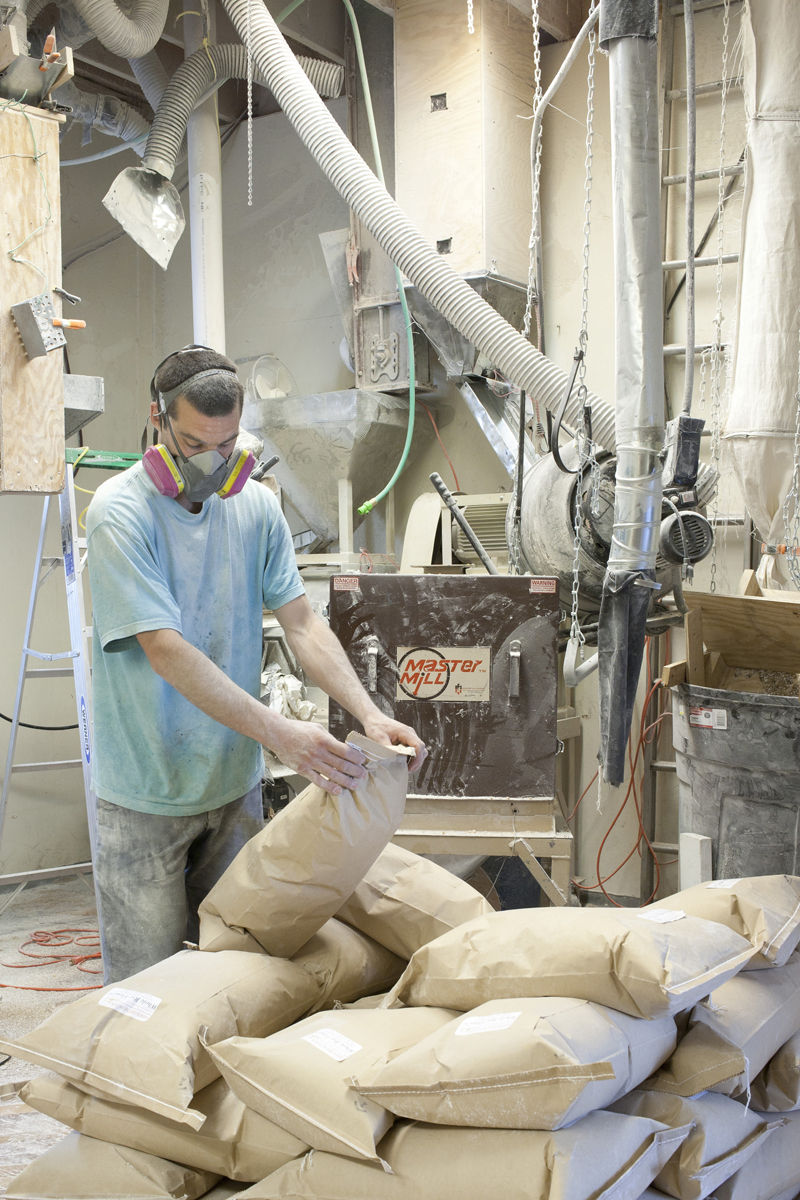
Greg Mol bags rye flour at Farmer Ground Flour
Located at the old Agway building in Trumansburg, the mill occupies a site where animal feed was milled in the past. In many ways, it is an ideal site for an enterprise that includes a lot of unloading grain from trucks and a lot of loading flour and other milled products back onto them.
Farmer Ground Flour has been very successful in meeting an emerging need for artisan-milled flours and meals in NYC. That is not, however, their only emphasis. They also sell flour and other milled products to the local market, through Regional Access, Greenstar Coop Natural Foods Market, and Garden Gate home delivery service. A recent edition of GreenLeaf[19], the newsletter of Greenstar Coop Natural Foods Market, showed the big-picture development of Farmer Ground Flour in historical perspective:
Farmer Ground’s success is part of a larger effort to restore grain growing to New York state. While now thought of as dairy country, upstate New York once grew so much grain that Rochester topped the nation’s flour production in the mid 1830s, giving it the nickname “Flour City.” (A later rise of nursery businesses changed that moniker to “Flower City.”) That flour was shipped to New York City and beyond via the Erie Canal.
Oechsner and Smith have both worked closely with Elizabeth Dyck, of the Organic Research and Information Sharing Network, which seeks to reintroduce wheat growing to New York state… [She] is working with farmers like Oechsner to identify those [varieties] that grow well in New York’s challenging climate, and, just as importantly, also taste great and bake well.
…Like other foods, “the flavor has been bred out of wheat,” [Oeschner] explained, in favor of yield and uniformity. “Growing the old wheat varieties is like growing an heirloom tomato.”
“Farmer Ground Flour is really making a difference for other farmers,” said Dyck. “They’re a great example of farmers banding together to put needed infrastructure into place, in this case a milling facility. They deserve enormous amounts of respect.”
No question, there is market interest, both regionally and locally, in the product of a local grain mill. But how does a small, “farmer-owned, grown, and ground” operation finance the necessary equipment purchases to keep up with the demand? Greg Mol, Erick Smith, and Thor Oeschner approached banks to seek financing for their equipment needs, but the amount of money that they sought to borrow was too small to fit the lending programs available. They have pursued working with individuals in the community to finance their equipment needs, but there is no organized program for doing so. The need for relatively small infusions of capital hampers their ability to expand and improve Farmer Ground Flour.
Will grain farming for human food expand in New York State only as quickly as the processing capacity is able to expand? Slow Money could be a means by which those interested in the re-development of grain farming in New York State could participate in the effort to develop the needed processing capacity. Greg, Erick, and Thor have already made connections with a few local investors to gain some access to expansion capital, and hope to do more of this in future. And the availability of their product has already spurred other business start-ups and more local investment opportunities. For instance, Wide Awake Bakery[20] operates a bread CSA using Farmer Ground Flour as an input.
Local opportunity number 3: Expanding Cayuga Pure Organics into rolled grains
Erick Smith is not only a partner in Farmer Ground Flour, he is also a principal of Cayuga Pure Organics[21]. Cayuga Pure Organics is the source of much of the “locally grown” beans and grains offered for sale in the Greenmarkets, co-ops, and restaurants of NYC. They also supply our local Tompkins County region with these products. Cayuga Pure Organics was also featured in a New York Times article this year, in the Magazine under “Field Report - Market Watch”[22]. This excerpt shows how Cayuga Pure Organics evolved to serve the niche market it now depends on, growing grains and beans for human consumption, to be sold in Tompkins County and NYC:
In 2003, Erick Smith and Dan Lathwell — men nearing 60 who’d farmed intermittently when not working at Cornell or teaching elsewhere — thought they’d hit upon a smart niche when they created Cayuga Pure Organics to grow pesticide-free feed for the region’s newly organic dairy farms. Two years later, the Ithaca food co-op and a natural-food distributor asked if they’d grow organic beans on their land in the town of Caroline. They were also connected with a local taqueria, and soon the two were struggling to keep up with the restaurant’s weekly order for 500 pounds of black and pinto beans. Then, in the fall of 2008, the farm inspector for New York’s Greenmarket tracked them down in her quest to find a grower to satisfy the demand for local beans and grains.
“We hemmed and hawed, thinking that going to New York City is a whole step up in the organizational process,” said Smith, an articulate man for whom overalls and a graying beard are a natural fit after years of teaching math education. It also required getting up to speed in marketing, which for farmers means both self-promotion and literally selling at markets.
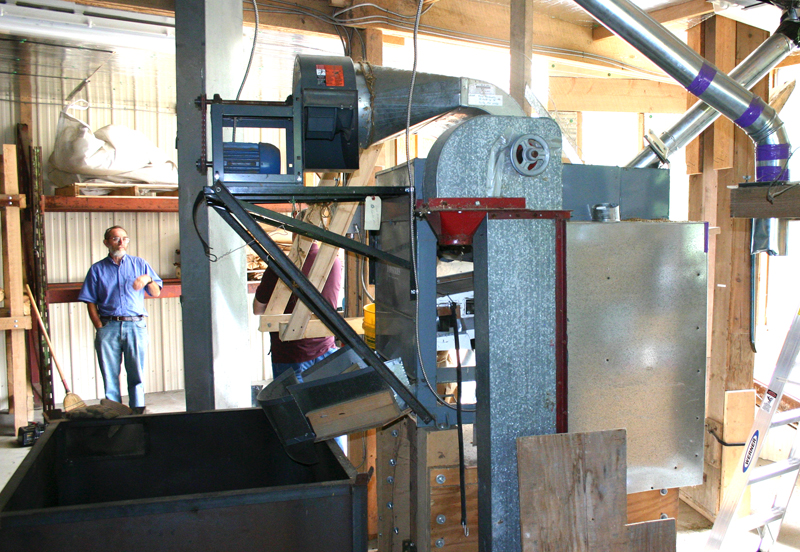
Owner Erick Smith with wheat cleaning equipment at Cayuga Pure Organics
Many of the processes for harvesting, shelling, and cleaning the beans and grains can be handled directly on-farm. Over time, Cayuga Pure Organics has become less dependent on other farmers for the use of processing equipment, streamlining the efficiency of the operation. However, specialized equipment for such tasks can be expensive, and it can be difficult to raise the capital needed to purchase it, house it, and integrate it into the operation. For some time, Cayuga Pure Organics has had plans to purchase equipment to be able to roll oats. Oats are a crop well-suited to our climate in Tompkins County, but they are almost always consumed by humans in the form of rolled oats, also known as oatmeal. Cayuga Pure Organics applied to the NYC Slow Money Group’s first Entrepreneurs Showcase to pitch the idea of investing in this business expansion. They were one of only ten businesses that will be featured in the first Showcase, giving them the opportunity to gain Slow Money investment for this business expansion.
Conclusion
The area between the growing consciousness on the part of consumers that they want to support a more localized food chain on the one hand and farmers who want to grow and provide local foods on the other is ripe with possibility to re-invent investment. While the shape of this emerging movement is not yet clear, the motivations of farmers, food processors, short-haul food transporters, and restaurant chefs are clearly aligned with those of investors with an interest in facilitating a more localized farm and food sector. The roles of regional investors, and the roles of local investors, will be established in part based on who steps forward to help shape the food web through investment and marketing. Perhaps, depending on developments, the Ithaca Hours local currency revival will also play a role. Establishing a farm and food sector in Tompkins County that is able to provide grains, beans, oils, meats, and dairy products to the metropolitan areas of the region as well as the local market seems a relocalizing strategy worthy of the investment of both thought and money.
Postscript from the Farmer: Erick Smith notes some additional benefits and hurdles
Erick Smith of Farmer Ground Flour and Cayuga Pure Organics read an early draft of this article and responded with the following note, which he has kindly given us permission to include here.
The basic products we produce are helping support others in the community. Farmer Ground Flour is one such startup. Another is Wide Awake Bakery in Mecklenburg… Ron Springer in Van Etten is using our grains to produce sprouted products including sprouted gain crackers, sprouted rolled grains, and sprouted breads. Also, Hans Butler, an Ithaca-based chef, is actively developing products from our beans and grains under the name: Cayuga Pure Organics, Chef Hans. He is currently producing the bean dips that are available at Greenstar and is in the process of developing other products. This year we are also growing mustard seed for Mary Graham, a local mustard producer. The point is that Cayuga Pure Organics and Oeschner Farms, as producers of basic organic commodities, provide the basis for other small-scale food processors to create their own products based on our locally-grown commodities.
A major struggle that both CPO and Farmer Ground Flour face is the lack of infrastructure to support what we are trying to do. 100 years ago, operations like ours were scattered across NY State and there was appropriate equipment, repair parts, local expertise, and market structures in place to support these operations. One of our technical and financial challenges is recreating this infrastructure in a modern world where few models are available.
Another major issue we both face is that, compared to conventional farms and conventional flour mills, we are very, very small-scale, yet from the perspective of many of the producers of local produce, we seem large. A major reason is that growing grains and beans and milling flour require a certain level of mechanization that forces certain economies of scale. So the tractors we use are small compared to what would be found on typical crop farms and the 40-year old combines we use for harvest are so small that the size machine we use is no longer even available new. To operate on a smaller scale would make our products prohibitively expensive. Yet, because we are so mechanized, we are very dependent on fossil fuel energy. Farmer Ground depends on electricity and the farms depend on diesel fuel. We know that this has to change and that we face a major challenge in creating that change. Greg is currently actively looking into the prospect of using water power to produce the electricity to run the mill. We currently are using about 10% bio-diesel and would like to use more, but the older diesel engines in our equipment can have problems with higher levels of bio-diesel. So, we know change is coming and may very well, at some point, be looking for ways for the community to support our efforts, both technically and financially. If the Slow-Food and Slow-Money communities are serious about supporting the needed changes for a local-foods economy, these are issues that we all need to be looking at together.
Further reading
Previous TCLocal articles on local aspects of agriculture, food systems, solid fuel (biomass) agriculture, and food processing have included the following:
2008.01.27: Fruits in a Post-Peak Tompkins County [http://tclocal.org/2008/01/fruits_in_a_postpeak_tompkins_1.html]
2008.12.09: Local and Urban Small Livestock and Poultry [http://tclocal.org/2008/12/local_and_urban_small_livestoc.html]
2009.02.25: Food Processing in Tompkins County [http://tclocal.org/2009/02/food_processing_in_tompkins_co.html]
2009.03.28: Examining the potential local foodshed of Tompkins County [http://tclocal.org/2009/03/examining_the_potential_local.html]
2009.06.16: Can New York State Feed Itself? [http://tclocal.org/2009/06/can_new_york_state_feed_itself.html]
2009.07.25: Visioning County Food Production, Part One: Introduction [http://tclocal.org/2009/07/visioning_county_food_producti.html]
2009.09.02: Visioning County Food Production, Part Two: General Problem Areas in Sustainable Agricultural Design [http://tclocal.org/2009/09/visioning_county_food_2.html]
2009.10.15: Burning Transitions [http://tclocal.org/2009/10/burning_transitions.html]
2010.01.20: Heating with Biomass in Tompkins County [http://tclocal.org/2010/01/heating_with_biomass_in_tompki.html]
2010.02.13: Visioning County Food Production, Part Three: Seeing County Food Production as an Integrated Whole [http://tclocal.org/2010/02/visioning_county_food_prod_3.html]
2010.04.26: Funding and Finagling the Transition to Biomass Heat and Power [http://tclocal.org/2010/04/funding_and_finagling_the_tran.html]
2010.05.31: Visioning County Food Production, Part Four: Urban Agriculture [http://tclocal.org/2010/05/visioning_county_food_prod_4.html]
2010.06.20: Visioning County Food Production, Part Five: Peri-urban Agriculture [http://tclocal.org/2010/06/visioning-county-food-prod-5.html]
2010.07.31: Visioning County Food Production, Part Six: Rural Agriculture [http://tclocal.org/2010/07/visioning_county_food_prod_6.htm]
2011.01.18: Health and Food Security [http://tclocal.org/2011/01/health_and_food_security.html]
2011.04.15: Chickens in the Energy Descent [http://tclocal.org/2011/04/chickens_in_the_energy_descent.html]
Notes
[2] http://www.slowmoney.org/book.html
[4] http://www.slowmoney.org/uploads/1/3/6/7/1367341/principles.pdf
[5] http://www.businessweek.com/smallbiz/running_small_business/archives/2009/12/big_ideas_for_2.html
[6] http://www.entrepreneur.com/article/217795
[7] http://www.utne.com/Politics/Utne-Reader-Visionaries-Woody-Tasch-Slow-Money-Alliance.aspx
[8] http://www.time.com/time/business/article/0,8599,1921889,00.html
[9] http://online.wsj.com/article/SB125305092106313571.html
[10] http://articles.latimes.com/2009/sep/22/business/fi-smallbiz22
[11] http://www.alternatives.org/cents.html
[12] http://localfirstithaca.org/
[13] http://www.regionalaccess.net/Home.html
[14] http://www.waterwayscouncil.org/study/public%20study.pdf
[16] http://www.groundswellcenter.org/
[17] http://farmergroundflour.squarespace.com/
[18] http://www.nytimes.com/2010/01/06/dining/06flour.html
[19] http://www.greenstar.coop/index.php?option=com_content&task=view&id=565&Itemid=219
[20] http://www.wideawakebakery.com/
[21] http://www.cporganics.com/live/
[22] http://www.nytimes.com/2010/10/17/magazine/17food-t-000.html
By Tom Shelley
Introduction
Birds and their eggs have been part of our food chain for tens of thousands of years. In hard times, birds and their eggs were survival foods. In the not too distant future, chickens will be a pillar of survival and resiliency as we proceed into what we believe to be a looming energy descent. Chickens are comparatively easy to raise and provide high quality meat and eggs all year round. Some writers prefer ducks,[1] and ducks are an important contributor to the small farm environment, but well-managed chickens are a better fit as an integrated component of a sustainable farming system.[2]
Raising chickens for eggs provides a highly versatile source of protein. Eggs can be stored for a reasonable period of time with relatively little energy input. They may be sold or traded for other goods. In her new book, The Resilient Gardener, Carol Deppe defines five crops you need to “survive and thrive—potatoes, corn, beans, squash and eggs.” This article will consider some of the parameters for raising chickens, explain how these parameters will be affected by the energy descent, explore some alternatives for current practices, and offer many questions still to be answered.
Which came first, the chicken or the egg?
In the energy descent, raising chickens first for eggs and secondarily for meat will be a preferred strategy, for three reasons. First, the nutrients in eggs are denser and more complete than the bird’s meat itself; second, eggs can be stored or preserved fairly easily for future use; and third, eggs have more versatility for food preparation than just the chicken meat itself. Mayonnaise, custards, etc., depend upon the chemistry of the egg to make a unique food product. Roosters, roughly fifty percent of hatchlings, are generally reserved for meat birds, as are hens that are no longer productive.
There are currently 113 breeds of chickens recognized by the American Poultry Association.[3] Many more varieties and strains of chickens are available, and the selection of the appropriate chickens can be a daunting task. Laying hens are selected for their egglaying productivity, length of their productive years, heartiness, body size, egg color, temperament, and other factors. I am familiar with Black Australorps, but Plymouth Rocks, Orpingtons, Rhode Island Reds and a number of other breeds are reliable egg producers. Some aids are available for novice chicken owners to help with breed selection.[4]
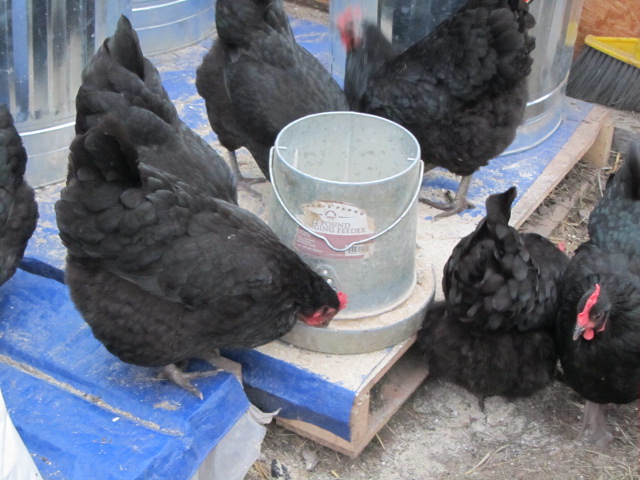
Figure 1. Black Australorps feeding
One distinct advantage of chickens (and many other fowls) is their ability to easily breed and brood eggs to make more laying hens. There are many devices that have been invented to incubate eggs to produce chicks. In the energy descent, especially during times of crisis, it may not be possible to incubate eggs with electrically powered equipment. Since it is fairly easy for chickens to produce and raise their own young, it is strongly advised that all small scale chicken raisers lean how to breed and brood their own chicks to ensure a sustainable supply of laying hens. Several good references for raising chickens from eggs have been published. One highly recommended book is Gail Damerow’s Storey’s Guide to Raising Chickens.[5]
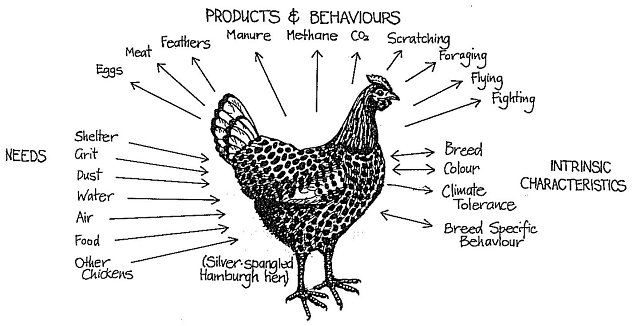
Figure 2. Selecting a breed (from [15])
Day-old chicks are widely available from many sources, local, regional, and national. They are going to be increasingly expensive in the future due to rising transportation costs and newer food security regulations. In a steep energy decline, the traditional regional and national sources may no longer be affordable or even available at all. We will need to depend upon home-brooding or smaller scale, local commercial brooding/incubation of chicks.
Housing options
Many beginning chicken owners have romantic notions of “free-range” chickens. Free-range chickens usually have at least a 50 percent loss rate due to predators. Also, the eggs of free-range chickens can be difficult to gather because they are often laid in hidden, inaccessible places, greatly reducing the useful yield of the flock. If you are dependent upon chickens and their eggs for a subsistence food base, “free-range” is not a good idea.
To maintain high levels of productivity and prevent predation, chickens must be watched over and, at a minimum, contained within a secure fence high enough to keep the chickens in the pen. An electrified fence powered by a small solar panel will prevent almost all small-animal predation. For an example of this type of fencing see [6]. These portable fencing systems, while not inexpensive, allow for frequent relocation of the fence to enable appropriate management of the areas being pastured. Netting the penned-in area may be needed to prevent predation from hawks. Chickens kept in fenced-in enclosures are said to be pasturing or “free-roaming,” but they are not free-ranging.
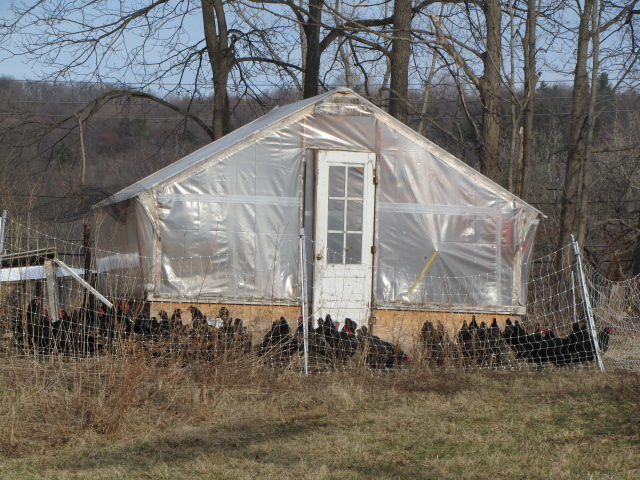
Figure 3. Chickens behind electro-net fencing
The construction and use of a secure chicken coop that is small-mammal proof is strongly recommended. Our chickens roost in their coop and are tightly closed in at night to prevent loss from predation and to provide shelter during bad weather, especially over the winter. Chicken coops can be made from a wide variety of materials, from hundreds of available designs. For examples, see [7].
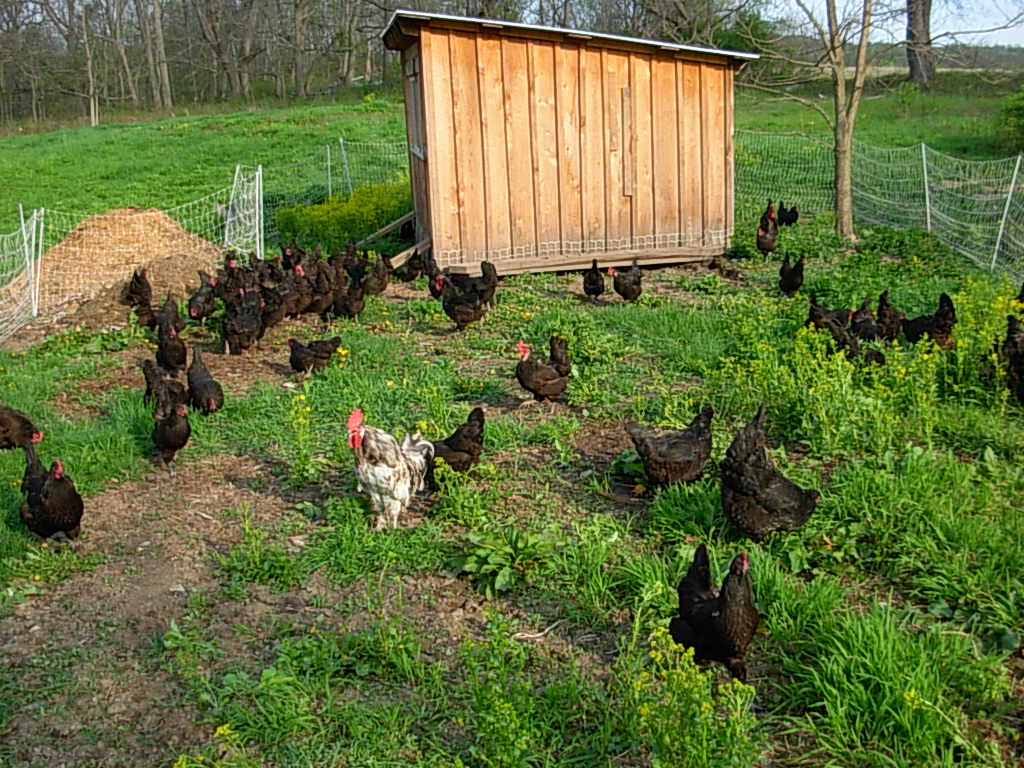
Figure 4. Chicken coop on skids
The use of chicken tractors is also very popular and greatly extends the functionality of having chickens while providing additional protection and security. A chicken tractor is a lightweight, moveable coop. Many designs are available, depending upon your use of the tractor and the number of chickens involved. Chicken Tractor, by Andy Lee and Pat Foreman,[8] gives extensive information on the construction and use of chicken tractors. Chicken tractors can be used to pasture chickens, with the tractor being moved to fresh grass as needed. If tightly constructed and installed, a chicken tractor will provide reasonable security against attacks by small predators. Our chicken tractors are a wood frame covered with chicken wire with a hinged piece of plastic sheet roofing material for a lid. The lid is normally hooked shut when the tractor is in use. Some people use small hoop houses for chicken tractors. You will see a wide variety of chicken tractors at [9].
The best use of the chicken tractor is to prepare an existing garden for planting. Six to ten chickens in one of our chicken tractors will eat everything organic down to the ground over a 4 x 8 foot area in 10 to 14 days, including all sorts of difficult-to-eradicate weeds and grasses. We then loosen up the area with a fork to remove the big roots of last years’ crops and weeds while mixing in the chicken manure and some additional compost. Other techniques are possible, such as working up a new garden plot or feeding specific home-grown crops to chickens.
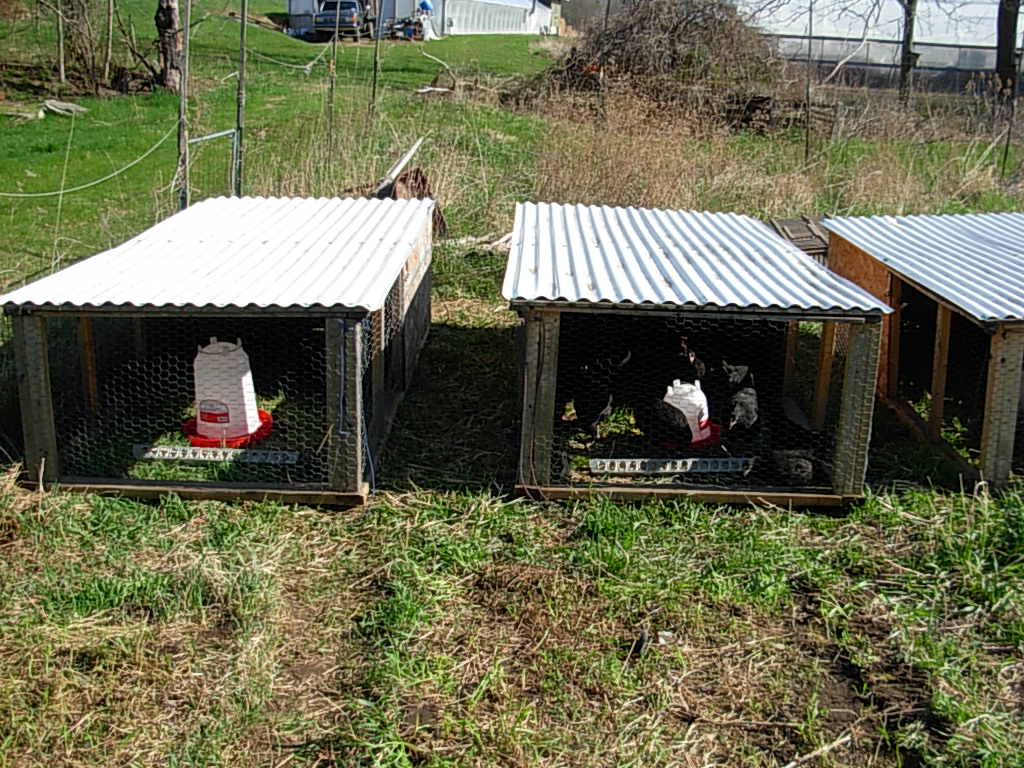
Figure 5. Chicken tractors in the garden
Food and Water
For many small-flock chicken owners, the cost of traditional grain- and soy-based feeds is 70 percent of the cost of the maintenance of their flock.[10] Commercial grain products used in chicken feeds consume vast amounts of fossil fuels in their production, processing, and distribution. Overall, agriculture contributes eight percent of the anthropogenic component of global warming gases. Even a modest rate of energy decline will have disproportional impacts on the cost of laying mash, pushing the price of chicken feed out of the range of feasibility for many small flock owners. This is already happening. A steep rate of decline would mean that nicely milled and amended layer mash in 40-pound bags may no longer be available at all.
Fortunately, for those who can develop a flexible and resilient approach to feeding chickens, many options to currently available commercial chicken feed are available. Chickens will eat almost anything, with some major exceptions (alliums and citrus in particular). If chickens are free-roaming and pastured and given a variety of supplementary foods, they will eat those foods that provide adequate nutrition. Many small flock owners feed mostly kitchen food scraps and some scratch feed (cracked corn or corn/wheat mix) and have healthy chickens and lots of great eggs. Owners of larger flocks cannot supply enough scraps to provide adequate nutrition, so they traditionally resort to commercially available feed mixes.
As the energy decline progresses, access to commercially available layer mash will be increasingly limited for the the small flock owner due to increased costs, limited access to some ingredients commonly used in commercial feed mixes, and other factors (the difficulty manufacturers may have in repairing or replacing equipment, for example). If land is available, many crops can be grown for chicken feed with low technology and few investments. Since chickens will eat everything from amaranth to zucchini,[11] there are many options, depending on the type of soil and the availability of water and nutrients (compost), seeds, labor inputs, etc. Carefully selected crops, most of which are human food crops as well, will allow for adequate nutrition for a flock of chickens over the seasons. Larger flocks are going to require large plots of land, with more grains and seeds to be grown and saved for the winter.[12]
Other local grain and feed options are readily available. For example, I have been purchasing “waste” grain products from Farmer Ground Flour in Trumansburg, New York. I mix supplements with the waste grain products and make a high-grade, organic layer mash. The carbon footprint of my homemade layer mash is significantly less than feed from other regional or national outlets. Other nearby grain mills have sold “seconds” or waste products to local farmers over the years for chickens and other farm animals. I anticipate that feed co-ops will develop to split up the rising costs of the components of feeds. Fish and crab meal, for example, are commonly used feed amendments. Being in the interior of the country, traditional sources of fish meal would be either very expensive or non-existent, depending upon the slope of the energy decline curve. Perhaps a local source of farmed fish for fish meal could be developed?
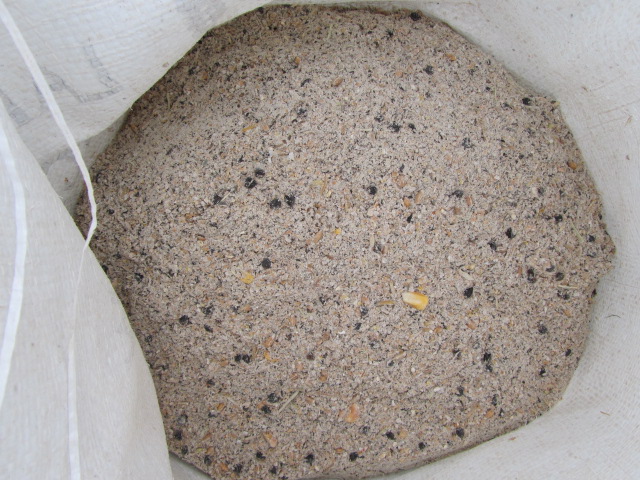
Figure 6. Locally made layer mash
Cooperative efforts to share resources for chicken feed would be very useful. Sharing bigger farming equipment, sharing saved seeds, and trading chicks to maintain diversity are examples. Chickens love milk, yogurt, and other dairy products. Apples, pumpkins, squash, and other fall veggies that store fairly well can be fed over the winter, providing diversity when pasture isn’t available. Waste vegetables from nearby farm stands can often be gleaned in the summer and fall, and they add value to the nutrient intake of your flock. Chickens love hay in the winter, and we have very local sources of organic alfalfa hay. Duckweed, which commonly grows on local ponds, is a highly nutritious chicken food (see the TCLocal article “Visioning County Food Production, Part 6” for more about duckweed in sustainable food production). Sprouted grains provide grass in the winter; I use oat grass, because oats are very inexpensive and germinate readily.
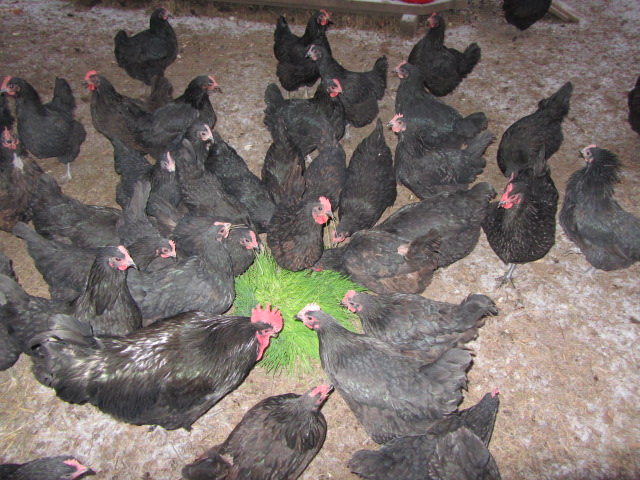
Figure 7. Chickens eating oat grass
Other options include feeding chickens active compost or certain insect larvae. Active compost has a high percentage of insects and other high-protein sources perfect for chickens. Some chicken farmers raise meal worms or black soldier fly larvae as chicken feed.[13] These techniques can significantly reduce the consumption and dependence upon grain-based feeds and their high fossil fuel inputs and large carbon footprint.
Chickens need a lot of water. Laying hens use up to two cups of water per day and even more in hot weather.[14] Water requirements are often higher in winter, when humidity is low and feeds and grasses are dry (hay, alfalfa cubes). The chickens’ water needs to be clean, potable water from a reliable source. Springs, wells, and urban water sources are all commonly used. In the early stages of energy decline, most of these sources will remain stable, although spare parts for pumps and wells may be hard to obtain at times. In a steep energy decline, energy sources and systems (delivery of public water supplies) will be disrupted or non-existent, parts will be impossible to obtain, and only secure natural sources (uncontaminated springs or wells) will allow for good quality water. Alternatives need to be developed. Clean rainwater catchment on a scale to water a modest flock is possible for most chicken owners.[15] The catchment and storage systems would need to be in place and functional when needed. Chickens can also drink from a clean stream or pond if one is available. Contamination from agricultural runoff, especially if you are raising organic chickens, and from animal wastes is of serious concern when using a stream or pond as a water source.
Other requirements for chickens are oyster shell and grit. Layer hens have a high calcium uptake, and the general recommendation, based on information from Lakeview Organic Grain, is 127 pounds of crushed oyster shell per ton of feed. The grit, needed to grind food internally, is most frequently sold as ground granite. Grit is free-fed; in a free-range or free-roaming situation most chickens will find all of the grit they need outside. Grit is most often fed in winter, when snow cover and frozen ground prevent normal foraging. Oyster shell will be more problematic, especially in a steep energy decline, and alternative materials and sources need to be found. Ground up egg shells provide one option, but this is a limited source.
Flock management
Many management issues will be affected by energy descent. Moving a coop from pasture to pasture is easy if you have an appropriately sized tractor and the fuel to run the tractor. If not, do you have a neighbor who owns a horse who will help you every two weeks or so? Some may elect to have their own horse; perhaps several nearby farms could share a horse and the expense of maintaining the horse. Building a coop with wheels would facilitate movement, perhaps only requiring a few strong people.
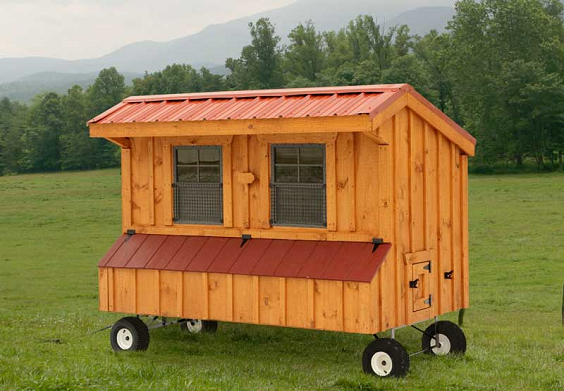
Figure 8. Coop on wheels
As the energy descent progresses and liquid fuels become more expensive, different business models will quickly evolve. We now deliver most of our eggs to our CSA customers. Perhaps there could be a central pickup point arranged for several customers in one area so as to save on fuel costs. Feed co-ops will develop to split up the rising costs of the components of feeds. Joint ownership of expensive equipment will enable a number of farms to thrive.
As eggs become an increasingly valuable component of our diets, food security issues become more important. There are well-established protocols for the handing of birds and eggs that reduce the possibility of contamination and disease transmission.[16] This is an area that is often poorly understood by small-flock owners.
Keeping chickens cool in summer and warm in winter is important. The use of solar heating and solar PV for other equipment will become increasingly important. If global warming increases at the rates projected, it may be necessary to change the breeds or varieties of chickens and other fowl to those that tolerate heat better than traditional breeds.
Attention to manure management will be especially important. Chicken manure is very rich in nitrogen and other nutrients. It may be composted or mixed directly into the soil. The appropriate rotation of fertilized pastured areas, gardens, and grain plots can maximize the inputs of chickens to the nutrient cycle. In a steep energy descent, most or all of our resources will come from the farm itself.
The management of breeding stock, the culling of poor producers, and other hands-on management issues will need to be addressed to maximize the long-term success of the flock. Health issues will may be more of an issue, especially in a steep energy descent. Our chicks come from Missouri, arriving with vaccinations for several diseases. Where would these vaccinations come from in the future? Very few vets know about chickens. Last year New York State defunded the state veterinarian position that has served the poultry industry in New York for several decades, so there is only thin support of flock health available going into the near future. How are we going to learn to be our own vets as far as our flock health is concerned? There are many challenges ahead.
Conclusion
Readers of this article may not live to see the hard times ahead, but their grandchildren certainly will. Chickens and other fowl will be an integral component of a resilient community as we enter an uncertain future.
References
[1] Deppe, Carol. The Resilient Gardener. Chelsea Green Publishing, 2010, p. 178.
[2] See the TCLocal series of articles on local food production by Karl North, beginning with “Visioning County Food Production—Part One: Introduction” (http://tclocal.org/2009/07/visioning_county_food_producti.html).
[3] See, for example, http://139.78.104.1/breeds/poultry/, from Oklahoma State University.
[4] See, for example, http://www.mypetchicken.com/chicken-breeds/which-breed-is-right-for-me.aspx.
[5] Damerow, Gail. Storey’s Guide to Raising Chickens. Storey Publishing, 1995. For additional general information see http://www.backyardchickens.com/lcenter.html and http://www.lionsgrip.com/pastured.html; Small-scale Poultry Keeping by Ray Feltwell (Faber and Faber, 1992); and the periodical Backyard Poultry (http://www.backyardpoultrymag.com).
[6] http://www.premier1supplies.com/c/poultry_supplies/electric_netting/
[7] http://www.freewoodworkingplan.com/index.php?cat=212. Sometimes the home page works better: http://freewoodworkingplan.com/.
[8] Good Earth Publications, 2006.
[9] http://home.centurytel.net/thecitychicken/tractors.html
[10] Storey’s Guide to Raising Chickens, p. 53.
[11] For example, http://steephollowfarm.wordpress.com/2009/06/18/chickens-like-a-lot-of-things/. See “Local Notes on Chicken Feed” (http://tclocal.org/docs/chicken-feed.pdf) for some ideas about local possibilities.
[12] See Logsdon, Gene, Small-Scale Grain Raising (Chelsea Green Publishing, 2009).
[13] See http://www.sialis.org/raisingmealworms.htm#timetable and http://blacksoldierflyblog.com/.
[14] Storey’s Guide to Raising Chickens, p. 60.
[15] See, for example, Mollison, Bill, Permaculture—A Designers’ Manual, 2nd ed. (Tagari Publications, 2004), pp. 165-170. A detailed overview of rainwater catchment techniques developed in third-world countries can be found in Gould, John and Erik Nissen-Petersen, Rainwater Catchment Systems for Domestic Supply (ITDG Publishing, 1999).
[16] http://www.eggsafety.org/producers/food-safety-regulations
by Karl North
This series of articles is an exploration of designs for agriculture in Tompkins County to approach sustainability in a future of declining access to the cheap energy and other inputs on which our industrialized food system relies. In earlier parts of this series, I proposed principles of agroecosystem design; addressed the key issues of fertility, energy, water, and pest control; and pictured the future county food system as a whole, including its historical context, implications, and the interdependencies among the parts that will make them most effective as an integrated system. I said that providing for the local food needs of urban populations requires a design that integrates three overlapping categories of production systems: urban agriculture systems (many small islands of gardening in the city center), peri-urban agriculture (larger production areas on the immediate periphery), and rural agriculture (feeder farms associated with village-size population clusters in the hinterland of the city but close enough to be satellite hamlets).
In this month’s article I will consider the needs and resources that will shape the design of future agrarian communities sharing a symbiotic relationship with the city of Ithaca and will offer a case study as a design example.
A general agricultural model
In rural parts of the county, space and other resources provide the opportunity to redesign agriculture most fully according to the general integrated system model described in Part Two of this series. Moreover, the many existing or reclaimable wetlands in the county offer the prospect of sustainable systems on the model exemplified in Part Two by the colonial farming system of Concord, Massachusetts. In colonial times, many agrarian communities in the Northeast made this grassland form of chinampa-style agriculture (Part Five) the core of their farming system. Communally managed wetlands were central because they sustainably produced the fertility that drove the system, indirectly via hay and thence manure, and directly from muck dredged from the canals:
These wetlands required considerable hydrological manipulation to make them productive, and they were transformed to a carefully managed resource in many towns. Extensive systems of drainage ditches, sometimes connecting for miles, rendered the meadows firm and accessible for teams during the mowing season, whereas dams, dikes, and road causeways provided hydrological control and augmented fertilization from natural flooding. Mowing, burning, and grazing, in combination with manipulation of the water table, shifted the composition of many wetlands from tree and shrub dominated to a cover of desirable grasses and sedges. The meadows returned a reliable yield of rather coarse hay, along with a rich muck that was cleaned from the ditches in the fall, dried, and carted to the barnyard or plow land.[1]
In land systems both wet and dry, grazing species such as the multi-functional cow formed the core of agriculture in colonial New England and sustainable agroecosystems in Cuba and elsewhere. They will likely be central to rural farming systems designed to survive the petroleum era.
A reconfigured social topography
Changes in rural land use, while not directly the subject of this essay, should be considered when envisioning a new plan for agriculture. If, like earlier societies that lacked fossil fuels, our society must use less energy to feed more people, it will require smaller, denser population centers with residences close to places of work. This constraint applies not only to cities such as Ithaca, but also to peripheral feeder towns and to the social topography of rural agriculture. In the US, cheap energy, cheap land, and the individualist ethic of “every man his castle” modeled on the European ideal of a landed aristocracy spawned a pattern of suburban sprawl on one hand and isolated farms on the other. In recent decades, the farms had to grow larger and even more isolated to survive in an agricultural economy where agribusiness multinationals exert monopoly control.
The traditional pattern in Europe is markedly different: apart from estates left over from feudalism, rural populations in Europe are even now clustered in agricultural towns and villages that include the farm residences and barns of many of the farmers who go out to work the surrounding land.
Energy descent planners in the US, including ecovillage advocates like Ithacan Robert Morache,[2] have made a strong case for converting to the European model of rural population centers, because, unlike suburban sprawl, this model clusters both farm and non-farm rural populations to make efficient use of energy, land, and transportation resources that link to nearby urban centers. Ideally, these farming villages, circled by their farmlands, will replace present configurations of land use, in particular suburbia and many of the remote farms operated on the industrial model, both of which are unlikely to survive the end of the oil era. Whether our society will have the material resources or the political will to make such a complete conversion is an open question at this point. See the TCLocal article Post-Peak Land Use Part 2: The Country for more detail on the farming village model.
Visioning a satellite farming village case: Lansing Landing
Imagine a once-thriving farming village connected to the county seat by good water, rail, and road transport routes that had in later times become a bedroom community. Now revived as a satellite ecovillage, buildings that serve a variety of agricultural, residential, and service functions are densely clustered in a hub surrounded by land devoted to diverse but related farming enterprises. Individual families and private cooperatives manage the enterprises within the general goals and guidelines set by the community and the county. Along with the community’s commercial agricultural output, many households are engaged in homesteading production from kitchen gardens and small-scale animal husbandry. The village is planned with a systems design, well illustrated in the permaculture movement, which uses both food and nonfood species for the greater health of the farming community and its ecosystem: it organizes them functionally, spatially, and temporally in a calendar with a decades-long time horizon to serve this goal.
Today’s ecovillages have made a start on the agro-integrated design that will be required here in the future. Figure 1, based on a study of the Ithaca Ecovillage, demonstrates some of the flows, interdependencies, and synergies that can be captured in a farming ecovillage designed as an integrated system.[3]

Figure 1. Ecovillage interdependencies (drawing courtesy of Jason Fleischer)
Lansing Landing builds on the example of many ecovillages today, but aims for a higher standard of sustainability, including the need for greater heat and energy self-sufficiency; affordability (many ecovillage dwellings are too expensive for the average person); diversity of functions, including farming as the core function; and more complete recycling (how many ecovillages collect and process night soil?). Some of the components and functions present in the community envisioned here attain the high level of integration planned for an agricultural community in the United Kingdom by the Institute for Science in Society, as illustrated in Figure 2.[4]
Figure 2. Functional integration in a planned agricultural community
Fertility. Open, sloping land plays an important role in the village agroecosystem. As described in Part Two, animals graze a hillside system[5] of perennial forages dotted with food-producing trees. Hedgerows crisscross this landscape, surrounding fields and carving them into enclosures of appropriate size. Hedgerows serve many functions: shelterbelts, perennial food species, and fences. They stop erosion, and by so doing even begin the process of reshaping hillsides into arable terraces. Figure 3 is an example of terrace formation from Cuba.
Figure 3. A hedgerow in Cuba stopping soil movement on a slope
The grazing animals participate in a fertility scheme where a surplus of manure is built up as bedding packs in barns where stock is overwintered, then processed in the main village vermicomposting center. This fertility scheme is the foundation of village wealth production, and so ultimately determines its quality of life. Farmers also use the grazing animals to optimize biomass production in row crop acreage whenever the acreage is in a grass rotation.
Along with biodigested humanure from the village and the city of Ithaca, applications of compost made from winter livestock manure and bedding create the tight nutrient cycling that builds and sustains the fertility of the land. Manure and village sewage that is more conveniently handled as liquid is fed through a fuel-producing biodigester, then solids separators followed by cleansing ponds that grow duckweed for high protein animal feed, and finally back to fields as in Figure 2. Village farmers use a sophisticated scheme of fallows, rotations, and winter- and roller-killed cover crops to further control fertility and weeds with minimal tillage.[6]
Water and wood. In Lansing Landing, ponds have been placed high on the hillsides to capture spring water and runoff for many uses: village and livestock supply, water power, and irrigation, to name a few. Lower ponds recapture water for additional uses: recreation, fire protection, and a village reserve. They function as part of a water management array of berms or swales, like the keyline plan described in Part Two, that keep water working within the watershed as long as possible.
Drawdown of forest resources to the point of crisis occurred repeatedly in European and U.S. history before the oil age, when biomass was the main source of energy. Forest cover in Tompkins County dropped from almost 100% in 1790 to 19% by 1900, then increased to 28% by 1938 and to over 50% in 1980.[7] Most of the loss of forest cover can be attributed to a combination of logging for firewood and timber and clearing for livestock production and other agriculture. The much bigger present county population will make far greater demands on forest resources. It would be mistaken, therefore, to assume on the basis of current forest cover that the county can rely on wood for its future energy needs.
The village actively manages enough forestland to do its part in providing county forest product needs, among which firewood for heat and timber for shelter are paramount. By replacing the extremes of no management and monoculture that were luxuries typical of an earlier era, active management stimulates both biodiversity and production in a balance to achieve a wide range of agroforestry goals. Many forests are maintained on ridge tops and uplands for the health of the watershed. Groves near the village center create useful microclimates, temper prevailing winds, and provide for recreation.
Food and Fiber. The imperative of energy efficiency has gradually reconfigured land use in this village to cluster the more intensive agricultural activities in the flat, most fertile land ringing the village center. This circle contains the rotating fields of starch staples, vegetable polycultures, meadows for the most intensive animal husbandry, and fibers like hemp and flax. Its output of foods and fibers that traditionally grow well in the region help ensure the food security of the county.
Crops like flax and hemp, which produce fiber, oil, and other ingredients of manufactured products such as paper, clothing, paints, and preservatives have reappeared as competing petroleum products have disappeared and competition for forest products has increased. Different parts of the hemp plant produce flour and oil for food, paper, and composites, including boards that reduce logging pressure on forests, rope and cloth, lubricants and other petrochemical substitutes, and important nontoxic medicines. Hemp productivity per acre is four times that of sustainably harvested wood, and twice that of cotton-without cotton’s need for pesticides.[8]
Not far from the village is a wetland modified with canals and ponds to grow aquaculture crops. Because of the constant source of crop water, the wetland system is an anchor that guarantees a reliable source of forage and bedding for livestock both in the village and in the peri-urban animal enterprises.
Part of the wetland has been developed into a true chinampa-style production system. As described in Part Two of this series, the chinampa configuration of aquaculture in canals surrounding raised fields is integrated in a way that ensures higher productivity over dry-land agriculture. While most examples of this system come from Central America and Southeast Asia, the system has also succeeded in northern Japan in a water-moderated climate similar to ours in Lansing Landing. Figures 4 and 5 from Japan demonstrate some of the possibilities.[9]
Figure 4. A rice-fish-duck-azolla system. Azolla (duckweed) is a floating fern that fixes nitrogen and produces protein
Figure 5. Material cycles of azolla + loaches + ducks + rice. The system produces rice, duck meat, duck eggs, and fish for a small input of feed
The core of village livestock husbandry is the dairy enterprise, much of which has returned to the energy-efficient model of seasonal, grass-fed milk production from the hillside pastures and hay fields. Breeds chosen to fit the system are hardy, dual-purpose, and smaller than the energy-intensive breeds of the industrial agriculture era that were designed to maximize production at any cost. Cows, sheep, and goats are pastured along with work mules and horses in a multi-species grazing system that benefits from the complementary grazing functions of the different species. Dairy and crop byproducts sustain some pig and chicken production. The level of animal production is determined by the role of animals in supplying ecological services to the community’s agriculture, not by county demand for animal food products, which is currently excessive and unhealthy. At Lansing Landing, the level of production of animal foods is closer to what is needed for a healthy human diet.
Like animal genetics, the genetics of the crops grown by the village have changed to reflect the exigencies of the post-petroleum era. Instead of hybrids that sacrifice local seed control and the resilience that a large gene pool provides, village farmers, employing traditional selection methods, have developed open-pollinated seeds that they can save and share. While yields from savable seeds can rival the productivity of hybrids[10], village farmers have selected for both plant and animal types that balance productivity with traits like hardiness and other low-maintenance characteristics.
Village Enterprises. Even closer to the center, to be within walking distance of their workers, are animal and crop barns, village-scale composting and biogas digester sites, tool manufacture and repair shops, and other agricultural support facilities. One example is a piggery used to turn compost. Fed largely from dairy byproducts and kitchen garbage, its manure in turn feeds a small biogas generator like the one in Figure 6.
Figure 6. Biodigester made with one layer of plastic tubing 1.2 m in diameter and 6 m long, connected to a pig pen with 20 animals and fenced with Mulberry tree. Finca Ecológica Tosoly, UTA Foundation, Guapotá, Santander, Colombia. Photo: Lylian Rodriguez
Processing plants that preserve raw farm products while reducing water content to make them more transportable are village enterprises that serve an important function in the county food system. Examples include the conversion of milk and fruit to aged cheese and preserves and the lumber-drying sheds at sawmills. Near the center of town is the village recreational fish and skating pond, one of the ways a stream running through the valley has been harnessed.
One of the important functions of the village is to recruit and train new farmers from the urban population to run the more labor-intensive agriculture of the new era. An educational complex serves as a public school for the village, an agricultural research and farmer training center, a farm camp for urban youth, and an adult farm camp for harvest volunteers and vacationers from Ithaca. In turn, the village draws on urban populations for short pulses in labor needs, like haying and other harvest activities that must be accomplished in a brief window of opportunity.
Rural agriculture and the county food supply
This series has described three types of area agriculture needed to sustain a county population of 100,000: urban, peri-urban, and rural. Of these, rural agricultural systems will be of primary importance. Urban and peri-urban gardens can provide quantities of fresh vegetables and fruits, but only rural farms have the space to grow enough of the starchy staples like potatoes, grains, beans, and rice that have historically supported urban population densities. Moreover, only rural farms can supply enough of the materials like oils, fibers, and wood that are basic necessities in our cold climate. Agrarian villages, not the urban center, will again become the heart of a relocalized county food system in the coming years.
Notes
[1] Redman, Charles L. and David R. Foster. Agrarian Landscapes in Transition: Comparison of Long-Term Ecological and Cultural Change. Oxford: Oxford University Press, 2008.
[2] Morache’s plan of village clusters in the urban hinterland includes farms, residences for urban workers, and enough commerce to support a population of 450 households. www.chrysalisconcordium.org
[3] A contribution from of one of my students, Jason Fleischer, in a college course on ecological agriculture.
[4] http://www.i-sis.org.uk/DreamFarm2.php
[5] North, Karl. “Optimizing nutrient cycles with trees in pasture fields.” Leisa Magazine, 24/2, June 2008. http://www.leisa.info/index.php?url=getblob.php&o_id=209102&a_id=211&a_seq=0
[6] Pioneered by Pennsylvania vegetable farmers Anne and Eric Nordell and archived in their ongoing column, “Cultivating Questions,” that dates from the 1990s in The Small Farmers Journal, Sisters, Oregon.
[7] Bryce E. Smith, P. L. Marks, and Sana Gardescu. 1993. “Two Hundred Years of Forest Cover Changes in Tompkins County, New York.” Bulletin of the Torrey Botanical Club, Vol. 120, No. 3 (Jul. - Sep., 1993), pp. 229-247.
[8] The 1995 documentary film Hemp Revolution. Anthony Clarke, director.
[9] Furuno, Takao. The Power of Duck. Tasmania: Takari Publications, 2001.
[10] Berlan, Jean-Pierre and R.C. Lewontin, “The Political Economy of Hybrid Corn.” Monthly Review, July-August 1986.
by Karl North
This series of articles is an exploration of designs for agriculture in Tompkins County to approach sustainability in a future of declining access to the cheap energy and other inputs on which our industrialized food system relies. In earlier parts of this series, I proposed principles of agroecosystem design; addressed the key issues of fertility, energy, water, and pest control; and pictured the future county food system as a whole, including its historical context, implications, and the interdependencies among the parts that will make them most effective as an integrated system. I said that providing for the local food needs of urban populations requires a design that integrates three overlapping categories of production systems: urban agriculture systems (many small islands of gardening in the city center), peri-urban agriculture (larger production areas on the immediate periphery), and rural agriculture (feeder farms associated with village-size population clusters in the hinterland of the city but close enough to be satellite hamlets).
In this month's article I will consider the needs and resources that will shape the design of peri-urban agriculture systems around the city of Ithaca, and offer a case study as a design example.
Figure 1. Cooperative farms on the edge of Havana, Cuba
Cities are often ringed with suburbs, parks, and industrial and commercial zones that can be converted to larger, more integrated agricultural systems than densely populated urban neighborhoods (Figure 1). Deer and rodents have proliferated in the urban-suburban boundaries that are excellent edge habitats for these species. Agriculture in these areas will need to achieve deer and rodent control by fencing that is effective against jumping and burrowing and by regulated trapping for meat and hides to eventually reduce populations.
The best candidates for conversion to farming are sites that have good soil and water resources yet are close enough for easy access by urban consumers and potential farm labor. Two such areas on the periphery of Ithaca are the flood plain beside the lake and inlet and the nearest locations on the main existing transport routes, particularly those with existing rail lines, north up the east edge of the lake and south along route 13.
The flood plain
One-sixth of 19th-century Paris was devoted to intensive urban gardens, prominently in the Marais (wetland) on the right bank of the Seine River. Fueled by manure from the city's thousands of working horses, peri-urban gardens fed Parisians with greens, vegetables, and fruits the year around. The history of a similar district on the edge of climatically similar Ithaca indicates its food production potential. This neighborhood was once home to a distinctive waterside community of fisher-farmers who, despite their lower socio-economic status compared to some Ithacans, were able to achieve relative self-sufficiency on the rich alluvial soils and aquatic resources of their neighborhood.
Ithaca has a unique resource in these lakeside and inlet soils. They are potentially the most productive agricultural land in the county when converted to the chinampa-style systems described in Part Two (Figure 2).
Figure 2. Mexico City chinampas
Some of this land may now be “brown fields” of soils that are polluted from years of commercial and industrial use but can be reclaimed biologically. Bioremediation can take various forms. Several years of intensive grazing and repeated trash plowing and replanting of grass cover not only builds soil organic matter rapidly but cleanses it as well by bacterial action as the soils become more biologically active. Instead of normal plowing that buries sod, trash plowing upends it for fast aerobic decomposition. If this is insufficient, raised beds with imported soil are a solution that has worked in many urban locations.
Land use policy for the district would have to change to reflect the food production priorities of the energy descent. Some lands now dedicated to industry, the commercial strip of big box stores, and parts of parks and the golf course will be acknowledged as prime farmland. Figure 3 illustrates examples of potential waterside farm sites.
Figure 3. Examples of potential waterside farm sites on the edge of Ithaca
The politics of conversion of water-side lands to prime food production sites will require a new mindset. Agriculture may be the best use of some of the land now devoted to recreational activities like sailing, picnicking, and golf. Consumers accustomed to shopping in national chain stores will need to learn that they represent what Wendell Berry in The Unsettling of America called an extractive, colonial economy. This economy transfers wealth to metropolitan centers of power from rural peripheries and operates at many scales, from impoverished banana republics like Nicaragua, to shrunken agricultural towns in Nebraska, to the depressed areas of upstate New York. Thus the national chain stores that ring the Ithaca periphery are economic “monocultures” that strip economic wealth from the county just as agricultural monocultures drain fertility from the soil.
Transport route locations
Conversion to more sustainable food production requires more people living closer to food production in order to provide labor and to facilitate nutrient recycling. Energy descent writer Richard Heinberg estimates the need for 50 million farmers in the U.S., up from 2 million today.[1] In a similar assessment, Swedish systems ecologist Folke Günther estimates that the rural farming population needed to support an urban community should be 12 times the urban population. The starting point in our case is a county population of 100,000, of which 30,000 is urban. To achieve the necessary balance, Günther suggests relocation of some urban and close suburban populations to clustered housing in satellite farming villages[2] as older urban housing is replaced by urban gardens. The most economical location for some of these peripheral ecovillages might be in the peri-urban agricultural district along the main transport routes near the city.
Ideally this process would be part of a general physical redesign of both the urban and hinterland communities according to the model that emerged in Europe, where centuries of higher population densities have dictated more careful land use planning. Even today, European towns large and small are characteristically dense clusters of buildings that end abruptly in agrarian vistas.
Visioning a peri-urban case: Waterside Gardens
Commercial strips and malls that typify the urban edge, vacated in the shrinking national economy, are prime candidates for a public takeover that would convert their parking lots to agriculture and the empty buildings to farming and related community uses. To exemplify this conversion, we will envision a farm operated as a commercial cooperative, using a future abandoned Wegmans waterside parking lot and supermarket building (one of the locations outlined in Figure 3). Let's call our imaginary cooperative “Waterside Gardens” (Figure 4).
Figure 4. Waterside Gardens (artist's conception by Jane North)
A policy framework. The dirty little secret of small farms is that they don't make much of a profit in competition with industrialized agriculture. A food policy framework guarantees the economic viability of Waterside Gardens:
- As part of a county-wide green belt policy to stop and convert urban sprawl, the city has remunicipalized most of the inlet area from the lake front to Buttermilk Falls, providing a free lease to co-ops like this one as long as they continue to build food security and food sovereignty in the county.
- In the wake of widespread demand for local food sovereignty, the country has revised the Constitution. As part of a growing reliance on local, county-wide economic policy making, a tariff is now levied on food coming into the county based on food miles and the ability of local agriculture to provide the product.
- A trolley stop on the public light rail line serves the site to bring agricultural inputs to the co-op and consumers to its retail food market.
Models of ecological health and productivity. Waterside Gardens incorporates two highly productive models of small-scale agriculture that have proved themselves to be effective historically in peri-urban agriculture: chinampa-style canal-side gardens (Mexico city)[3] and the French intensive market garden (Paris).[4]
In the gardens that use the inlet directly, hydrologically controlled subcanals between garden beds divert water from the adjacent inlet canal. These alternating strips of water and land crops are managed to make the system highly productive in several ways:
- Constant sub-irrigation of the growing beds;
- Aquaculture production from a self-feeding, integrated system of water plants and animals;
- Surplus fertility from the aquatic system in the form of muck dredged periodically from the canals for the adjacent bed soils;
- Temperature stabilization from the waterways that improves daily crop growth and extends the growing season.
Farther from the water lie the frame and cloche beds characteristic of the French intensive method. Despite the development of biomass-based plastics, competition from higher priority biomass uses like food and heat has prompted a return to the French tradition of glass for frame covers and the bell-shaped cloches that create the microclimates to protect beds and individual plants.
Windmills pump canal water into raised tanks to provide a constant reserve of gravity-fed irrigation water. Adjacent ponds capture and biocleanse storm water that runs off the city's hills, constituting a water reserve that makes the system resilient to drought.
Another input essential to the intensive method is a constant and copious supply of fresh manure that is placed under and around frames and cloches to maintain growing temperatures in these all-season gardens. Initially the only manure source was the small population of livestock that peri-urban production systems can integrate. However, diminishing supplies of fossil fuel and limited supplies of local fuels like biogas from municipal black water processing have driven local transportation partially to rely on animal power. A growing mule population now transports people and produce around the county, much of it efficiently on the rebuilt light rail network. Like other peri-urban farms, this one provides stables for some of the mule contingent in return for the steady supply of hot manure. Their hay is transported by water directly into docks at the garden site from farms around the lake.
Wind protection is part of the intensive gardening system. The old supermarket and the high hedges on the northeast and northwest edges stop the coldest prevailing winds, and low walls throughout the gardens reduce wind at plant level while letting in sun.
While much of the French system is possible in urban agriculture, peri-urban spaces allow its full development as it originally functioned on the outskirts of Paris. This is because its year-round production requires quantities of hot manure as well as the constant attention of full-time gardeners highly skilled in the careful timing of watering, frame and cloche ventilation, and protection of frames from sun and cold. This garden recaptures the full knowledge- and management-intensive qualities that made the Paris market garden system so successful.
A more extensive system. The co-op includes a third, more extensive gardening system to grow crops like roots and tubers that need more space and to integrate small animal production. To fertilize this garden, the co-op manages a facility in which pig turners enhance the vermicomposting of part of the city's segregated organic waste stream.
Originally judged a brownfield, the soil of this part of the market garden spent its first years of conversion to agricultural quality under intensive grazing alternated with heavy applications of compost seeded with fast growing forages in the cleansing process described earlier. Now it consists of beds long enough to be worked by some of the mules housed in the co-op and grassed alleys wide enough to permit farm vehicles and grazing with rabbits and poultry in movable pens, as illustrated in Figure 5. In season, the rabbits thrive on an all-grass diet, and feed for the poultry is supplemented with part of the garbage and worms from compost production. The alleys are lined with composting sheds to which the poultry have access as their grazing pens are moved along the alleys. In all seasons the pigs, poultry, and rabbits consume the co-op's garden waste as one of their roles in the system.
Figure 5. Grass-fed rabbit production at Northland Sheep Dairy, a farm near Tompkins County
The old supermarket now serves many new functions. In addition to the stables, it houses farm tools and machines and harvest and feed storage areas. It also includes community centers to market products from adjacent community gardens, train new farmers, and house full-time farm workers and food processing centers. The south front is a passive solar greenhouse that heats the building and grows vegetable and nursery transplants for the rest of the farm.
Boundaries of the tripartite farm as well as individual beds are specifically designed for multiple functions. They include habitats that attract beneficials and trap pests before they reach food plants; bird and bat houses; flowering plants to attract pollinators; food bearing bushes, trees, and trellises that act as shelter belts against wind and sun; and walkways and benches to function as a parkland that brings urban residents into contact with the gardens.
As with much of peri-urban agriculture, the size of this co-op creates heavier seasonal labor needs than city gardens. With a large city population close at hand, however, it manages to attract enough seasonal workers by paying them with credits they can use when they purchase the food products of the enterprise.
Notes
[1] http://www.energybulletin.net/node/22584
[2] http://www.holon.se/folke/lectures/Ruralisation-filer/v3_document.htm
[3] http://en.wikipedia.org/wiki/Chinampa
[4] Weathers, John. 1909. French Market Gardening. http://ia331426.us.archive.org/3/items/frenchmarketgard00weatrich/frenchmarketgard00weatrich.pdf
by Karl North
This series of articles is an exploration of designs for agriculture in Tompkins County to approach sustainability in a future of declining access to the cheap energy and other inputs on which our industrialized food system relies. In earlier parts of this series, I proposed principles of agroecosystem design, addressed the key issues of fertility, energy, water, and pest control, and pictured the future county food system as a whole, including its historical context, its implications, and the interdependencies among the parts that will make them most effective as an integrated system. I said that providing for the local food needs of urban populations requires a design that integrates three overlapping categories of production systems: urban agriculture systems (many small islands of gardening in the city center), peri-urban agriculture (larger production areas on the immediate periphery), and rural agriculture (feeder farms associated with village-size population clusters in the hinterland of the city but close enough to be satellite hamlets).
In this month’s article I will consider the needs and resources that will shape the design of urban agriculture systems in the city of Ithaca, and offer a case study as a design example.
The high institutional and population density of urban areas promotes labor-intensive production methods, community regeneration through cooperative management, and transport efficiency for agricultural inputs and products. The ability to have more farmers per acre permits the kind of management-intensive system that maximizes productivity through close monitoring and good timing throughout the growing season. Increased headcount allows a division of labor to manage diversified production integrated into one system. One neighbor could grow rabbits (Figure 1) and provide manure and meat while another grows vegetables and a third concentrates on fruits.
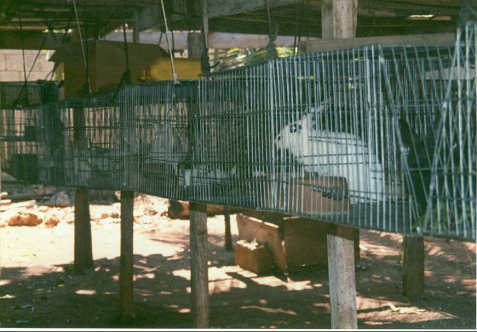
Figure 1. Urban rabbit hutches in Cuba
The abundance of city institutions presents opportunities to build gardening appendages on existing social structures organized for other purposes. In the sudden energy shortage that transformed Cuba’s agriculture, schools, workplaces, and even governmental institutions were quick to become partly self-sufficient in food production. As awareness builds that gardening is a form of physical education whose value increases relative to, say, football, schools will see the need to devote more playground space to school gardens.
Intensive Design
The high productivity of urban agriculture has proven itself in many cities, notably in the severe food crisis that Cuban cities experienced in the 1990s.[1] Productivity in urban agriculture comes in great part from intensive design and management. The greater labor required for intensive production is potentially available in urban agriculture and can make it highly productive in several ways. Space can be used more efficiently than in extensive row cropping. Intensive growers can plant many vegetables in permanent beds instead of rows, minimizing walk or machine alleys between rows and concentrating soil building in the beds rather than the whole field. Also, farmers can plant crops of fast maturing foods, like salad or cooking greens, in spaces between large, slower maturing ones like broccoli. This practice of planting so-called catch crops makes more intensive use of limited space during the growing season. Tiered design that uses light efficiently is possible. Crops can be grown in companion polycultures to trade ecological services; legumes like pole beans fixing nitrogen for the corn that provides the pole, or a row of peas climbing a wall while fertilizing a row of carrots. Maximum use and close management of protective devices like frames and cloches permit not only season extension but also more effective temperature and moisture control of plant growth during the regular season. Finally, the consumers of urban-grown food are close enough to permit effective recycling of nutrients into the garden soil via backyard compost piles and composting toilets, partially or totally eliminating the need for space for compost crops.
For these reasons, urban spaces can be nearly 15 times more productive than rural farms.[2] In World War II, residential “Victory gardens” in the US produced a quantity of fresh vegetables equal to the total commercial output of these foods.
The Ithaca Urban Environment
Ithaca’s topography of central flatlands surrounded by steep hills presents distinctive opportunities and constraints for urban garden design in each area. Josh Dolan’s map of current and potential community and school garden sites in Tompkins County illustrates some of the possibilities.[3]
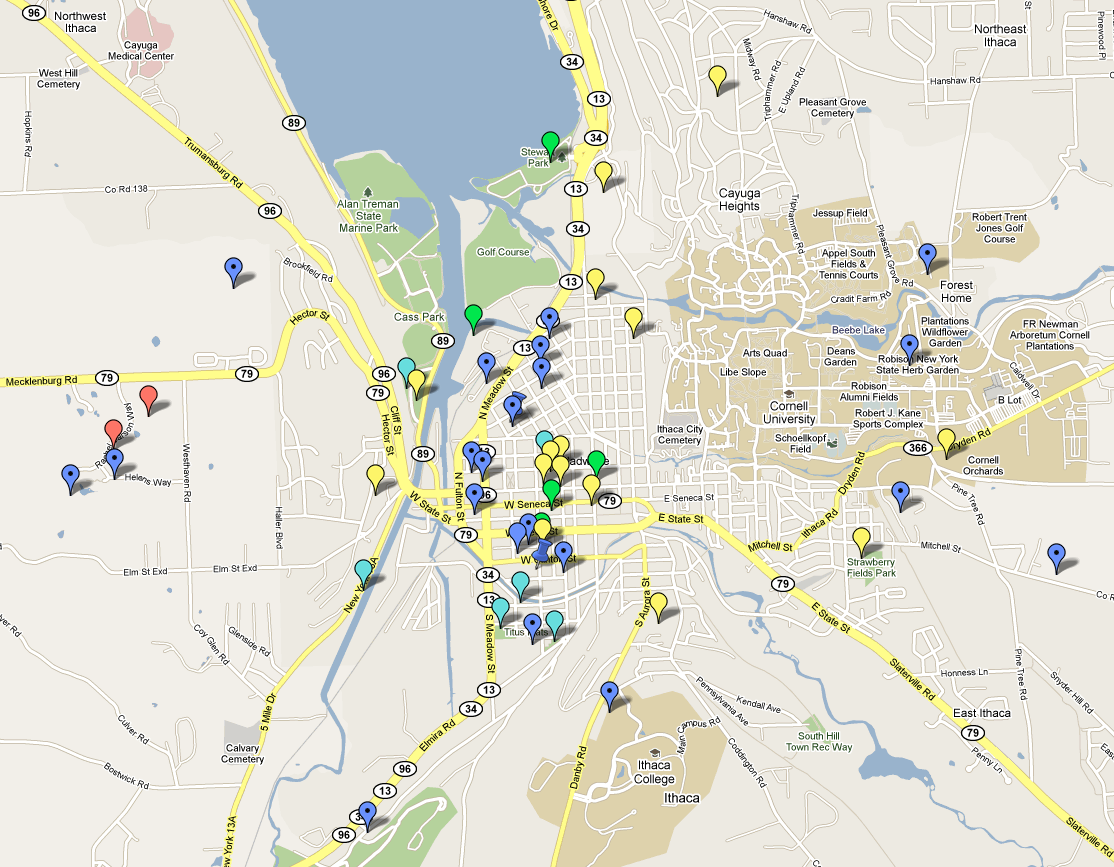
Figure 2. Community and School Gardens of Tompkins County. Blue = community gardens; yellow = school and educational gardens; green = farmers’ markets; light blue = sites that have expressed an interest in gardens or have been identified as potential sites for new community gardens. Click or see link in footnote for more detail
On the hillsides, some food production will require terracing, but the many south and west facing retaining walls and house walls in residential neighborhoods on Ithaca’s steep hills provide opportunities for vertical growing. This will maximize use of space, which is important in urban gardens. Vine plants can sometimes grow either from the top of the wall down or from the bottom up. Twine or poles laid against the walls help plants like tomatoes and beans get a grip going up, and planks or slates shoved between wall stones support heavy fruits like melons or squash as they grow bigger.
Projections of climate change for the Northeast include a 20 to 30 percent increase in winter precipitation over this century, but hotter summers when water is needed for growing, suggesting a greater need for seasonal water capture.[4]
The hills of Ithaca have great potential for gravity irrigation if water is distributed downhill through many residential gardens. Pools at each site can store water to provide gravity irrigation to terraces via berms and swales. Institutional sites might justify tapping this gravity flow to power small grain mills or electric generators.
On the city’s flatlands, current uses of many commercial sites will become obsolete in the energy descent. Energy inefficient businesses and parking lots will become prime sites for takeover by guerilla gardeners, building pressure for legalization. Water is relatively abundant in our environment, but because of its importance for highly productive food growing, water reserves collected from roof drains into garden-side irrigation pools will be vital to build resilience into urban production systems[5]. More resilience can be achieved by routing roof water into attic or upper story tanks for household use and then channeling the overflow into irrigation pools.
Visioning an urban agriculture case
A group of neighbors has decided to form a loose gardening cooperative, because a pooled effort will solve the core production problems of fertility, water, pest control, and energy more efficiently than would completely individual projects as well as promoting the sharing of equipment and pooling of knowledge. In individual backyards they have been growing a few vegetables and fruits, often in containers they can bring inside for extended season growing[6]. Many neighbors have enough small stock such as rabbits, chickens, and pigeons to process organic kitchen garbage; however, their yards are mostly too small for the amount of food they want to produce as a co-op.
The neighborhood group has agreed to devote most backyard space to compost production and the collection of irrigation water for the co-op. They have quietly attached composting toilets to their houses and built filter/digesters for household greywater and little ponds to store greywater and roof water, while currying support for legalization when the time is politically ripe. Eventually the city created property ownership and lease contracts with management agreements that provide incentives for ecological management, like composting of residential waste streams and maintenance of food perennials on the property.
To make space for the main garden the neighborhood co-op razed a building abandoned as too costly to renovate for energy efficiency, and depaved an adjacent parking lot that became obsolete when the city got serious about public transportation. The land owners were happy to lend the properties in long-term agreements because the city had created land tax credits for land lent for urban agriculture. As in the urbanization of agriculture in Cuba (Figure 3), our neighborhood co-op often left rubble in place and created raised beds over it with soil imported from nearby rural farms and compost from backyard and municipal production sites. This photo also illustrates the use of a pest insect trap crop of corn planted at the end of the raised beds containing other crops.
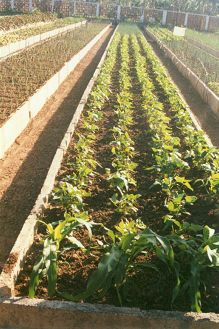
Figure 3. Urban coop garden, Pinar del Rio, Cuba
The co-op employs a master gardener to design and manage the garden to include the polycultures, rotations of crops among beds, water, compost, and mulch acquisition and application that will maximize the health of the system. Because it integrates a greater diversity of crops and habitats, this system achieves a higher level of sustainability than community gardening by individual allotment. Each household is assigned responsibility for working a section of the garden under the direction of the manager. As different crops or polyculture combinations rotate through each section, all neighbors gradually have become skilled at growing all the foods that the co-op produces. The manager arranges for extra labor when necessary, as in planting and harvesting, for compost and water from backyard ponds, and for supplemental compost from the city’s public composting enterprise.
The project design includes a number of elements not yet found in many urban gardens: hot and cold frames and nursery beds to feed transplants into the garden; glass bed covers to provide season extension; habitats for beneficials and other native species; insectaries, bird houses and trap and repellent crops for pest control; border hedges of nut and fruit bushes and trees and other perennial crops; and artistic corners in which to rest and enjoy the garden.
The neighborhood co-op provides regular shares of harvests to its members, and sells surplus produce in a market stand on site using the local county currency. Some members operate small processing enterprises to preserve co-op output for the neighborhood.
This model of urban agriculture may work in a number of locations, but many other models will be needed that are adapted to conditions of specific sites or parts of the city.
[1] Murphy, Catherine. 1999.Cultivating Havana: Urban Agriculture and Food Security in the Years of Crisis. Development Report Number 12. Food First: Institute for Food and Development Policy.http://www.foodfirst.org/pubs/devreps/dr12.pdf
[2] Ableman, Michael. “Agriculture’s Next Frontier: How Urban Farms Could Feed the World.” Center for Urban Agriculture at Fairview Gardens. 2007.http://www.fairviewgardens.org/pub_next_frontier.html
[4] Confronting Climate Change in the Northeast. Summary of a 2007 study conducted in part by the Union of Concerned Scientists.http://www.climatechoices.org/assets/documents/climatechoices/new-york_necia.pdf
[5] Two resources on water management for urban agricultural use: ftp://ftp.fao.org/docrep/FAO/011/ak003e/ak003e05.pdf; http://www.ruaf.org/sites/default/files/Chapter%209.pdf
[6] http://www.gardeningknowhow.com/urban/designing-your-container-vegetable-garden.htm
by Karl North
In Part One of this series, I proposed principles of agroecosystem design for growers to follow if agriculture is to approach sustainability in a future of declining access to the cheap energy and other inputs on which our industrialized food system relies. I said that providing for the local food needs of urban populations requires a design that integrates three overlapping categories of production systems: urban agriculture systems (many small islands of gardening in the city center), peri-urban agriculture (larger production areas on the immediate periphery), and rural agriculture (feeder farms associated with village-size population clusters in the hinterland of the city but close enough to be satellite hamlets). In Part Two I addressed four key issues — fertility, energy, water, and pest control — and the kinds of agroecosystems that might incorporate sustainable solutions.
In this month’s article I will picture the future county food system as a whole: its historical context and implications, and interdependencies among the parts that will make them most effective as an integrated system.
In future parts of this County Food Production series I will offer visions of each type of production system that incorporate as many of the sustainable design solutions from Part Two as seem applicable to each environment. Finally, I will explore aspects of policy and social organization that could facilitate the necessary transformation to a relocalized food system.
As the most ambitious part of this visioning project, the scenarios in this article and future ones carry the most risk of vulnerability and even failure due to historical contingencies that are impossible to predict and even hard to envisage at this juncture. Therefore, instead of a full-scale scenario for the county that could be misinterpreted as a plan, I will describe ideal types of urban, peri-urban, and rural systems to illustrate what might be beneficial or even necessary to feed the population of the county.
Learning from history: pre-fossil fuel food miles
How relocalized does a food economy need to be in the energy descent era? Throughout history, food security everywhere has been heavily dependent on a reliable supply of staple foods, especially starch staples like root crops, pulses (beans, peas, etc.) and grains. Our region once was self-sufficient in staples but gradually imported most of them. To regain food security, we must establish a measure of food sovereignty as local policy, especially in staple foods.
A look at NYS history is a reminder that easily conserved and transportable food commodities traveled far before the railroads existed, and to a degree even before the canal system was built.
Pre-canal overland commerce in high-value imports and industrial goods, paid for in farm products, was common across New York State. The account in Figure 1 shows the sorts of goods that flowed in both directions.[1]
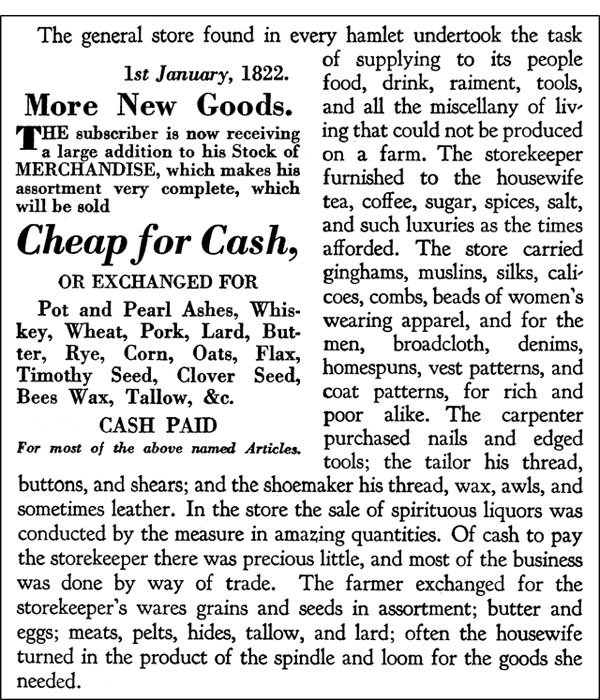
Figure 1. Goods that historically made up the bulk of
commercial trade in 19th century rural New York
By 1830 the New York canal system linked most agricultural depots of the state to waterways--the Great Lakes and lesser lakes like Lake Champlain and the Finger Lakes to the main state rivers--and thence to the population centers and to foreign trade. Figure 2 is an account of the primary commodities in the lake traffic through Buffalo in 1847 and provides a rough measure of the tonnage and kinds of foods that moved long distances in that era.[2]

Figure 2. Great Lakes traffic arriving at Buffalo, 1847
In the late 19th century the railroads took over most transport of farm products out of rural areas; even certain bulkier items that travel well like potatoes, onions, cabbage, and livestock were included in state-wide commerce and beyond.
Apart from food security, the stimulus to the local economy and the provision of fresh, superior quality food are good reasons to produce as much food locally as possible. But consideration of the above historical perspective suggests that the question of how much we need to depend on locally produced food turns on the ability of the state to promote the revival of the railroads or, failing that, at least the canal system. The existence of long-distance trade before the era of energy ascent in products like grain that travel well suggests that during energy descent widespread trade in some agricultural products will persist despite rising transport costs.
However, many energy descent analysts[3] believe that the US economy has been so undermined by internal and external debt and dependence on fossil fuels that state and federal institutions will eventually be unable to maintain the present social order, much less take on the reconstruction of pre-oil transportation networks. This scenario suggests the need for a high level of local food production. Analysis of probable futures at this macro-level clearly suffers from the uncertainty surrounding so many of the key variables. Perhaps the best insight one can draw from the records of earlier food systems is a ranking of agricultural products for localization, according to their sensitivity to a shrunken distance economy.
Even assuming the construction or restoration of energy-efficient transport networks, other concerns ultimately will force increasing dependence on locally grown food. A sustainable food system must recycle nutrients. The historical expansion of US food miles relied first on the depletion of fertile virgin soils, then on cheap fertilizer and other manufactured inputs. Without the crutch of increasingly expensive inputs, declining agricultural yields in farms distant from consumers will force large foodsheds to shrink over time. Even proposals for the reorganization of the national and global food system into bioregional systems or foodsheds larger than counties have ignored the nutrient cycling imperative, which becomes increasingly difficult as food is grown farther from where it is eaten. This raises the question of how to feed large cities in a purported Northeast foodshed and still sustain the health of the soil that grows the food.
As early as 1862, scientists were writing of a metabolic rift that had developed between city and countryside.[4] The rift was both biological and social; the nutrient cycle had broken as the nutrients that fed urbanites no longer returned to the rural lands where the food was grown, and urbanites had lost appreciation of the fact that urban prosperity ultimately depends on the health of the land and its natural systems.
The social/cultural rift may be the biggest obstacle to change. The very existence of cities depends on the accumulation of a surplus of wealth from agriculture and other raw material extraction from the land. The temporary ability of humanity to substitute fossil fuel dependent technologies for human labor and the soil fertility and other services originally supplied by natural systems created the illusion that human labor and ecological services are of little importance in agriculture, and therefore have little bearing on the question of the survival of cities. Technology, apparently an urban product, became paramount in the hierarchy of urban cultural values. In that hierarchy, technology could even replace the social capital of healthy families and communities that traditionally gave agrarian society much of its strength and resilience.
The county needs to be ready for these challenges. The limiting factor that inhibits food system change is not biophysical knowledge of how to do it, but social knowledge of the power structures that have closed down local food economies and prevented their revival. Successful strategies for change can emerge only from a deeper understanding of how things work in the system of power relations, both in the county and beyond.
A county policy framework that effectively favors local production and reverses the power shift in modern society toward centers that today exploit peripheries will ultimately improve local quality of life. In the early 19th century, before the rise of competition from the Midwest, agrarian NY communities sold to nearby cities and enjoyed a relative prosperity that reflects the true dependence of urban affluence on the wealth of the land. Recently it was estimated that in Maine, $10 a week spent on locally produced food would put $104 million into the state’s economy.[5] This suggests that a public program to relocalize the county food economy eventually could sell politically as a core element in regenerating the local economy overall.
Interdependencies in the county food system
The three types of county agriculture to be explored in this series are best suited to different, complementary roles in county food production. Taking its cue from the pattern in earlier times, urban agriculture will give priority to production of vegetables and fruits for fresh consumption that can be grown intensively, in raised beds for example. Peri-urban agriculture will supplement urban gardens with produce that requires more space, and will support some livestock. Rural agriculture will be responsible for most of the large animal production and large-scale field cropping. A high priority of farming in satellite villages will be to grow the bulk of the staples, like potatoes, oats, roots, brassicas, legumes, squash, alliums, and apples, which have proven to be dependable in cool, temperate climates. The county will need to rely mainly on outlying farms for non-food essentials as well, such as oilseeds, flax, hemp, wool, leather, and wood.
Because the agriculture of the future will need closed nutrient cycles, fertility for all county food production cannot be considered apart from county organic waste streams.[6] To maintain fertility, organic waste must return in some form to food production sites. As the dense urban population produces the bulk of the waste, public institutions will need to take responsibility for separate collection of the purely organic component of the urban garbage and sewage waste streams, recycling part of it back to rural farms.[7]
Fertility in urban and peripheral agricultural soils can be sustained with compost from the city organic garbage stream alone. A study of one urban community revealed that urban agriculture alone could absorb 20% of the organic waste production of the city.[8] This will require a municipal policy and program of careful triage, collection, and composting at optimum C/N ratio by mixing high-nitrogen food garbage with high-carbon sources like leaves and shredded paper trash. The city could assign responsibility to urban institutional sources, such as schools and restaurants for moving their large organic waste streams to composting facilities at specific peri-urban food production sites. A map of existing Tompkins County composting sites demonstrates the composting potential (Figure 3).[9]
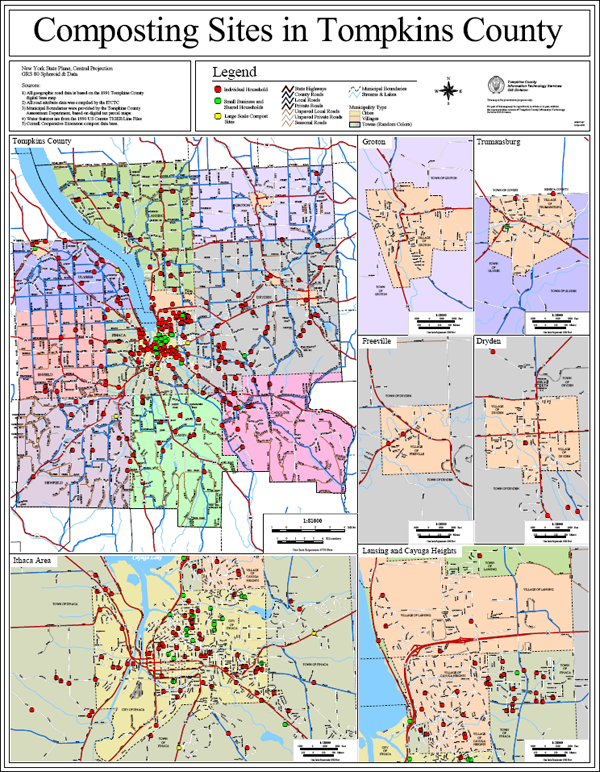
Figure 3. Composting sites in Tompkins County (click image for PDF version)
As for sewage, eventually Ithaca will have to desewer, converting to urban night soil collection, biogas extraction, and the recycling of residual organic matter to county farms that will be necessary to maintain the mineral content of rural agricultural soils. In the short run, guerilla humanure composting from backyard compost toilets can build toward full conversion (Figure 4). These household facilities are satisfactorily self-policed, because the product will be used in closed-cycle residential food production.
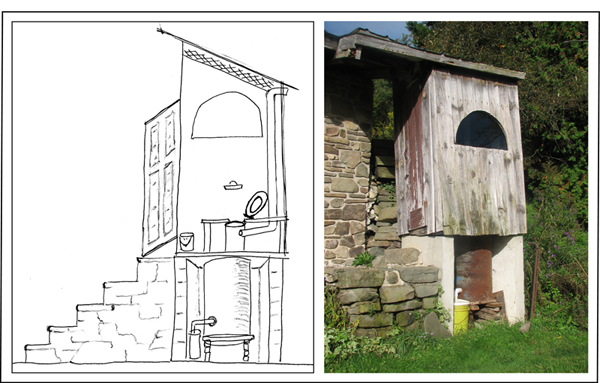
Figure 4. A functioning home-built composting toilet based on a
55 gallon drum that has been in operation in Cortland County since
1983. The drum is periodically rotated out through a composting
cycle
Conclusion
In this article, I have discussed the possibility that some of the current massive importation of the county’s food consumption could go on for decades. I pointed out serious risks to food security if this were allowed to continue, and argued that the distance economy in food causes metabolic rifts that make it ultimately unsustainable. I described in outline how a local food production system could mend the biological rift. Detailed visions of urban, peri-urban, and rural food production systems in the next articles will explain design solutions to the basic problems of fertility, energy, water supply, and pest control in specific cases of each type of production. And the reorganization of county agriculture itself will begin to address the most challenging rift, the social and cultural rift between urban and rural life.
Notes
[1] Hedrick, Ulysses Prentis. A History of Agriculture in the State of New York. Albany: New York State Agricultural Society, 1933.
[2] Ibid.
[3] Martenson, Chris. http://www.chrismartenson.com/crashcourse
Heinberg, Richard. Peak Everything: Waking Up to a Century
of Declines. Gabriola, BC : New Society Publishers, 2007.
Kunstler, James Howard. The Long Emergency. New York :
Atlantic Monthly Press, 2005.
[4] The earliest to apply the term metabolic rift to the “robbery” of country soils through the exportation of food to cities appears to have been the German chemist Justus von Liebig in the introduction to the seventh edition of his Organic Chemistry in its Application to Agriculture and Physiology. The term was later used by Karl Marx and others. See Foster, J.B., “Marx’s ecology in historical perspective,” http://pubs.socialistreviewindex.org.uk/isj96/foster.htm and Clausen, Rebecca, “Healing the Rift: Metabolic Restoration in Cuban Agriculture,” Monthly Review, May 2007.
[5] Community Food Security Coalition. “Urban Agriculture and Community Food Service in the United States: Farming from the City Center to the Urban Fringe.” FoodSecurity.org. October 2003. http://www.foodsecurity.org/PrimerCFSCUAC.pdf
[6] For information about local waste processing facilities, see the TCLocal article “Wasting in the Energy Descent: An Outline for the Future” by Tom Shelley, http://tclocal.org/2009/01/wasting_in_the_energy_descent.html
[7] Tom Shelley has recently begun to prototype this process with “The Sustainable Chicken Project,” which returns nutrients to the land by collecting kitchen scraps in the City of Ithaca on a subscription basis and feeding them to chickens at Steep Hollow Farm three miles outside the city in the Town of Ithaca. See http://www.sundancechannel.com/sunfiltered/2010/01/sustainable-chicken-project/ and the farm’s blog at http://steephollowfarm.wordpress.com/
[8]Mougeot, Luc J.A. Growing Better Cities: Urban Agriculture for Sustainable Development. Ottawa: International Development Centre, 2006. http://www.idrc.ca/openebooks/226-0/
[9] http://www.co.tompkins.ny.us/gis/maps/pdfs/CompostMap2000-E.pdf
How Planned, Localized, Sustainable Non-food Biomass Utilization Can Help Ease Energy Descent and Mitigate Global Climate Change
by Krys Cail
Introduction
This article provides a framework for considering the socio-economic structural changes that can lead to a different, more stable, and more sustainable local market for heating fuel and electrical energy.
The use of combustion for heat and power is an established and developed technology, while the successful social balancing of environmental and ecological costs with short-run economic benefit is a new, and daunting, challenge. The change, or transition, needed to use the locally available resource of non-food woody and grassy biomass to help solve current energy problems is socio-economic change, not technical innovation. We can supplant at least some current fossil fuel use with the more carbon-neutral combustion of earth surface harvested feedstocks using current technology. Nonfood biomass direct combustion[1] can be undertaken in a localized context. We can take an enlightened approach to the sustainable management of feedstock planting, growing, and harvesting, energy-efficient processing, complete and clean burning, and ash recycling. Developing such a system also offers a means of developing the alternative commercial channels necessary to move the Tompkins County area to a future of heat and energy production that is not just more environmentally friendly, but also more economically insulated, or decoupled, from the gyrations of the world oil market in a time of post-peak oil.
Other current and emerging heat and power technologies, such as solar, wind, geothermal, and small-scale hydro are “greener” forms of alternative energy and may be our future mainstays. However, in biomass-rich locations like Tompkins County, the economic attraction of biomass as an affordable substitute for fossil fuels will ensure that it will come into commercial use as oil and other energy commodities rise in price. If the development of biomass energy is controlled by the current energy industry, large energy companies will guard their market share by organizing only large-scale markets, even in situations where energy efficiency favors smaller, more localized scale. Conversely, building localized commercial structures to sell nonfood biomass-generated heat and electrical energy could feasibly provide a template for the effective investment in and commercialization of localized energy from other, greener sources in the future.
The kind of community development that allows areas the size of Tompkins County to become more energy self-reliant—”import substitution” for the energy products of the fossil fuel industry—can accomplish the twin goals of creating green jobs and modeling the kind of less global, more local commercial/economic interactions that are referred to as relocalization. Relocalization of energy provision is a necessary response to energy descent; accomplishing this using tested community development practices will ensure better success in the required transition.
The First Two Burning Transitions
Combustion (fire), used as a tool, was a major human cultural advance, and perhaps helped our species to evolve. In his recent book, Catching Fire: How Cooking Made Us Human,[2] Richard Wrangman, a Harvard University biological anthropologist, postulates that the taming of fire, and its use to cook food, was the key tool-using event that allowed human evolution to proceed from pre-human hominid to modern humankind. He postulates that cooked food allowed us to divert calories from chewing to growing larger brains.
The centrality of fire to the establishment of human society is also evidenced in religions and belief systems worldwide. One classic rendition is the myth of Prometheus, the champion of humankind who was said to have stolen fire for use by mortals from the immortal gods.
From ancient times up until the Industrial Revolution, humans used combustion sustainably, with only localized or regional instances of deforestation.[3] Early burning was carbon-neutral as far as the earth’s atmosphere was concerned.
Some primitive peoples did set massive fires. For instance, Plains Indians used prairie fires to stampede buffalo over cliffs; Tompkins County’s first peoples probably (like New England’s natives) routinely burned the forest understory to make for easier hunting access;[4] and innumerable horseback European raiders ransacked and ruined settled villages with fire—as Revolutionary War General Sullivan did here in the Finger Lakes. These combustion materials were already a part of the earth surface/atmosphere carbon exchange. In geologic/atmospheric time, even very big surface fires are just blips. The carbon released into the atmosphere would have otherwise been added shortly anyway through decomposition. It was the Industrial Revolution and the use of first coal, and then oil and natural gas, that began the process of unbalancing the planet’s atmospheric carbon load by making use of the carbon stores of former eons, previously safely buried underground. This led to both global climate change, and to the depletion of easily extractable in-ground carbon sources we speak of as peak oil and energy descent.[5]
The first “burning transition,” then, was the Prometheus transition. This transition changed humankind (if you don’t believe Richard Wrangman that it changed our evolution, you must at least concede that it drastically altered our culture). The Prometheus transition enabled the development of agriculture and led to deforestation in a few subcontinental areas But the second burning transition—and the advent of the steam and internal combustion engines of the Industrial Revolution—resulted eventually in major land and sea transformation and widespread ecosystem and climactic change. The first burning transition changed humankind, while the second burning transition changed the planet. Each burning transition also markedly changed the socio-economic systems that people used to regularize and control the commercial and familial relationships that provide us essentials such as heat in cold weather, food, and, after the second burning transition, electric power.
Planning a Third Burning Transition
Technological optimism about alternative fuel development usually focuses on replacing combustion of “dirty” fuels with combustion of “clean” fuels, while leaving the production and distribution systems for liquid and gaseous fuels and electrical power in its heritage configuration. That configuration is controlled by some of the most powerful international corporations on earth—oil and gas developing, refining and shipping companies, electrical utilities, and coal-mining and shipping companies. These actors have a vested interest in seeing that the socio-economic systems of the future do not deviate too much from those of the past, ensuring these corporations continued market share. Is that to our advantage?
Is the needed change limited to a substitution of one fuel for another, one feedstock for another, or one power source for another, with no substantive change to social, industrial, political, or economic institutions? Or is a more substantive transition needed? Will social and economic change follow technology, or will we invent and popularize only the technologies our social and economic systems predispose us to aim toward?
“Local planning for sustainable use of local resources” is the basis of egalitarian post-colonial social and economic development. It is also the key to the development of a third, socioeconomic/cultural burning transition. Rather than assume an international market in energy as a given and hope for technological fixes, we should focus in the third burning transition on the relocalization of systems of sourcing, producing, and distributing heat and power. In that context, the on-going technological development can be decoupled from the economic fortunes of transnational corporations that are difficult to call to account on environmental effects in any particular place. A different kind of optimism about confronting the challenges of global climate change and peak oil can be envisioned, one in which the needed change in socio-economic structures is the direct goal, in order to accomplish the most efficient and environmentally-sound use of energy within current technological and environmental limits. This might then be followed by additional technological advancement, as needed and affordable—perhaps even a Solar or Geothermal transition that makes burning itself unnecessary. However, those possibilities are too far away for a complete transition right now, and right now is when global climate change must be addressed. Rather than trust humanity’s on-going scientific and technological innovation to “come up with something” that will make unfettered world markets in energy able to function within environmental limits, this optimism postulates that human communities can learn to balance their own energy needs with the sustainability of their own environments through socio-economic or socio-political progress.
The third burning transition is, in essence, a relocalization of energy production and an implementation of the household and commercial structures needed to manage more local production and consumption of energy, one that brings the source and use points of energy geographically closer together. This is a transition that requires no new or special technological development, but rather advancements in business form development and industrial design, including business and consumer combustion equipment and new approaches to the design of district heating and electrical power grids.
The Need for a Local Approach
Localities differ in what kind of resources they have available to produce heat and power. Thus far, most research and development in the area of biomass use as an alternative energy feedstock has used a non-localized model. Raw biomass is generally first converted into liquid fuel (both corn-based and cellulosic ethanol are liquid fuels), and then distributed via pipeline, tanker, and tanker truck, similar to petroleum. Or, alternatively, biomass is burned directly, but the resulting heat is made into electric energy and distributed far and wide on the electric grid. Both of these models contain large distributional inefficiencies.[6]
Government subsidies for one form of fuel over another can have unforeseen effects. Often, governments subsidize use of “cleaner” or more carbon-neutral fuels or combustion equipment via a direct consumer subsidy, such as a tax credit, or an indirect subsidy, such as a producer tax break or capital investment in production plant and equipment. Corn ethanol—an alternative fuel that even its promoters are now seeing as a “transitional” alternative fuel—is an example of how governmental enthusiasm for jobs, plant, and equipment in every legislator’s district can result in a glut of relatively expensive alternative fuel production in remote areas, with little hope of export at a profit in the face of price variation in the oil markets, where the product competes directly.
Some European governments have backed the development of small-scale solid-fuel biomass combustion, from pellet stoves to wood-chip furnaces to multi-fuel-burning combustion units and ultra-efficient gasification boilers that power electric generators as well as district heating grids. While this has led to much more widespread adoption of the technologies than in the US, there are still some perverse global-market effects. The governmental support for wood pellet burning in Northern Europe (direct consumer subsidies for pellet stoves, for instance) has resulted in the US market for wood pellets being significantly impacted by European demand: shortages of wood pellets in both the US and Europe in recent years have been blamed, in part, on the fact that most wood pellets produced in the US are shipped, under contract, to Europe, rather than available for growing domestic use.[7] If the domestic demand for wood pellets rises because fuel oil rises significantly in price, manufacturers can’t satisfy it, and resulting shortages drive up wood pellet prices in tandem with fuel oil prices.
Government support for the development of green energy is surely needed. But, as illustrated above, direct support for particular technologies can have perverse outcomes, when, in the real world, the variable and uncontrollable price of oil interferes with orderly marketing of the product as a substitute for the fuel and power sources people are accustomed to using. For that reason, localized community-controlled energy development for heat and electricity is preferable, as it can reasonably allow a community or geographic region to claim its own energy resources and begin to decouple its energy costs from the world oil market. In addition, as is the case with consumers developing commercial relationships with their local farmers, a measure of consumer loyalty and flexibility can be gained by localizing the transaction.
Local Resources: Prime Determinant of Appropriate Combustion Feedstocks
The third burning transition will look different in different locations. Relocalization offers the opportunity for each region or locality to assess what underutilized or sustainably developable resources it possesses, as well as what market power its heat and energy consumers represent. The skills and resources of local people must be accounted for, as well as underutilized natural resources and plant and equipment in the built environment. This assessment of resources can be done as a part of a tried and true methodology of community and economic development—Asset-based Community Development.[8] An asset-based approach to community development allows for customizing programmatic goals to highlight natural resources, human capital agglomerations, and other local conditions that will make one form of biomass more feasible to use as a feedstock for combustion than another.
The local foods movement has made some use of the phrase “Eat your landscape.” The idea is that, by engaging in an ongoing direct involvement in growing food (gardening or CSA working membership) or direct-from-the-local-farmer commercial interaction with a manager of food producing lands in your locale (“landscape”), one can exercise, in common with one’s neighbors, some influence over what kind of a landscape it is now and in future. The goal is use that is environmentally sound, sustainable, and provides a living wage to those who manage and work the land.
A similar approach can be taken to the orderly and sustainable harvest and cultivation of biomass for combustion in place of oil, gas, and, especially, coal. Although these fuel substitutions are not the ultimate long-term solutions to our energy problems, they do offer us a mechanism for developing the distributed, local commercial interactions that can and will set the stage for the development of more long-term sustainable energy systems. In much of Tompkins County, for instance, woody and grassy biomass may be available for use as a combustion fuel, but the commercial infrastructure to sustainably and profitably grow, harvest, and process that biomass needs to be developed. Without a community development effort in this area, woodlands and pastures in Tompkins County will continue to fall into an unused and unmanaged condition that does not allow for optimum carbon sequestration and invasive plant control and does not support the development of local energy and green jobs.
In Tompkins County, most of the underutilized resource is privately owned forested or pasture/hay land that is minimally managed and, in some cases, is becoming overgrown with invasive brush species. The following chart shows the acreage of various types of landcover in the county.

The accompanying map shows a pattern of land use that conforms to topography: the northern portion of the county, which is composed of flatter land and relatively more of the better soils for agricultural use, has a greater percentage of acreage in cultivated cropland and pasture, while the southern, hillier portion of the County is more densely wooded.
Organizing for Local Energy Production and Consumption of Biomass
“Eat your landscape” implies sustainability. A bountiful landscape might continue to provide food over decades, centuries, even millennia if it were properly managed and husbanded. “Burn your landscape” has none of the overtones of sustainability—it seems, rather, cataclysmic: a landscape devoid of living things.
There are other options, however. An actively managed forest or hayfield can continue to produce biomass for combustion purposes over a long period of time if attention to the ecosystem allows for the return of depleted soil nutrients through ash spreading and the building of fertility through support of various plant and animal communities. Woodlands actively managed for sustainable harvest of woody biomass could provide plant and animal habitat, sequester carbon, and produce some hardwood lumber as well. The key here is the way in which natural resource lands are managed. Under some systems of management, carbon sequestration and selection to impede the advance of invasive species are optimized, creating a forest that is more hospitable to native flora and fauna and more able to ameliorate the excess atmospheric carbon than the previous unmanaged woodland. However, such management systems are not the most economically viable under current market structures.
Current economic structures, if left unchecked, could cause cataclysmic environmental damage as harvested biomass becomes less costly than oil. Clear-cutting woodlands, while devastating to natural communities and water quality, is the cheap way to amass a large tonnage of biomass in an area like Tompkins County. Utility companies buy wood-chip tonnage to co-fire with coal from low bidders, developing an industry built around mechanized, invasive forest destruction. Environmental regulation has proven to be a weak tool for controlling industries that have a market incentive to use forests or grasslands as a short-term, rather than permanent, resource. An example is the Catalyst Energy/Treesource Solutions biomass aggregation facility in nearby Burdett, Schuyler County, which is offering loggers one low price for biomass tonnage to be used as wood chips to heat and power the US Salt plant in Watkins Glen.
On an individual scale, landowners who use firewood for heat are likely to take the long view of their investment in their land and do their best to manage their woods to maintain sustained production as well as multi-functionality (use of the woodlands for additional purposes, such as wildlife habitat, hunting, nature appreciation, privacy). When surveyed, owners of rural acreage in Tompkins County were amenable to seeing their underutilized parcels of land produce an income stream—but very few had either time or capital to devote to this.[9]
Several local initiatives in Tompkins County have sprung up to test structures that might become a part of a third burning transition here. In the Town of Danby, landowners have come together to market the biomass from their properties (as well as potentially other land-based products) as a group. This organization of owners of fallow fields and under-managed woodlots is based on the producer-coop configuration that has been successful in some agricultural areas.[10]
Another effort, spearheaded by Anthony Nekut, is intended to draw together investors and entrepreneurs with the purpose of developing a medium-scale pellet production facility in the county. Tony would like such a plant to have the capacity to palletize both woody and grassy biomass, and he envisions both local sourcing of biomass and local sales of pellets for home and business heating. [An article by Tony is scheduled for future publication on tclocal.org.—Ed.]
A third approach to using biomass to supplant some of the fossil fuels used for home heating in Tompkins County is Abbot Development’s initiative to develop Cornell University workforce housing on a Danish-style district heating model, with a combined heat and power plant as an integral feature of the development. This plan is currently in concept development stage, but it could easily be implemented if chosen by Cornell as the model for their new housing development. Again, the technology is available and ready to use; it is the commercial market structures that require some developmental attention to establish such a project in this country.
A fourth local project focuses on commercial combined heat and power along with a managed woody-biomass plantation scheme: RPM Ecosystems, a Dryden company involved in the production of fast-growing nursery stock for reforestation projects worldwide, has worked with Congressman Michael Arcuri to obtain federal funding for a demonstration project. The project involves a wood-fired combined heat and power plant that would provide heat for the greenhouses and offices of the nursery along with sufficient electrical power to operate the facility. Additionally, plantations of RPM Ecosystems trees would be established with a goal of producing some biomass along with some hardwood lumber while maximizing forest canopy (and carbon sequestration) throughout the growth and development of the tree farm.
One approach that is not currently in evidence in Tompkins County, but might be worth investigating, is the “CSE.” CSE stands for “Community Supported Energy,” and it is modeled on the successful CSA (Community Supported Agriculture) structure. This is something of a consumer cooperative: energy consumers that would like to use local resources to produce energy band together, and, through pooling investment funds, establish critical mass to bring a production facility on-line, which they pledge to support through their energy purchases. This model was first promoted by environmental advocate Greg Pahl, and has been tried with some success in Vermont.[11]
Conclusion
The above examples merely scratch the surface of possible structures for relocalizing our heat and energy markets. And the traditional approach should not be ignored, either: use of cordwood for home and business heating has increased markedly as fossil fuel prices increase and can be expected to continue to increase, particularly in rural areas of the county. More people now make a main business or a profitable sideline of harvesting firewood, or buy less fossil fuel because they harvest some firewood for their own use. Several local retail outlets and service businesses sell and/or install combustion equipment, and technology refinements have made cordwood burning cleaner and more efficient than it was in the past.
A third burning transition—based on community development and economic innovation—is needed if we are to avoid the worst potential effects of global climate change and post-peak-oil economic instability. In the first burning transition, fire changed humankind; in the second, humankind using fire changed the world until disaster threatened. In the third burning transition, humankind must organize new structures of production and exchange to socially contain the power that unlimited individual fire-use unleashes on the world, to protect both the species and the environment on which it depends. In the future, the structures so organized can be again transformed, in a fourth burning transition, to non-carbon-based feedstocks such as the sun’s direct energy, geothermal heat, and wind and wave energy.
Notes
[1] “Direct combustion” refers to biomass burned as a solid fuel, not a liquid or gas fuel product or fuel additive.
[2] New York: Basic Books, 2009.
[3] Localized or regional deforestation should not be underestimated in its capacity to decimate human, animal, and plant communities, including driving some species to extinction. It does not, however, represent a pattern of world-wide changes, despite its severe impact on circumscribed areas.
[4] Cronon, William. Changes in the Land, Revised Edition: Indians, Colonists, and the Ecology of New England. New York: Hill and Wang, 1983.
[5] Biomass/ethanol/biodiesel schemes dependent upon intensively cultivated food crops like soy or corn fail to break the connection between the oil market and alternative fuel if a system of petro-chemical input dependent agriculture is used. They also raise grave ethical concerns, commonly referred to as the “food-fuel controversy.”
[6] While current average distributional losses for electrical energy are in the range of seven percent, biomass resources, like solar resources, may be located at a greater distance from urbanized areas than existing power plants, resulting in even larger distributional losses or larger amounts of transportation energy to move the raw material closer to the point of use.
[7] More on the international market volatility of wood pellets is available in the Renewable Energy World magazine article “Time for Stability: An Update on International Wood Pellet Markets,” Feb. 4, 2008. Available at http://www.renewableenergyworld.com/rea/news/article/2008/02/time-for-stability-an-update-on-international-wood-pellet-markets-51584
[8] See The Asset-based Community Development Institute at http://www.abcdinstitute.org/ or Wikipedia on Asset-based Community Development at http://en.wikipedia.org/wiki/Asset-Based_Community_Development
[9] Cail, Krys. Tompkins County Landowners Survey. Report for Cornell Cooperative Extension of Tompkins County on the results of a mail survey of owners of large parcels of rural land in Tompkins County undertaken by the Green Cities class of Cornell University’s City and Regional Planning Department in 2005.
[10] Begun as a project for Elizabeth Keokosky’s masters degree in City and Regional Planning at Cornell University, this initiative has progressed to the point of establishing a local steering committee and is in the process of drawing up incorporation documents.
[11] Pahl, Greg. The Citizen-powered Energy Handbook: Community Solutions to a Global Crisis. White River Junction, Vt.: Chelsea Green Publishing, March 2007. See also Renewable Energy World magazine, “Community-supported Energy Offers a Third Way,” Greg Pahl, March 12, 2007. Available at http://www.renewableenergyworld.com/rea/news/article/2007/03/community-supported-energy-offers-a-third-way-47700
